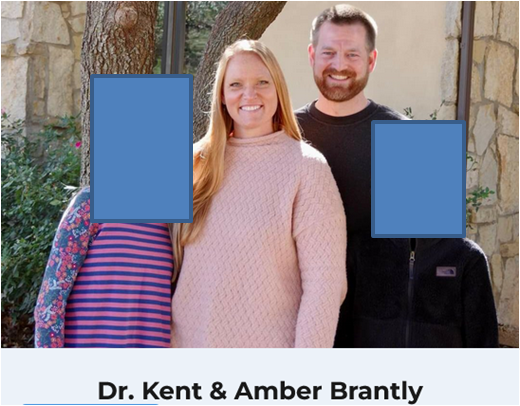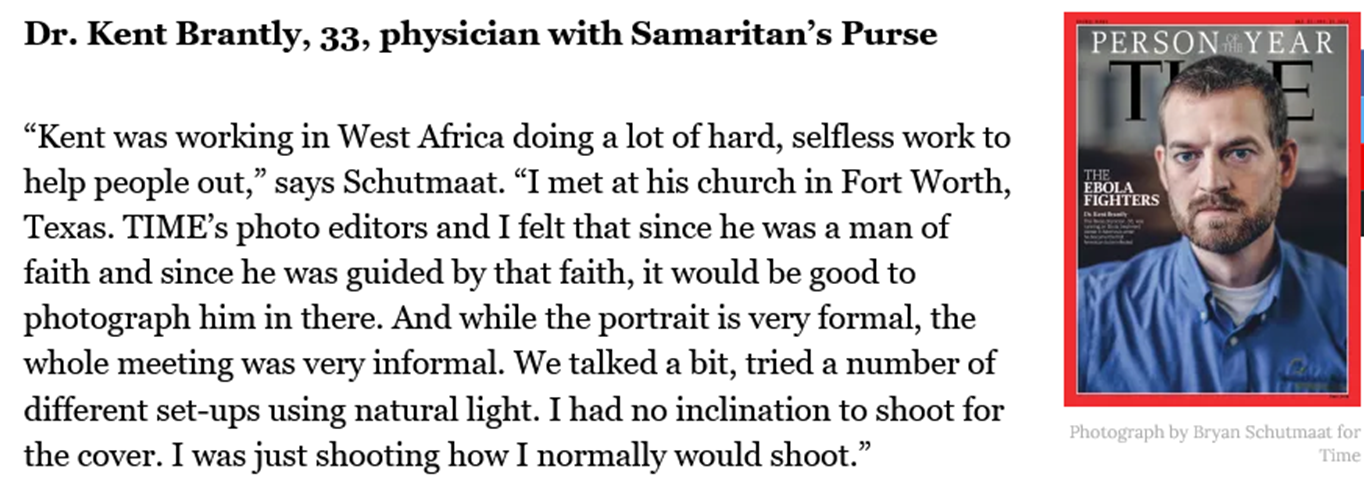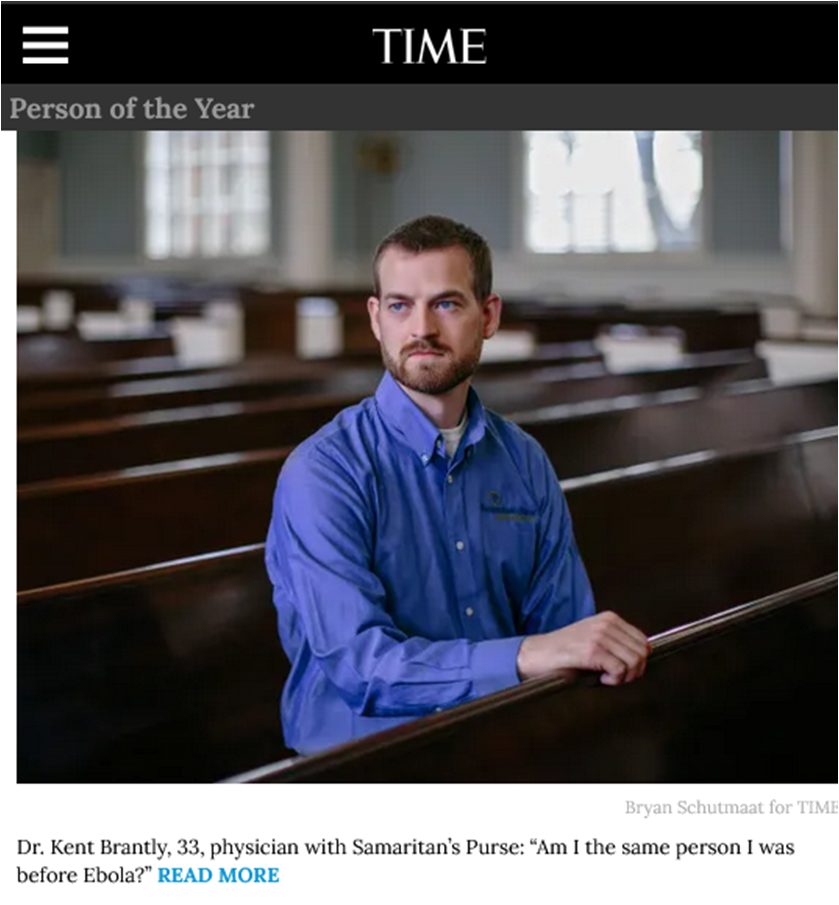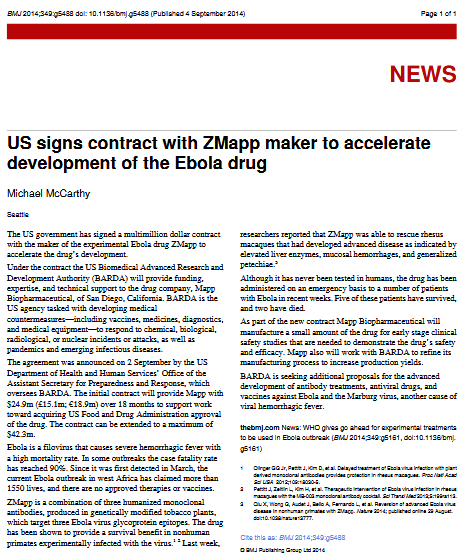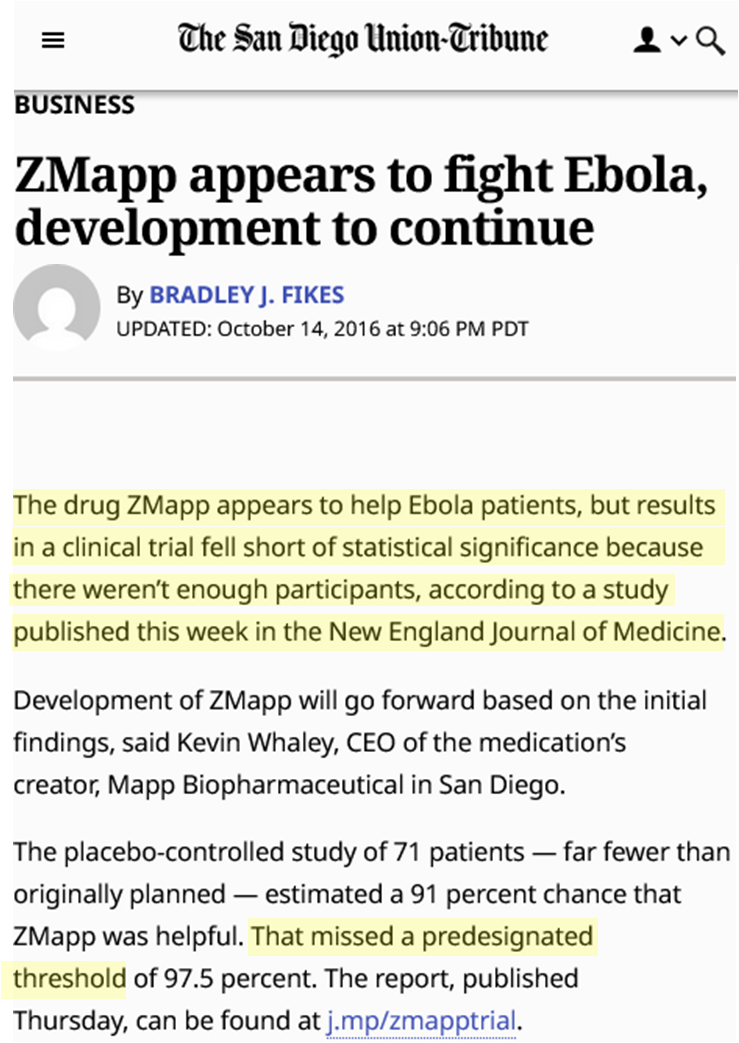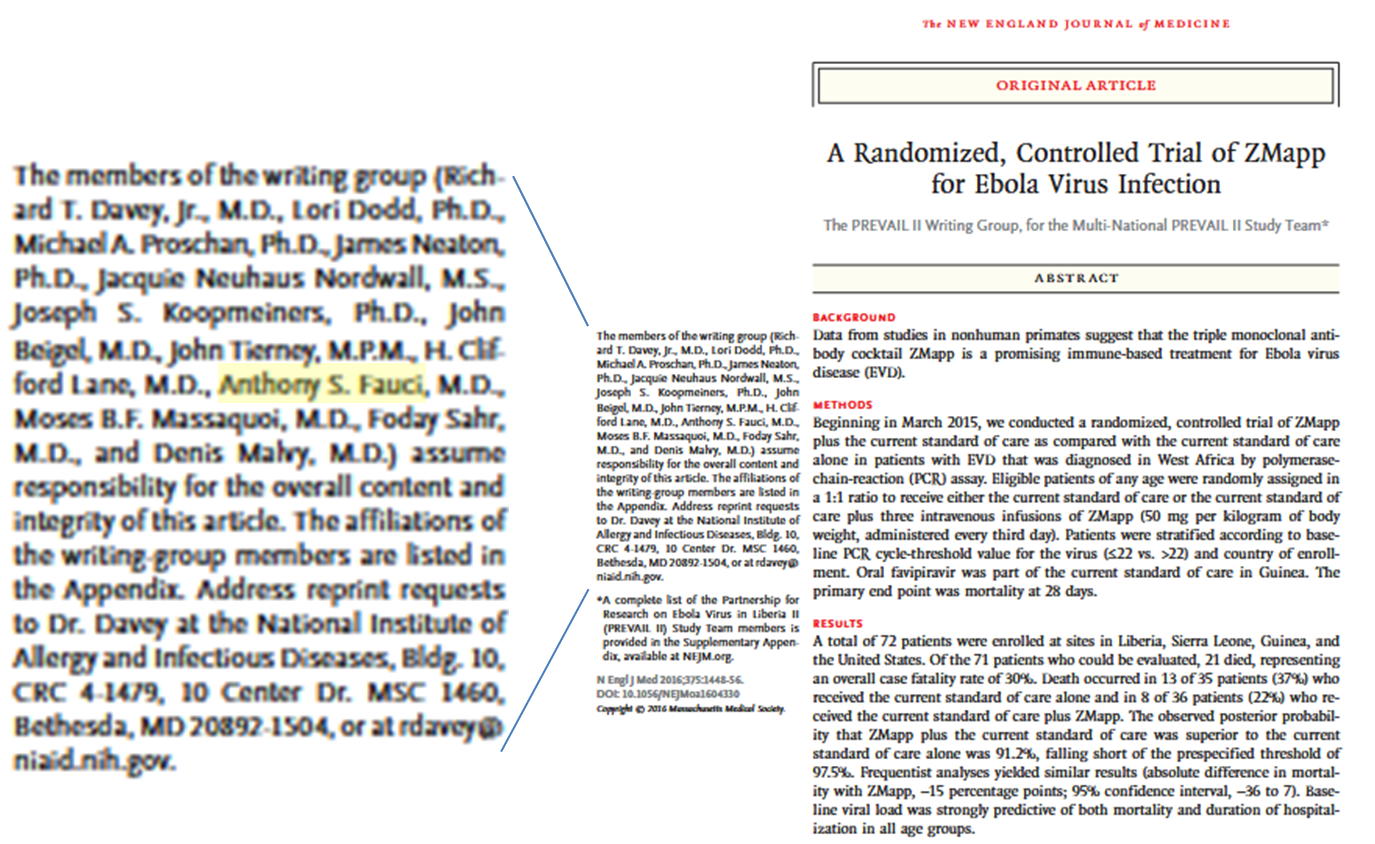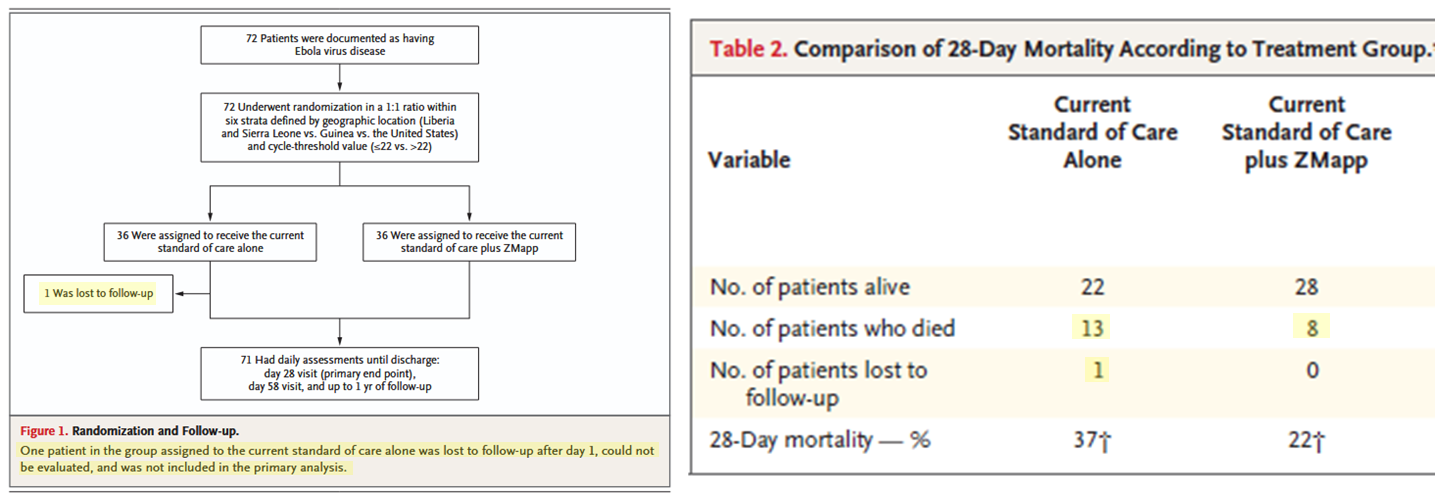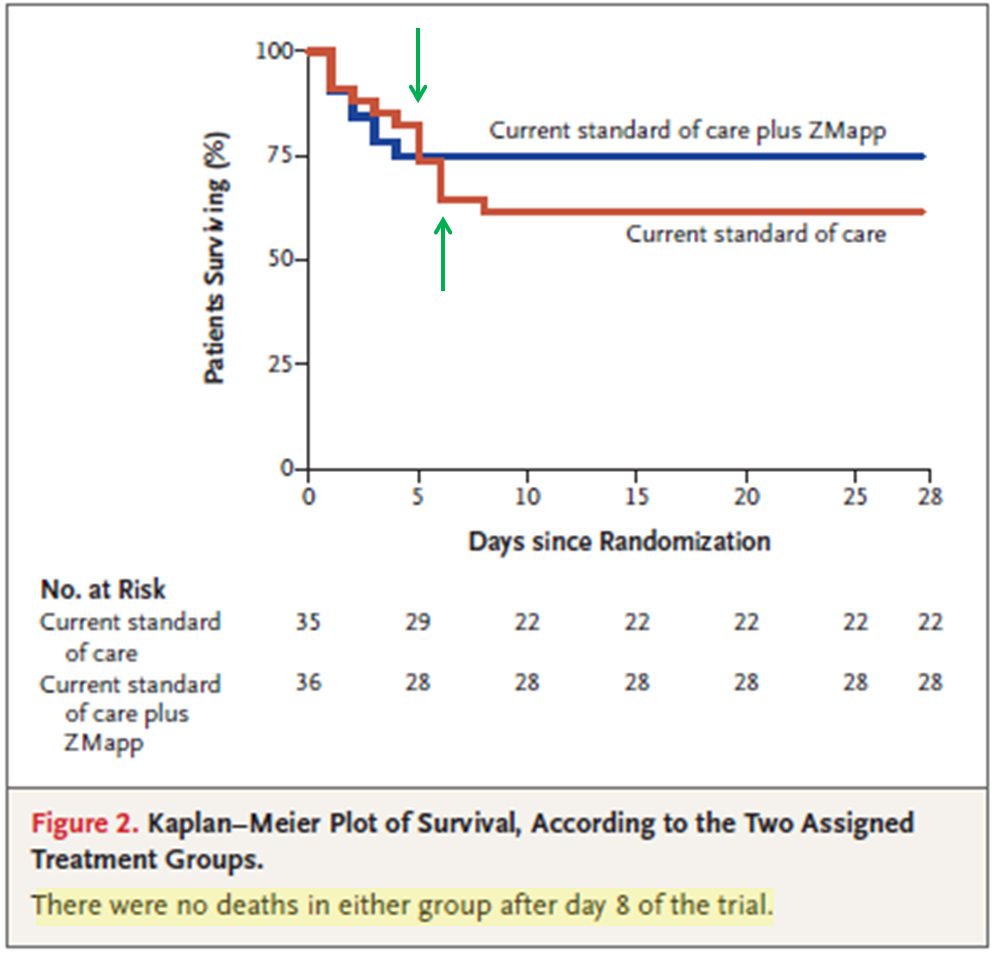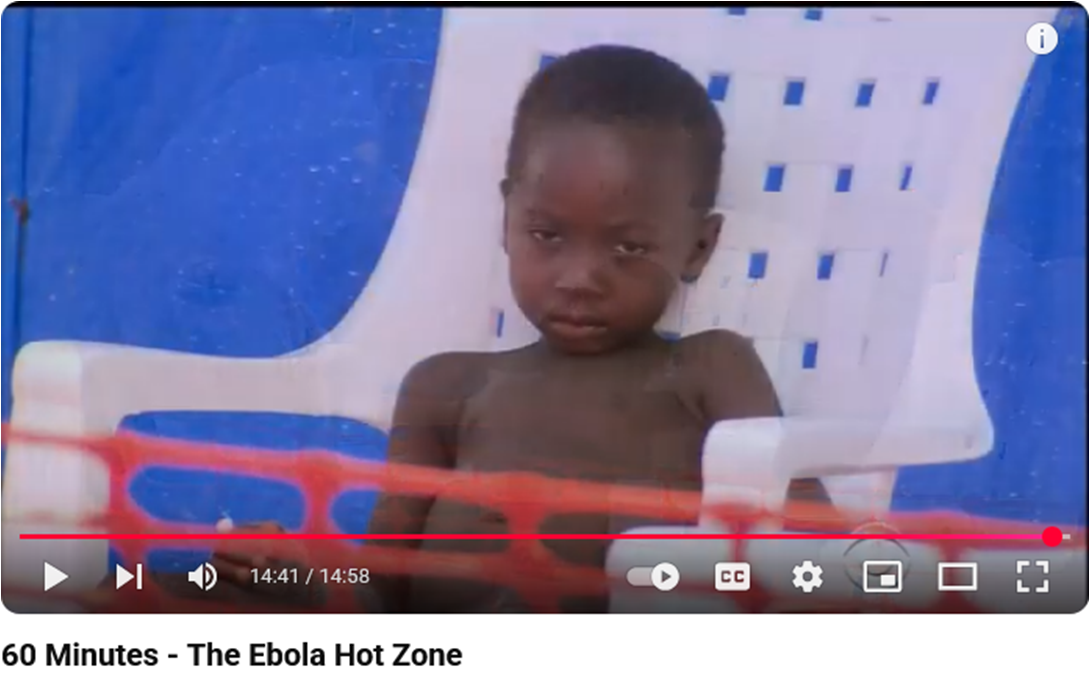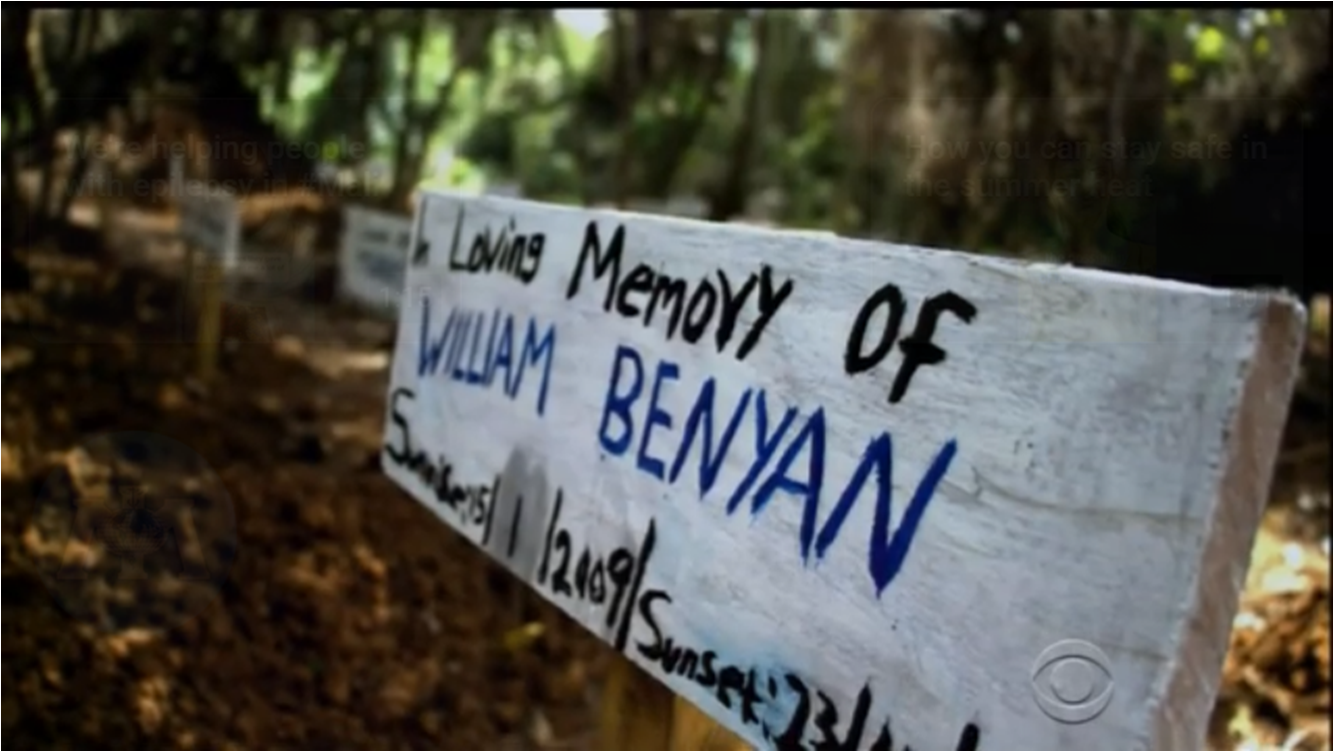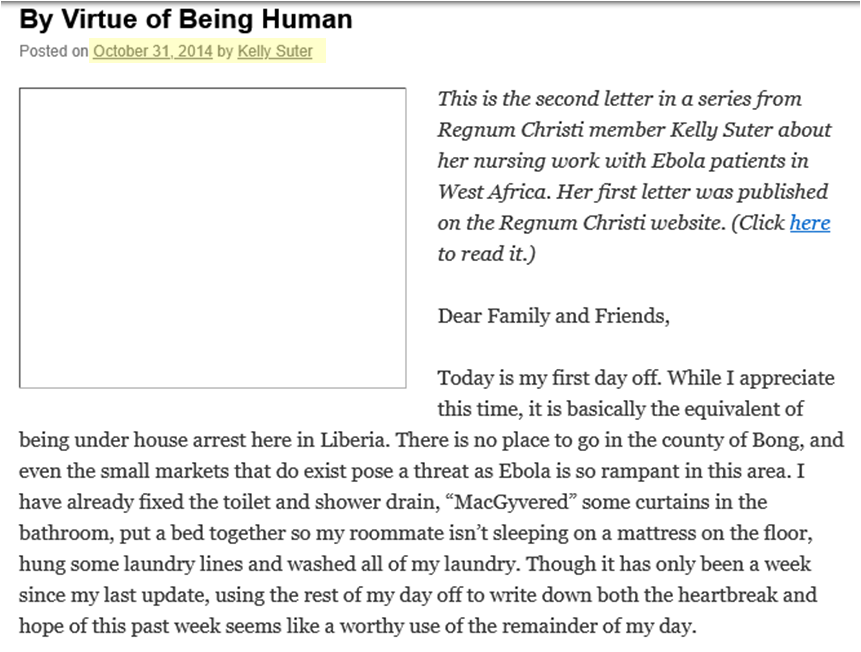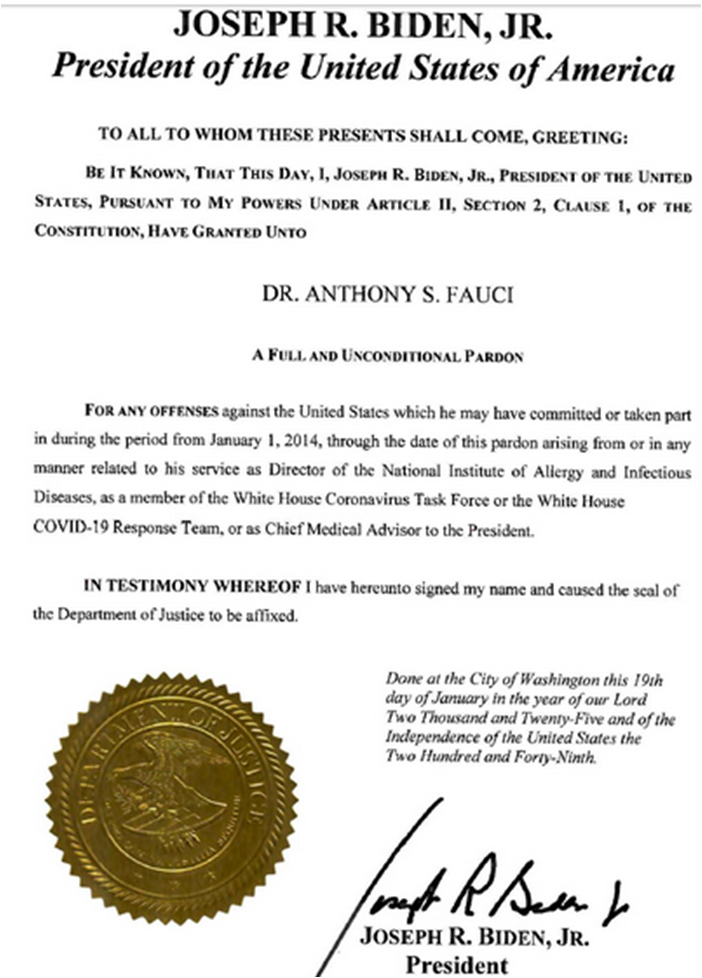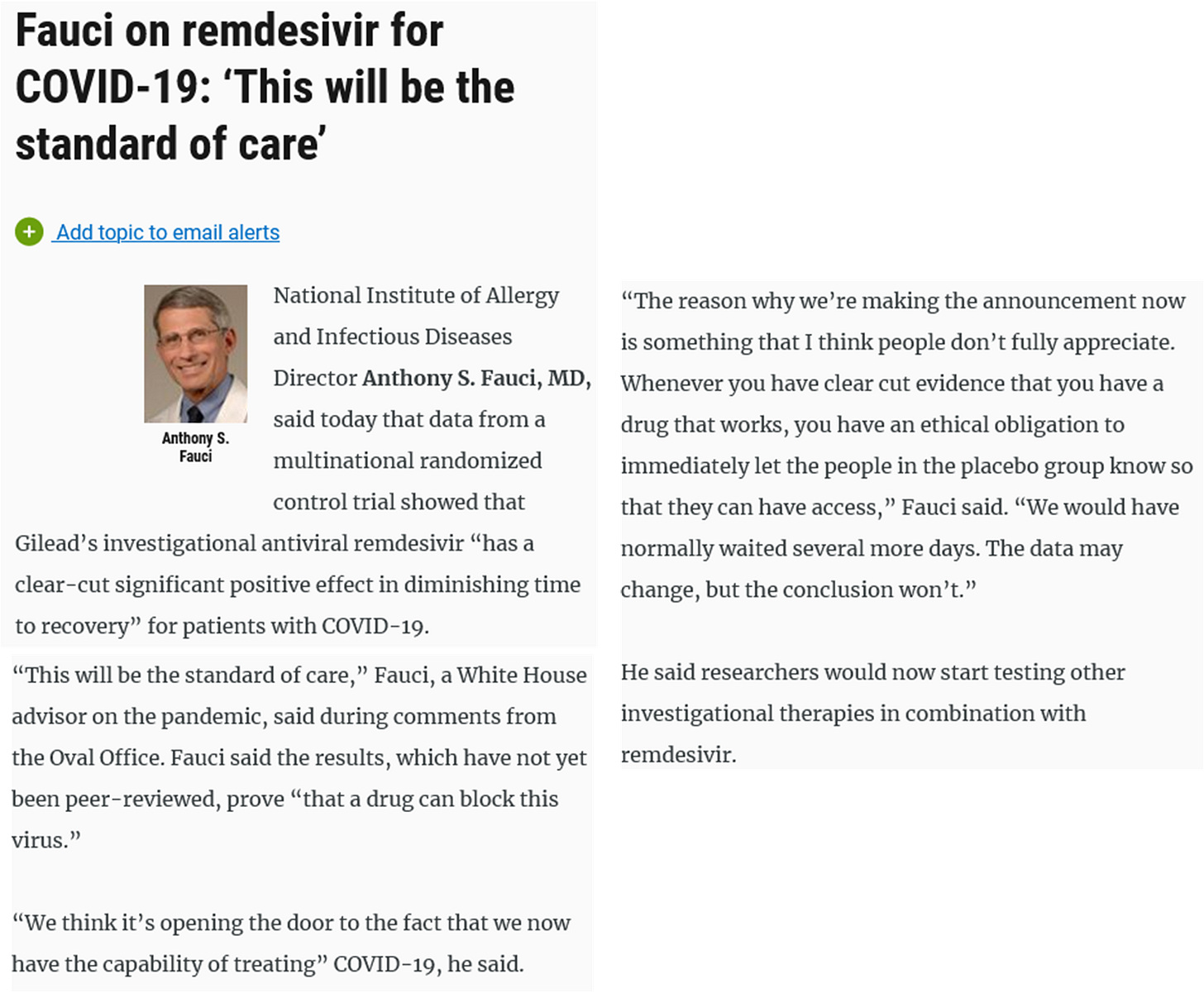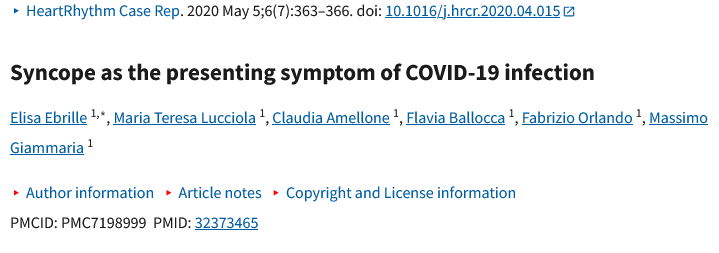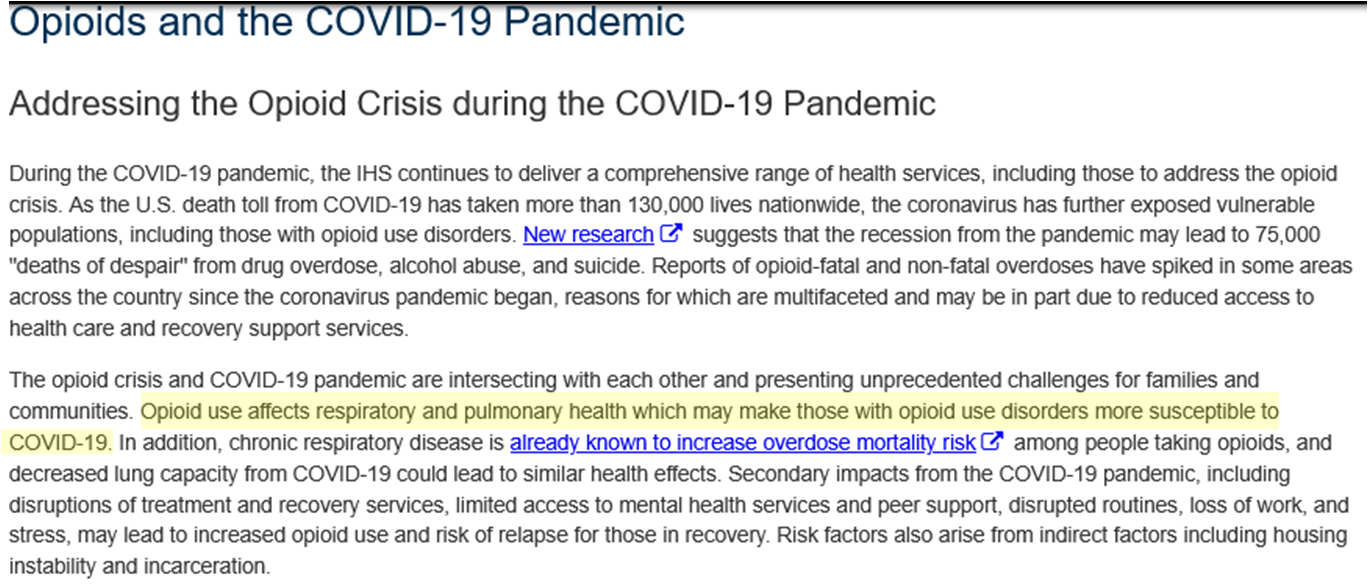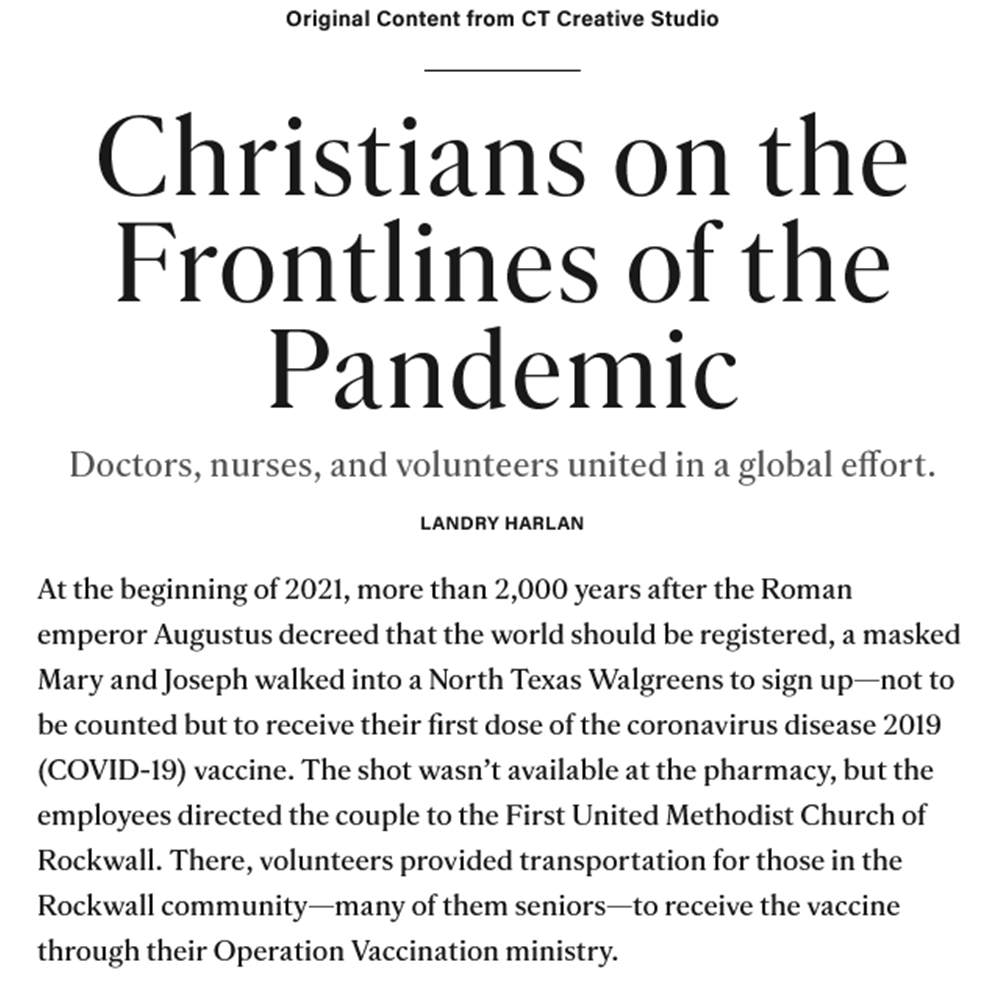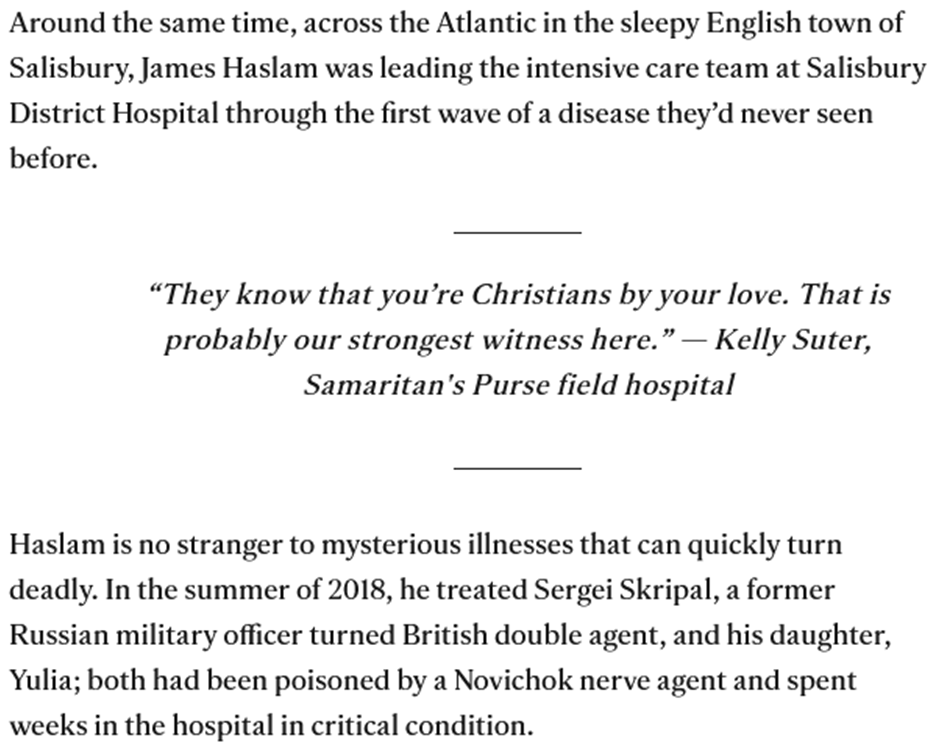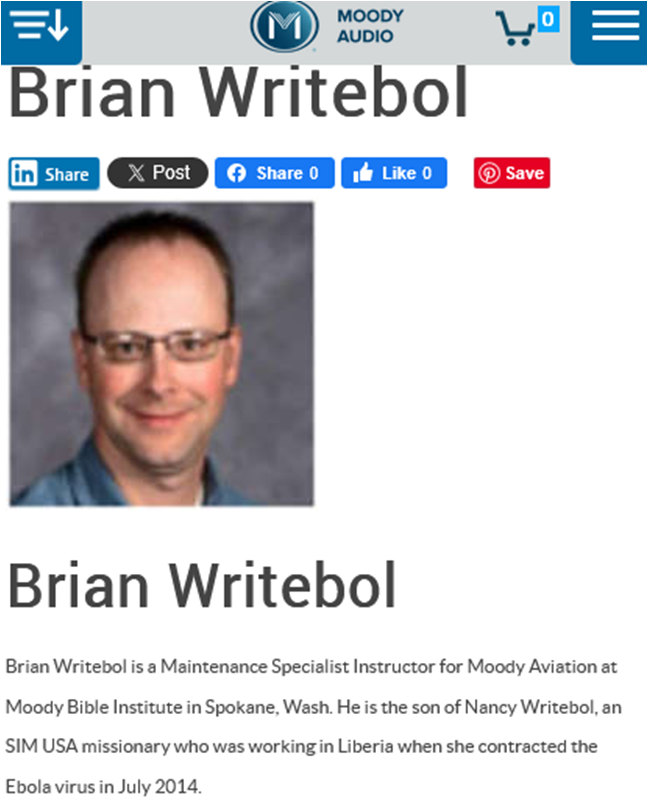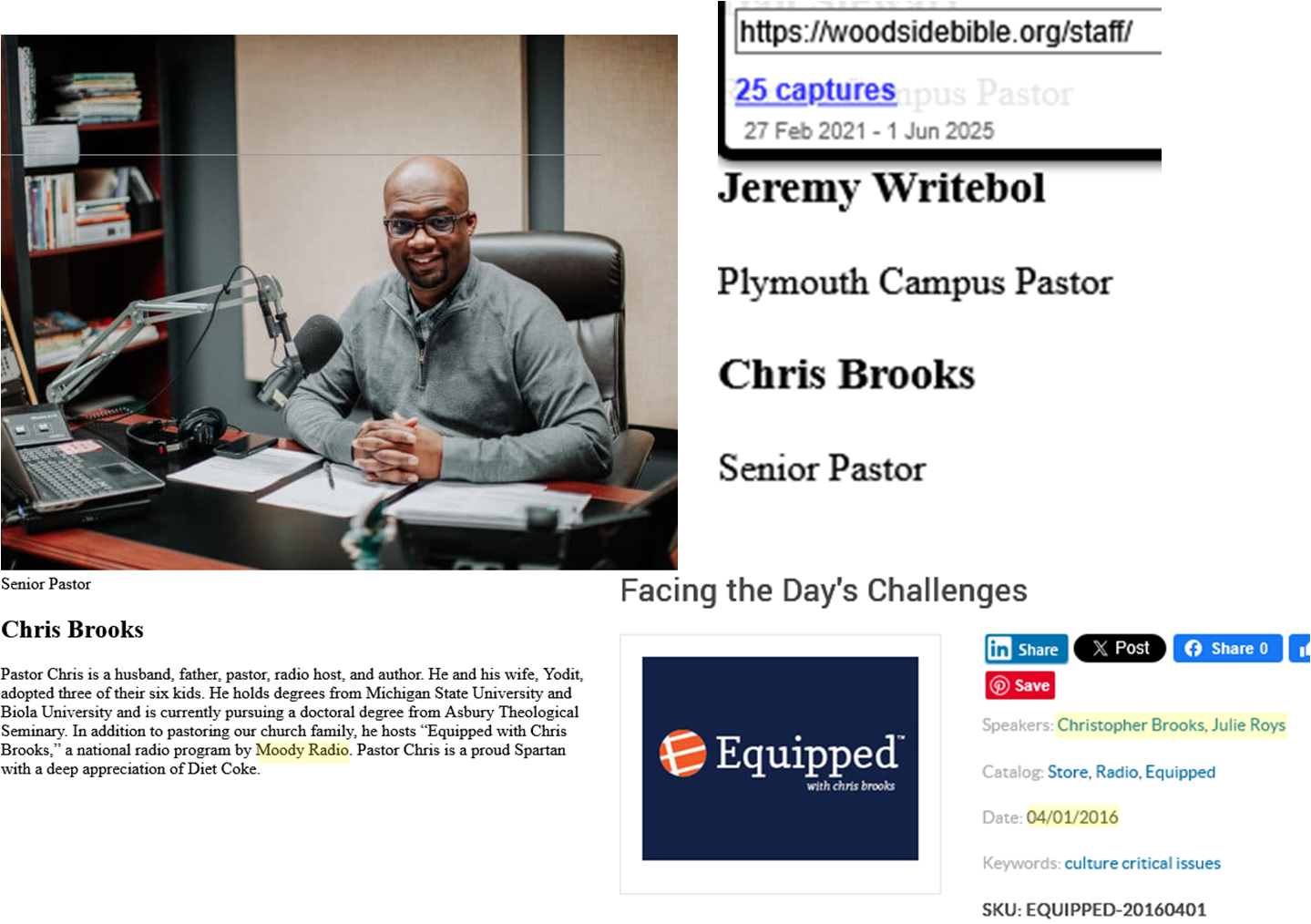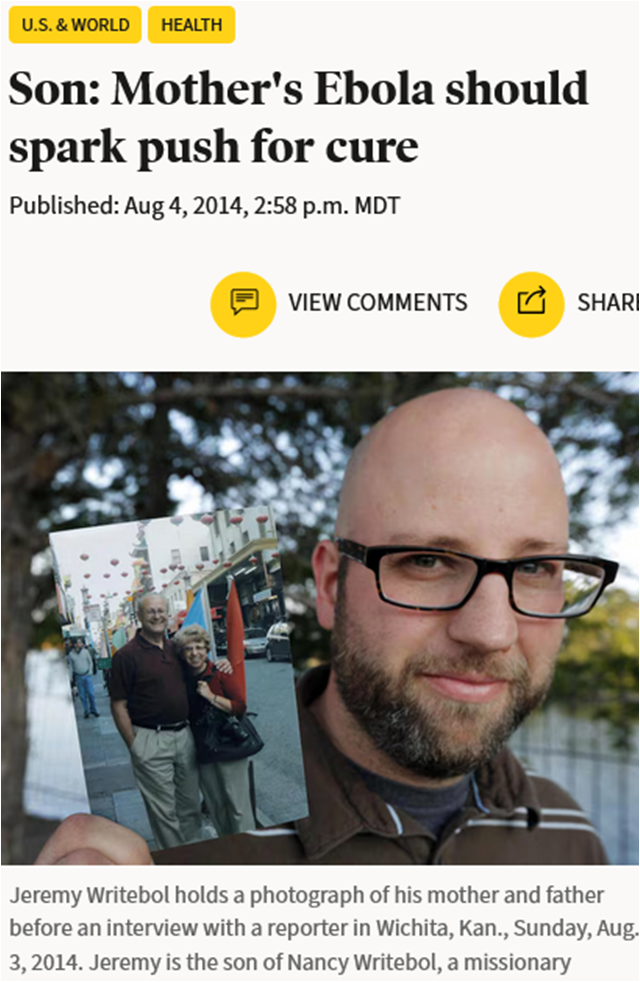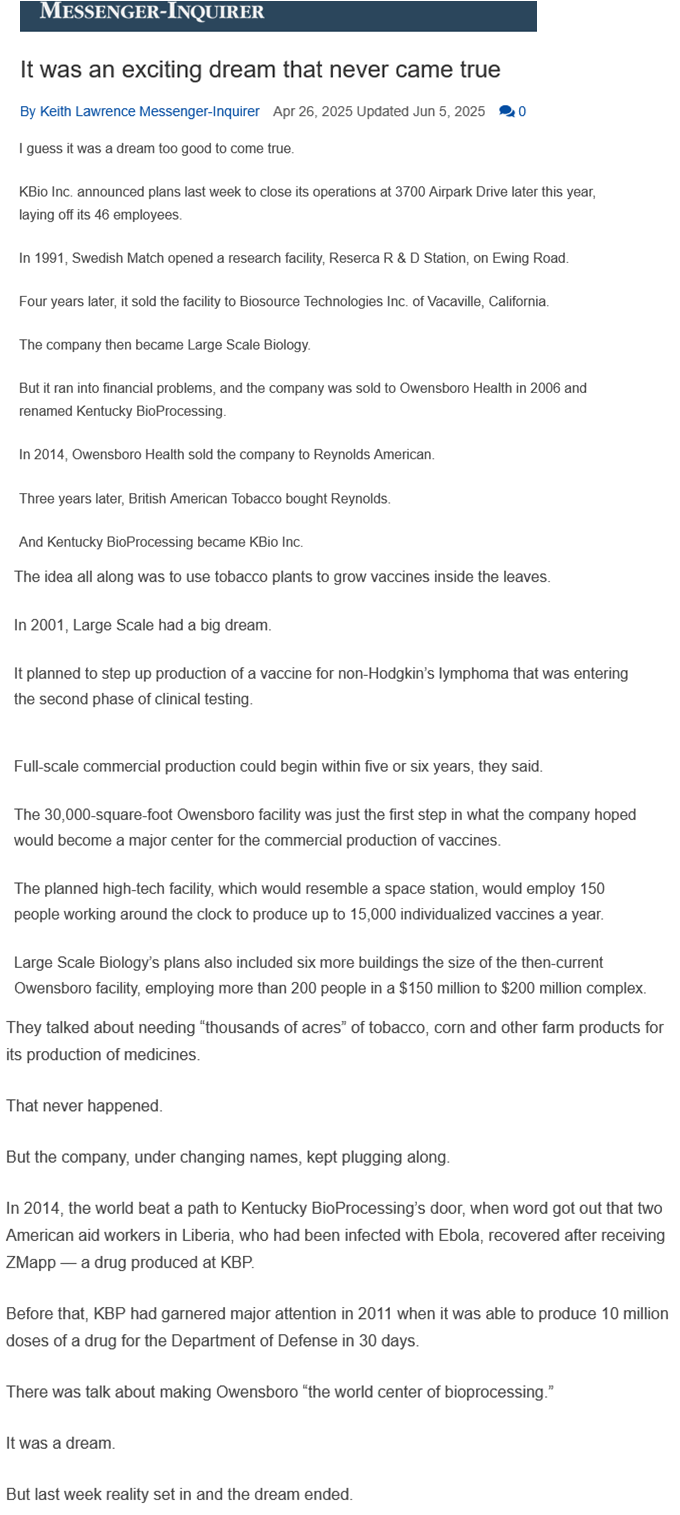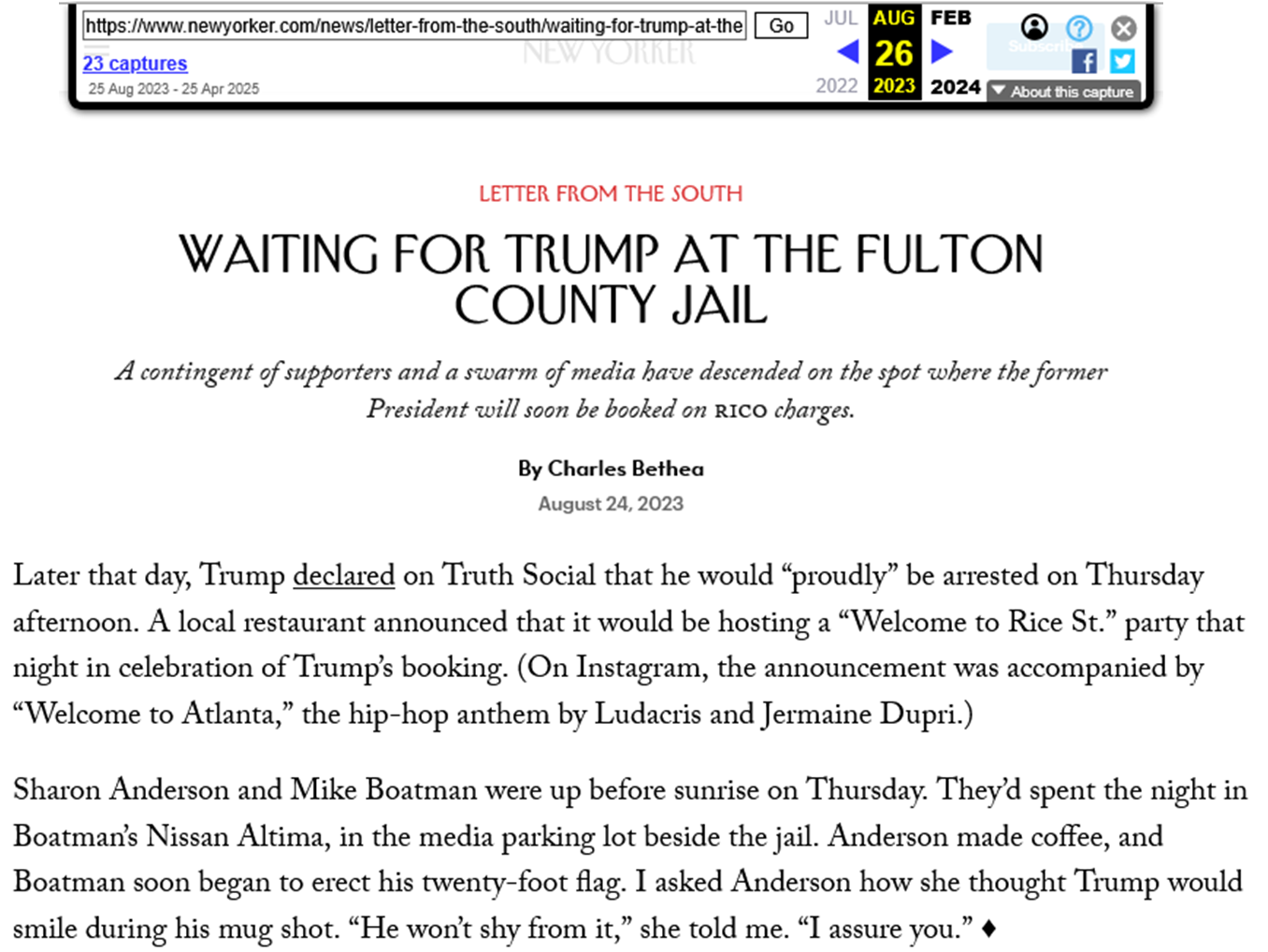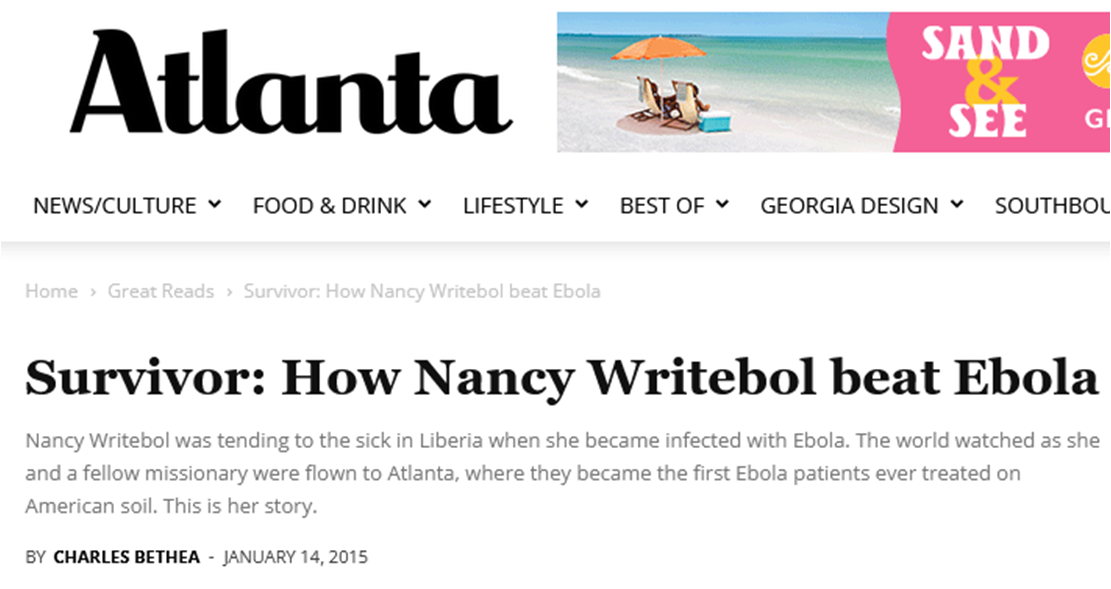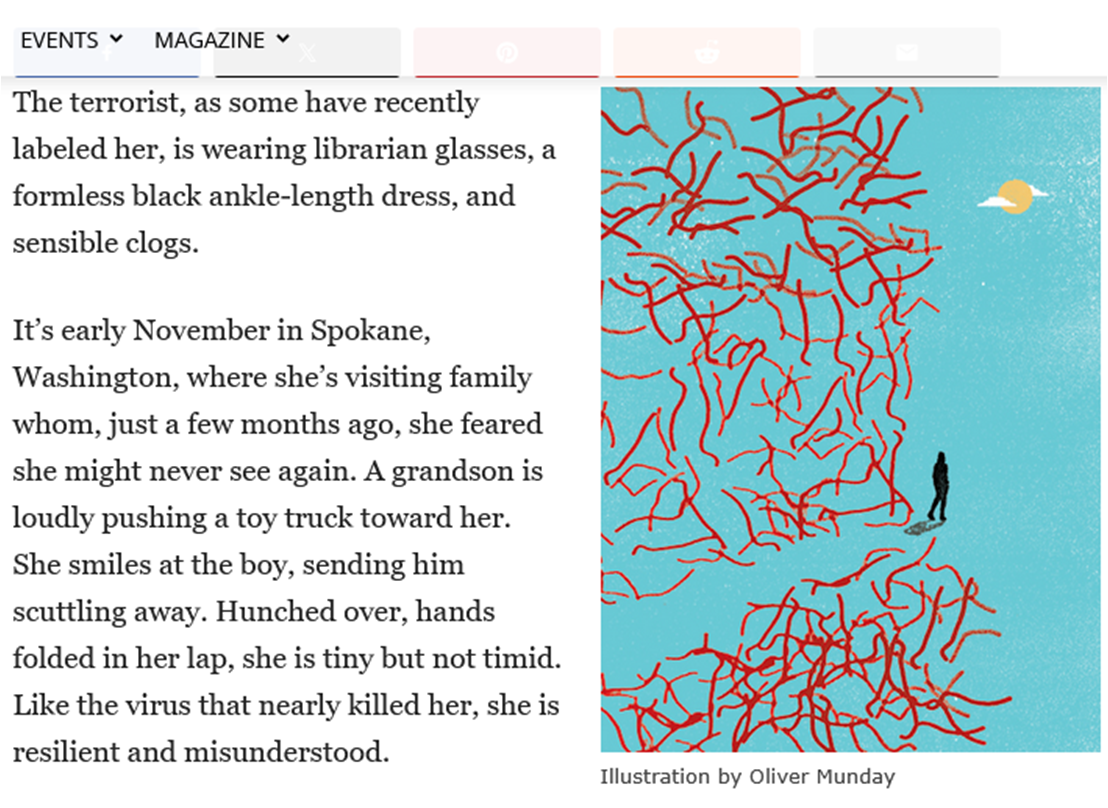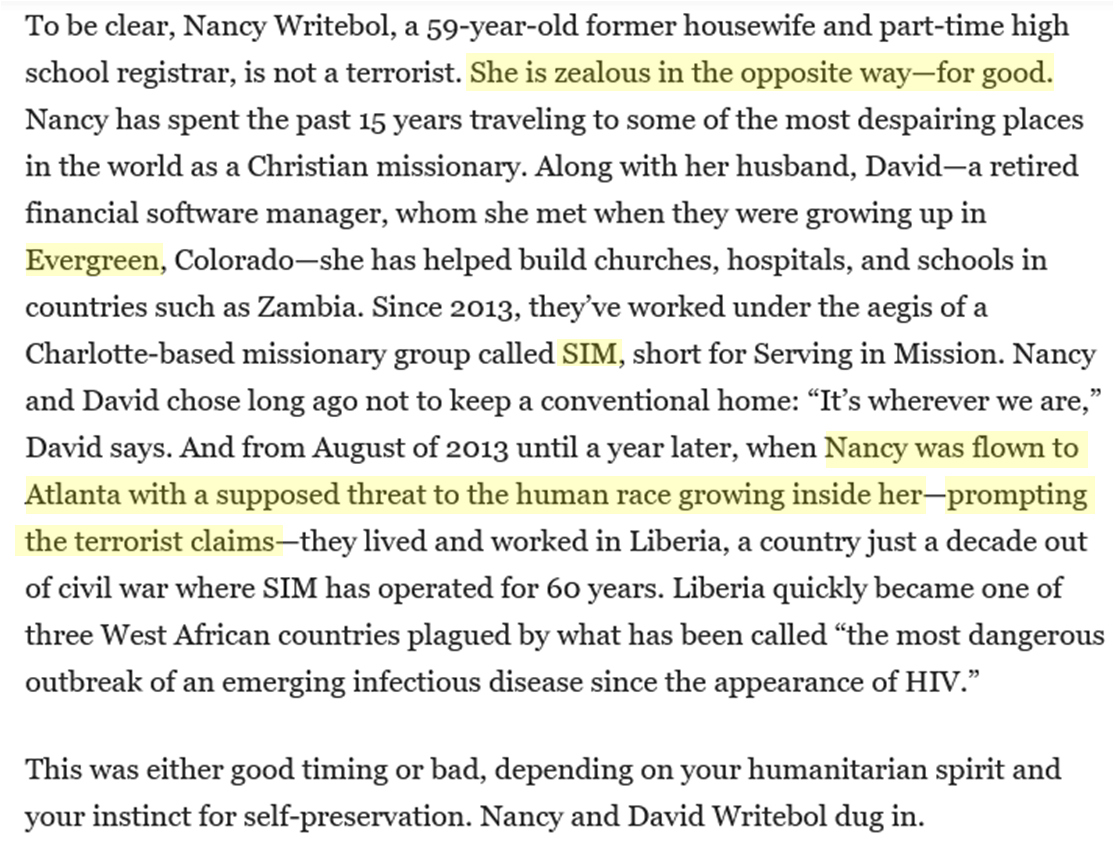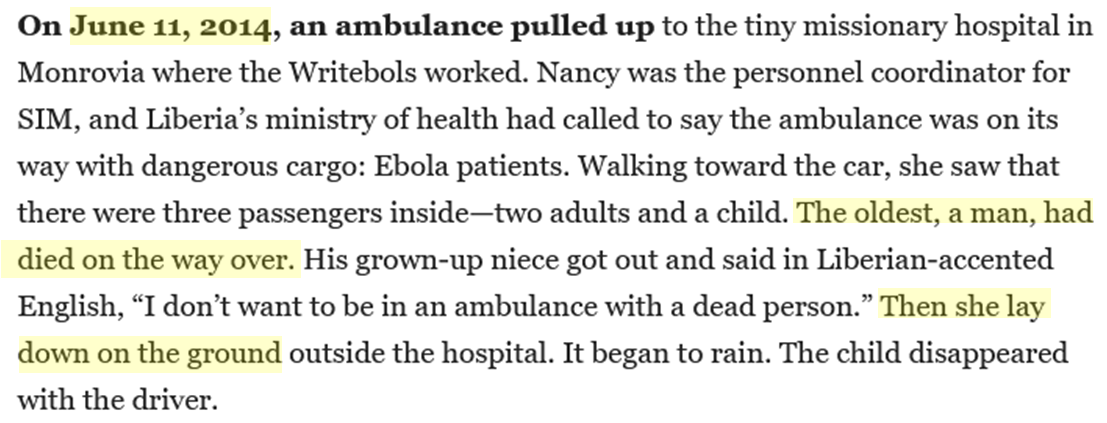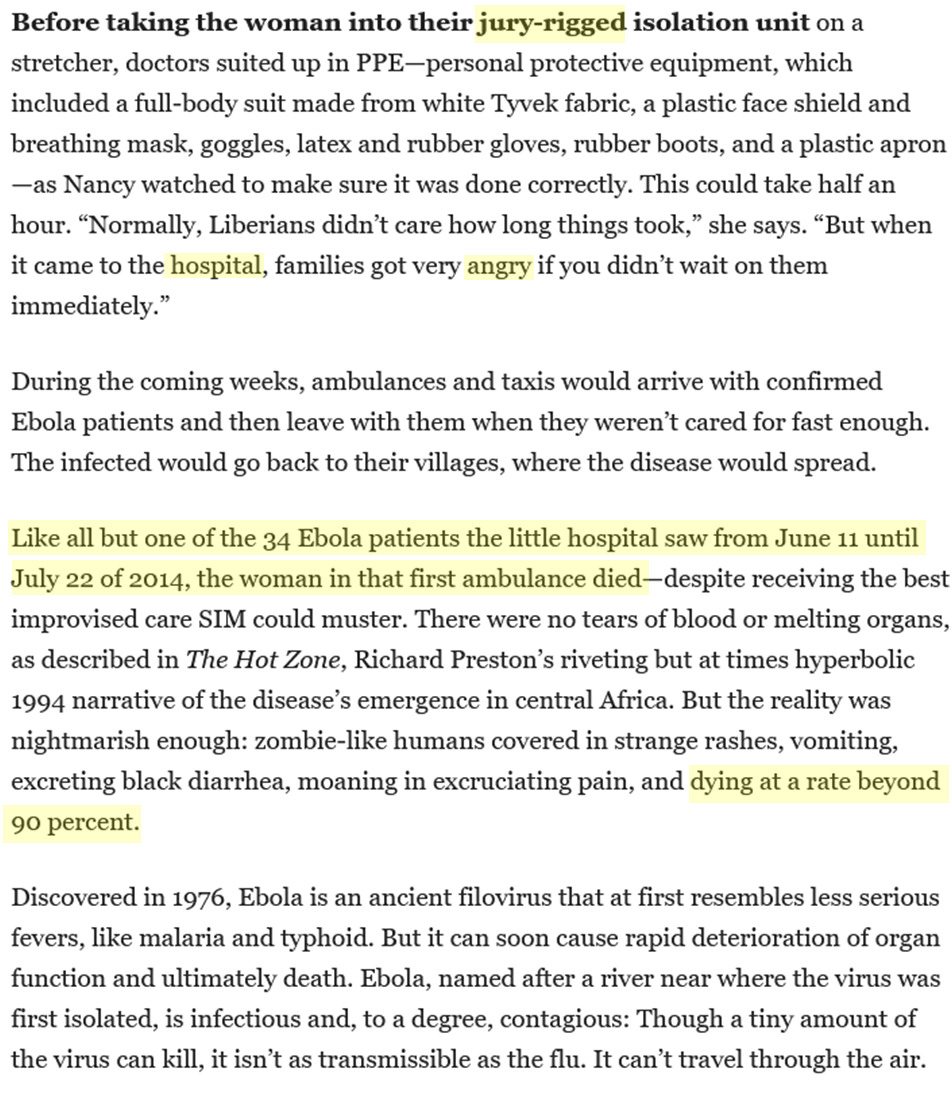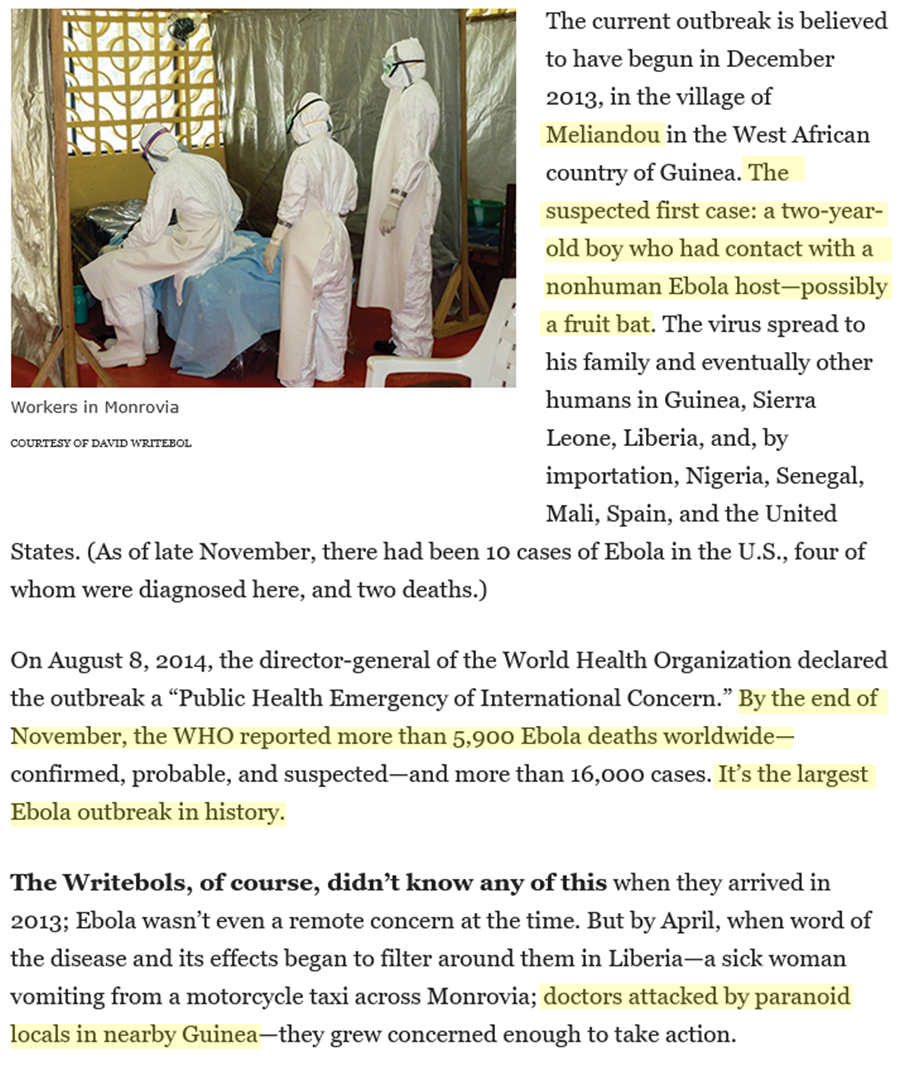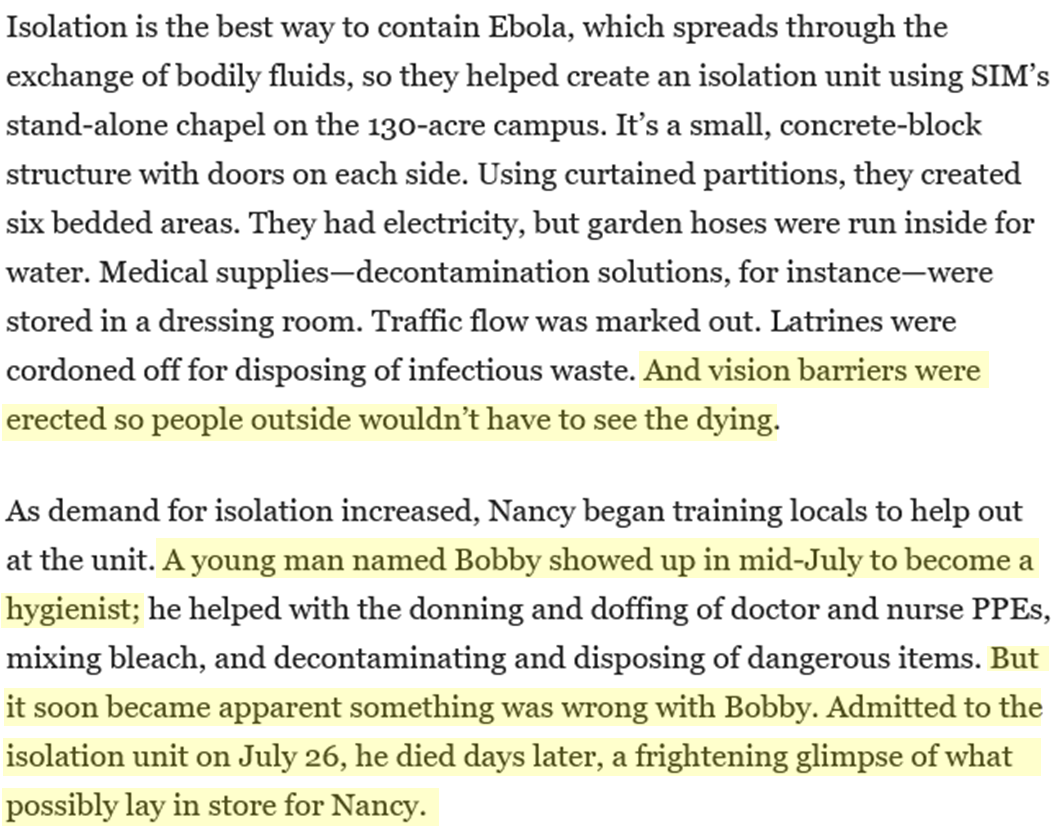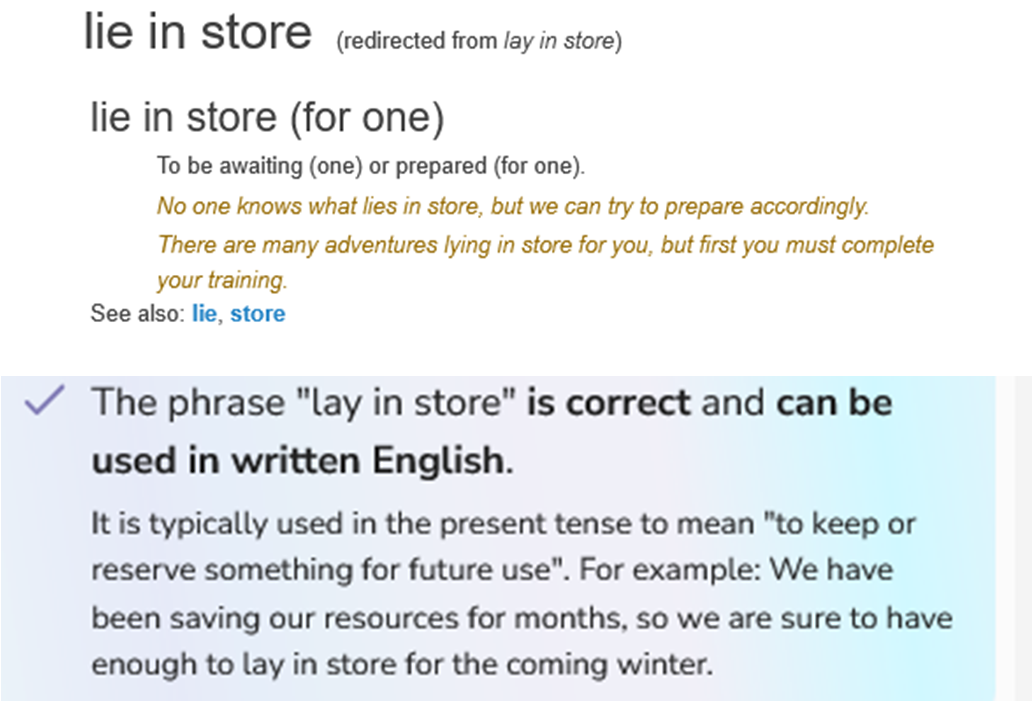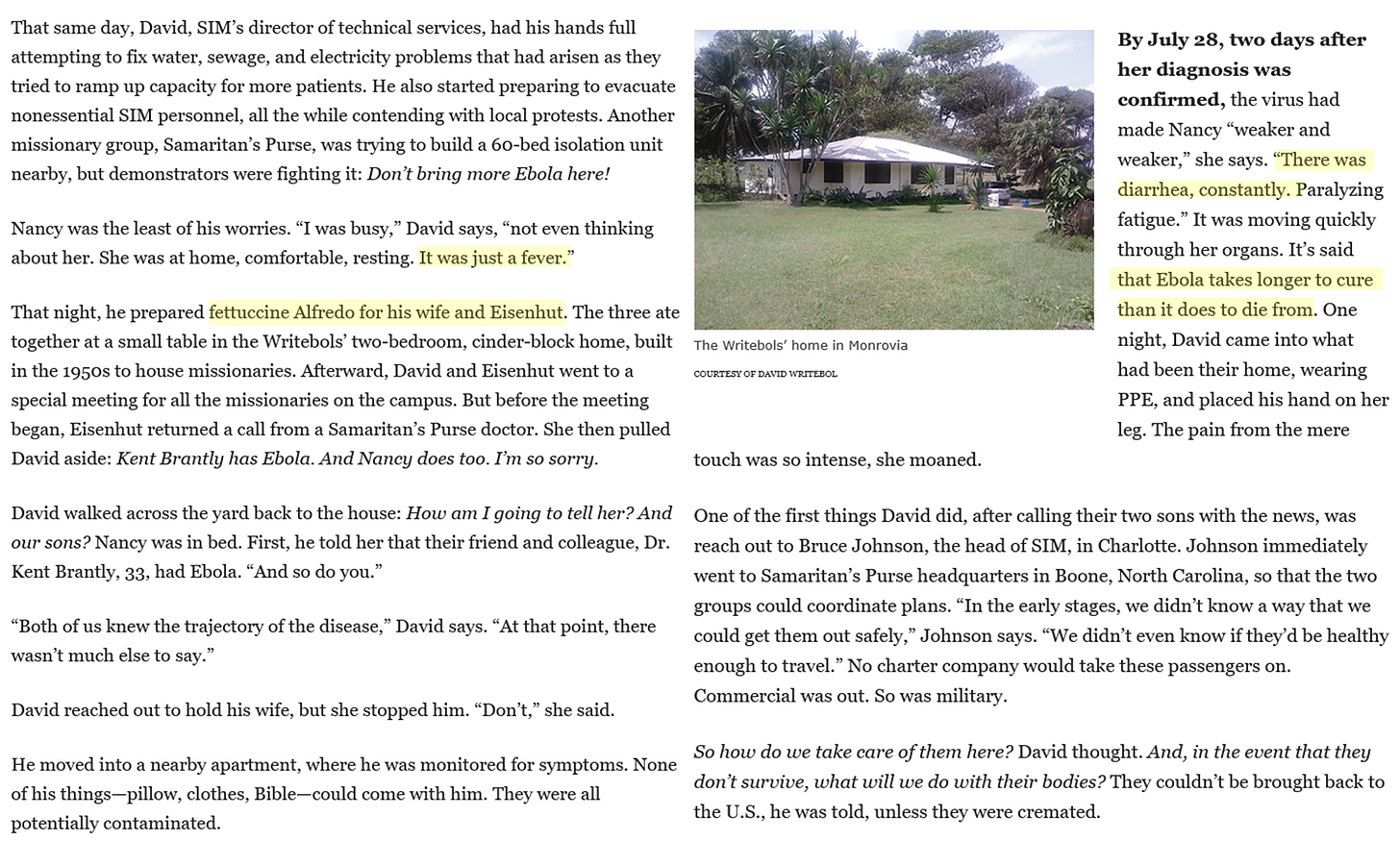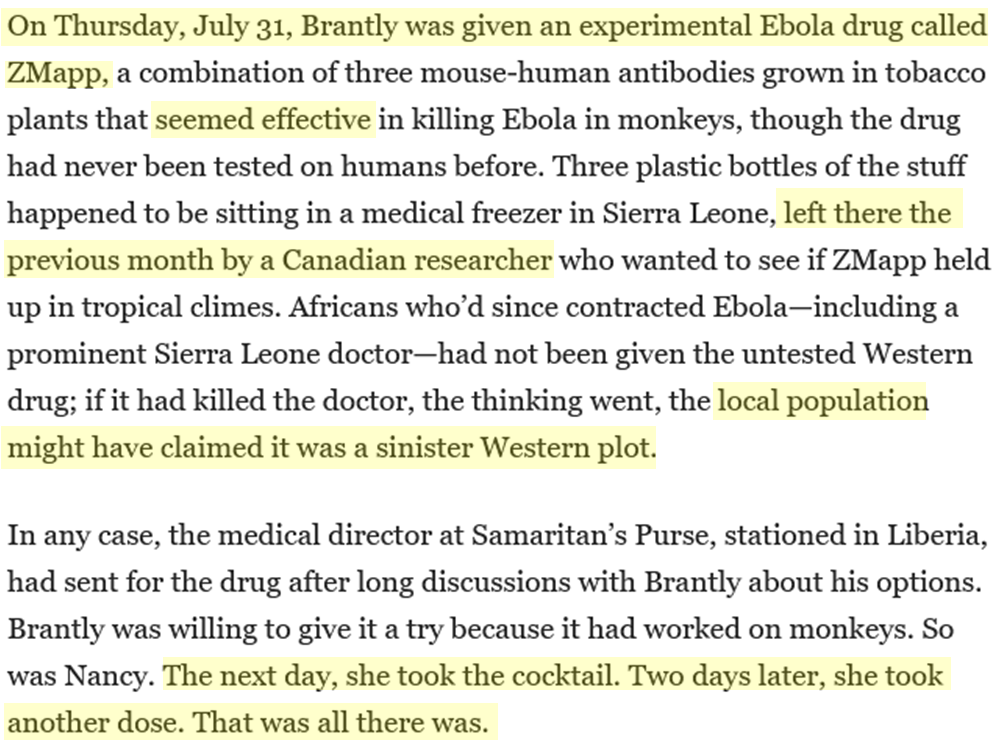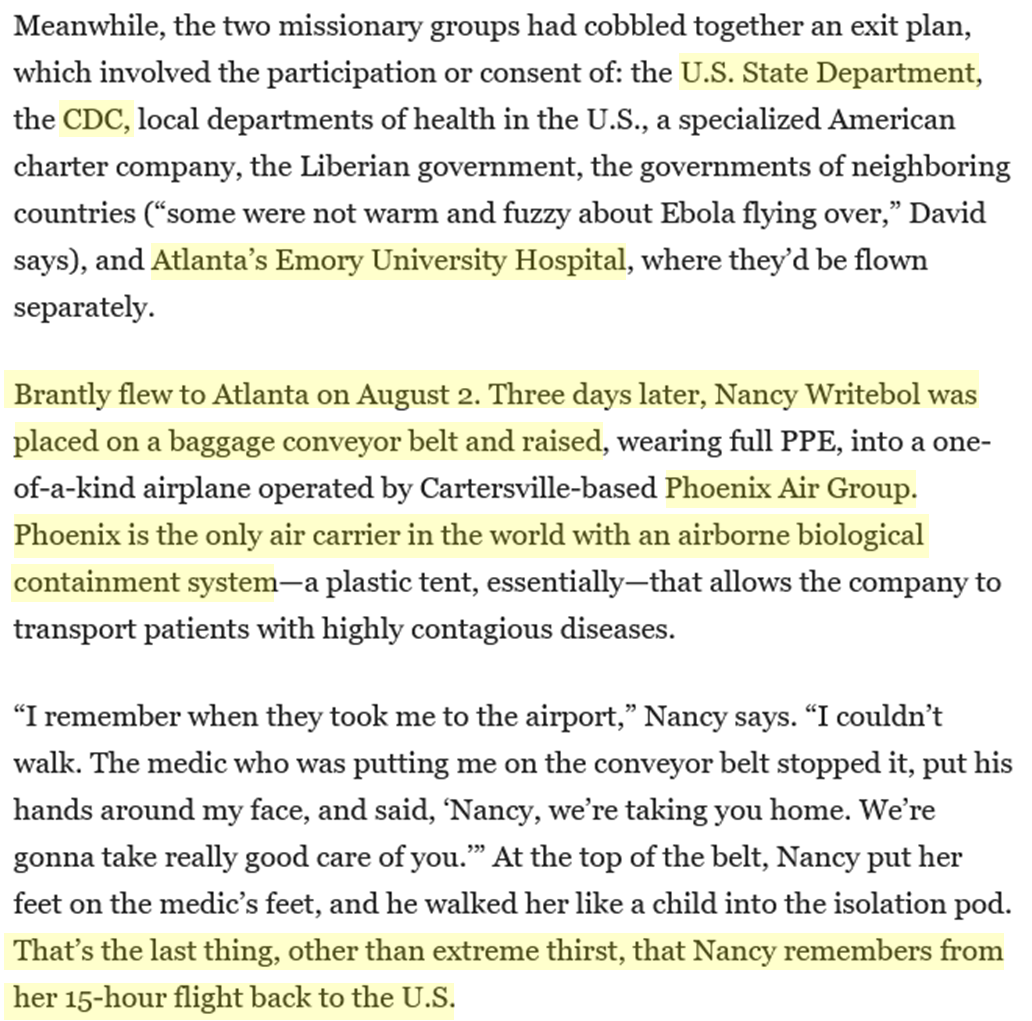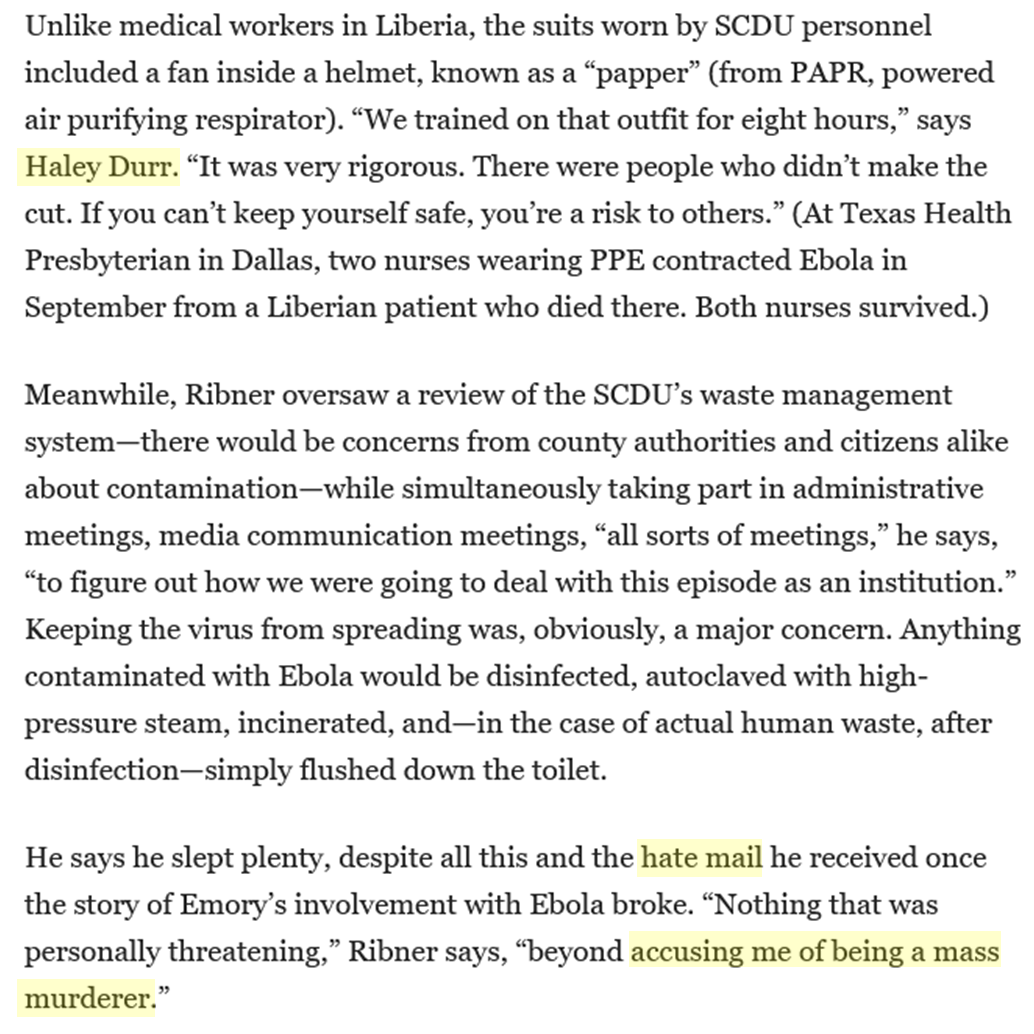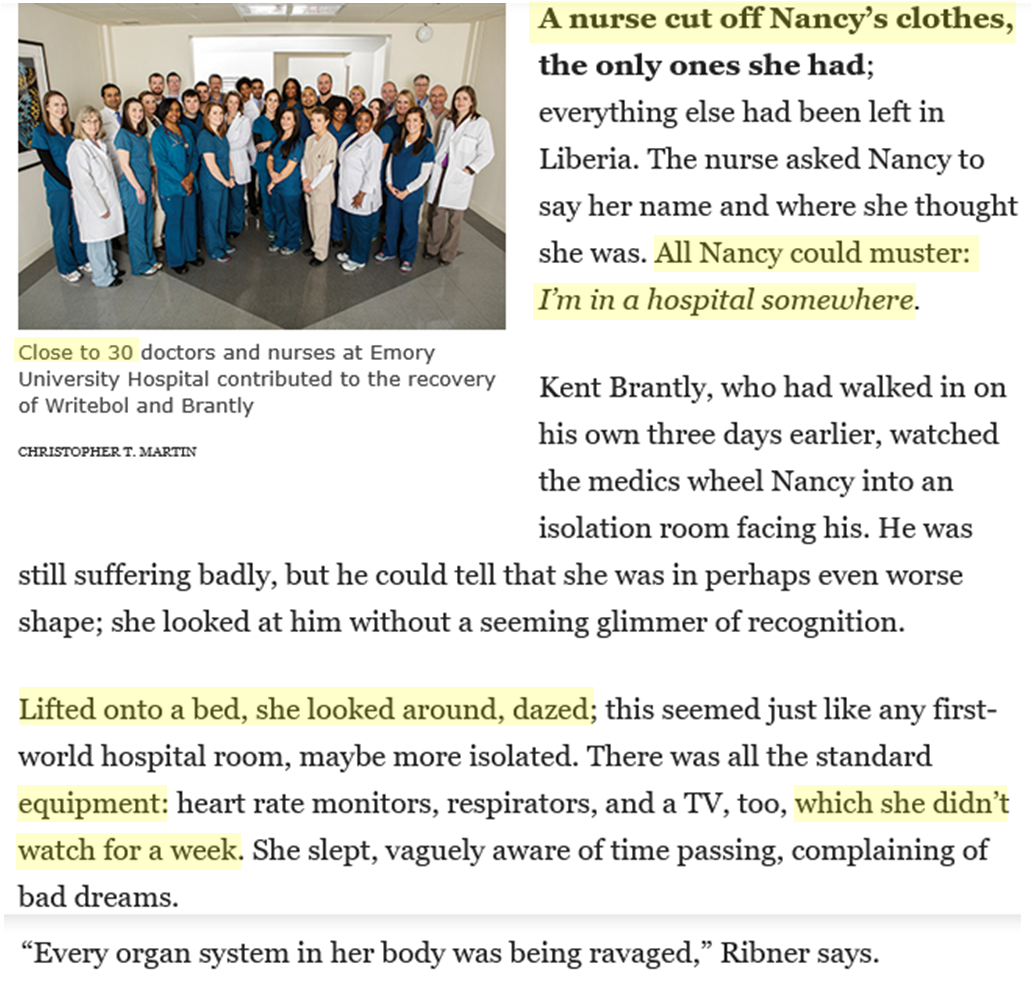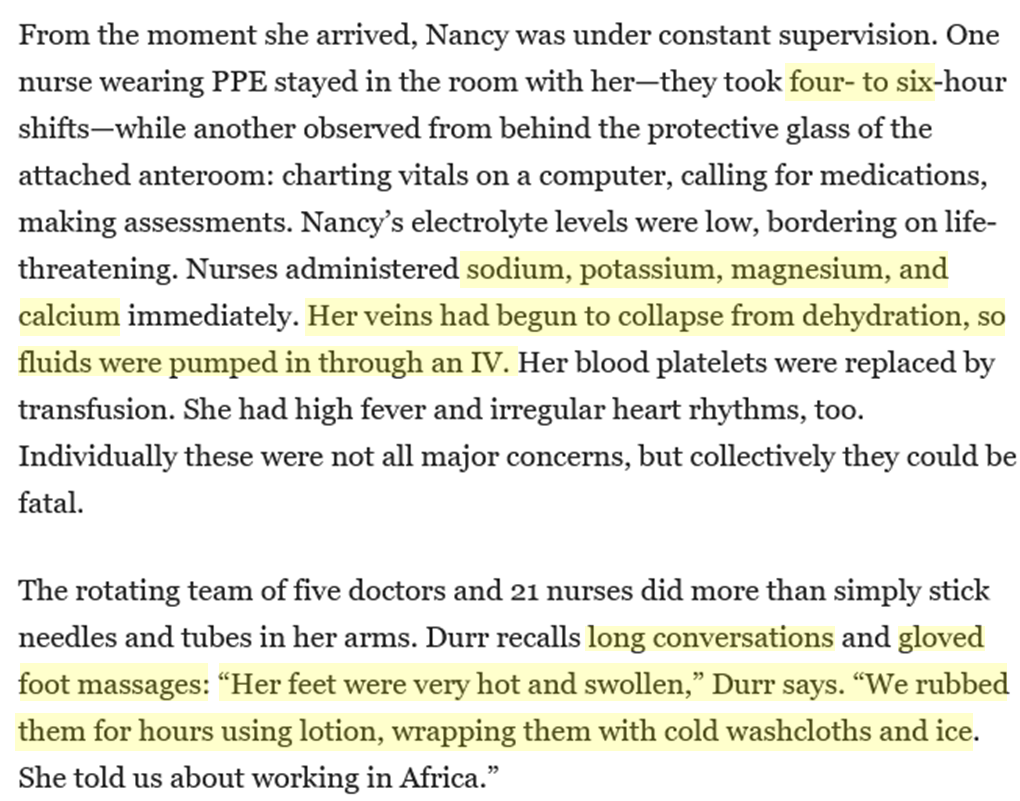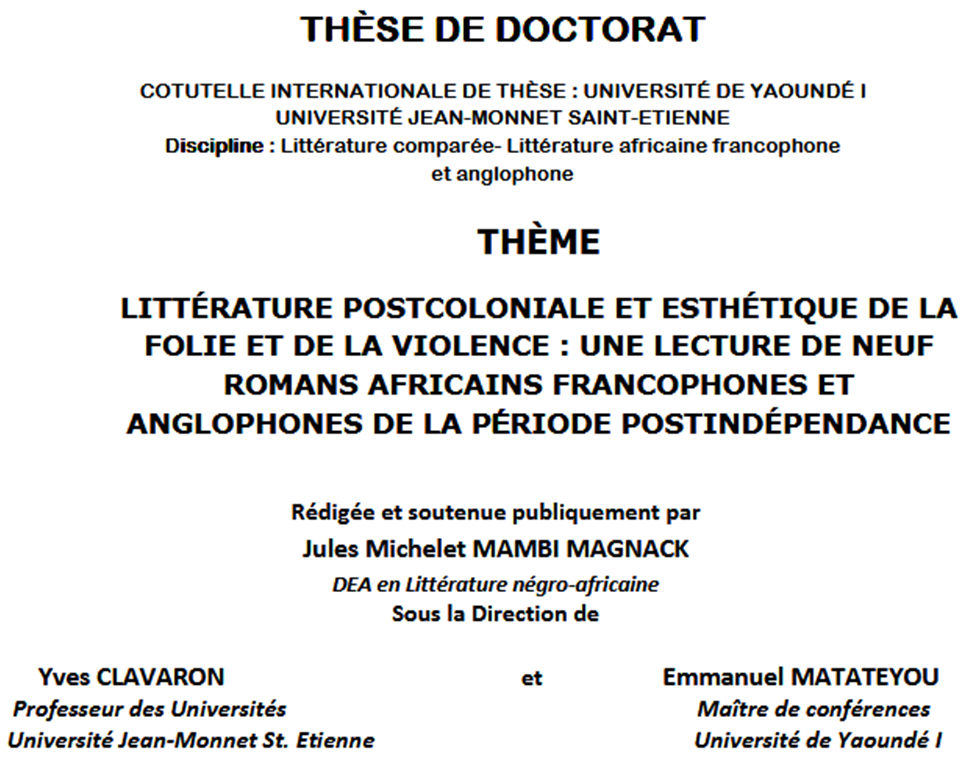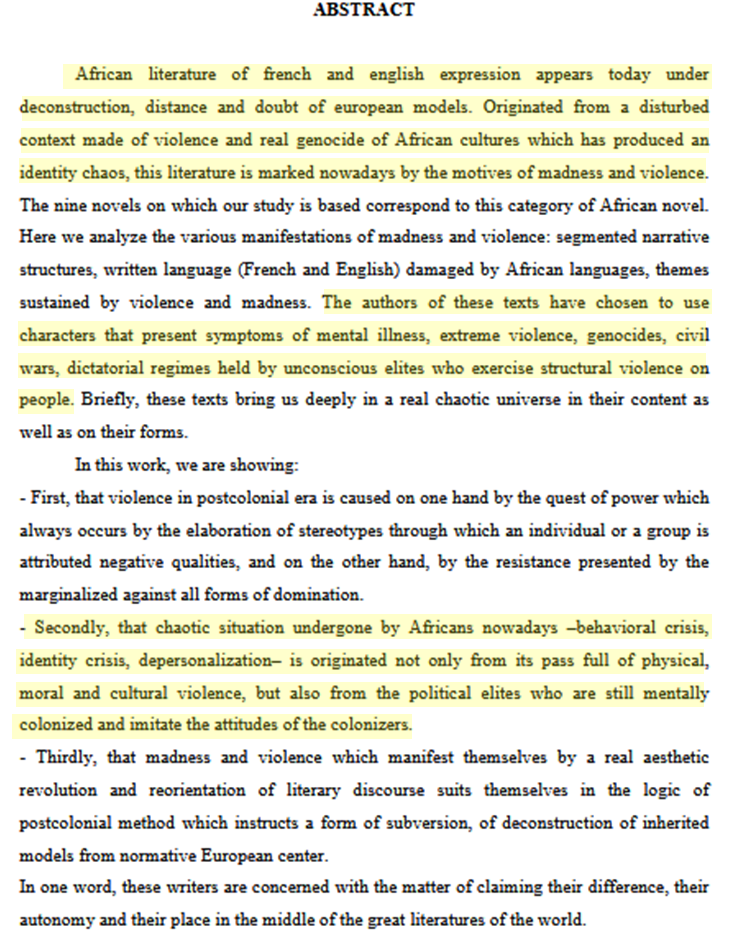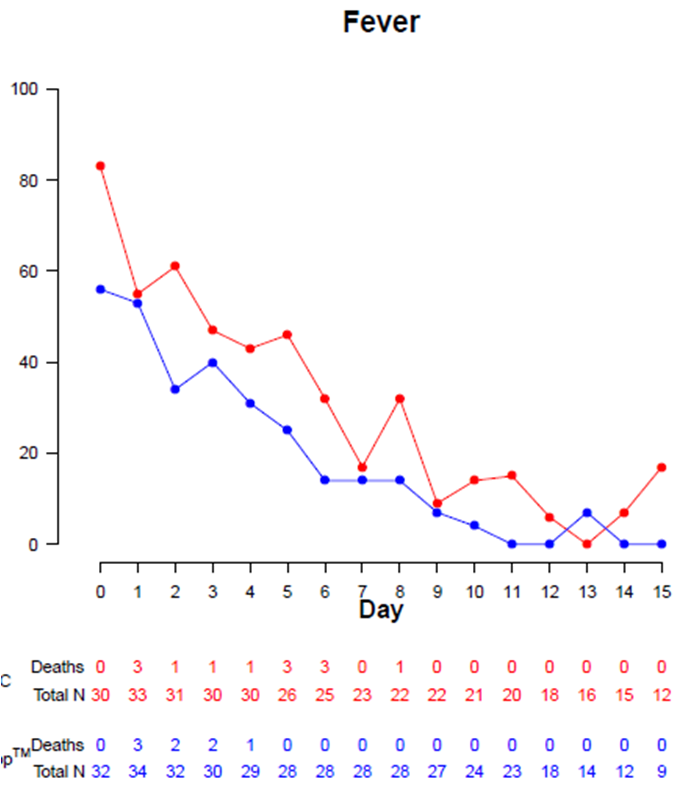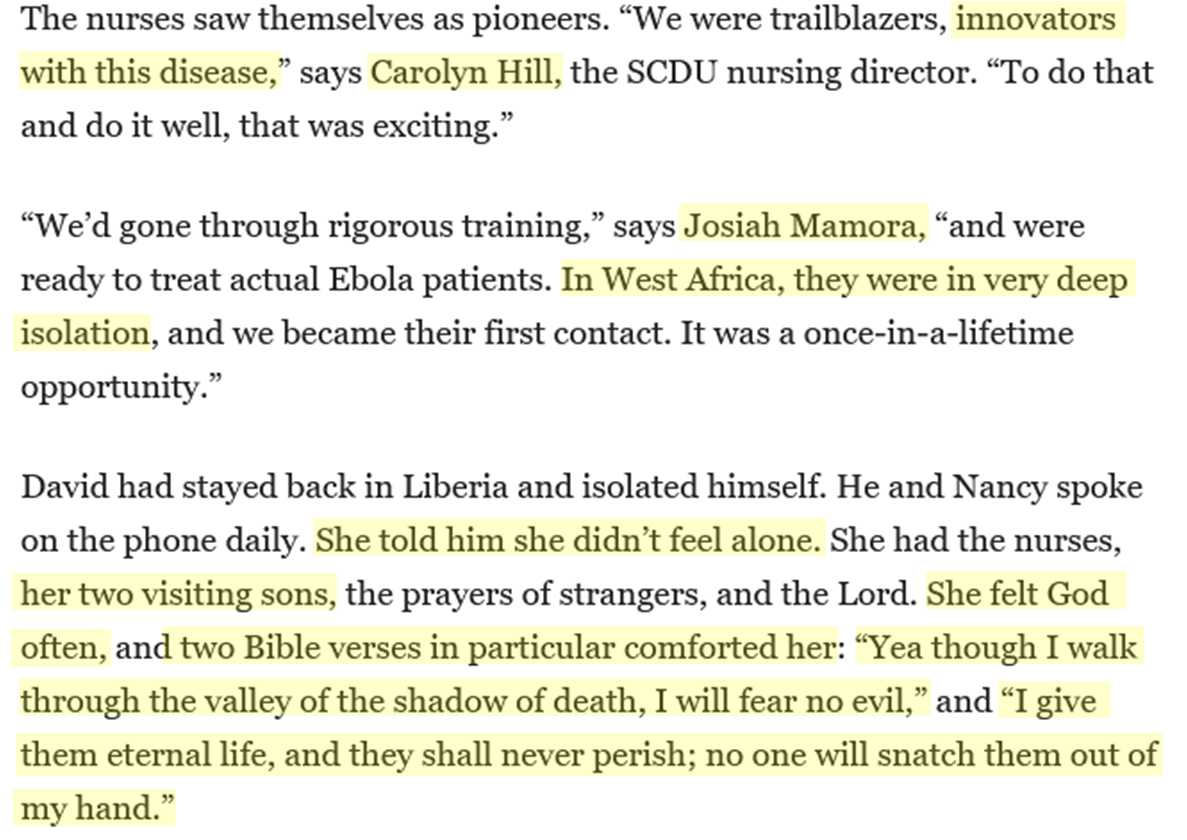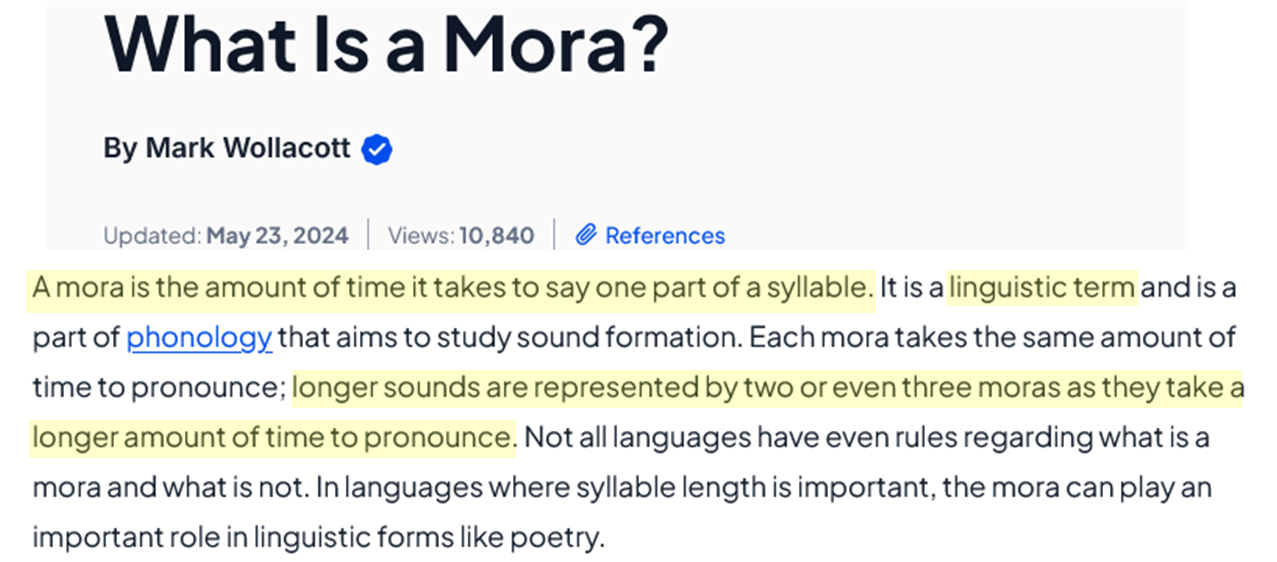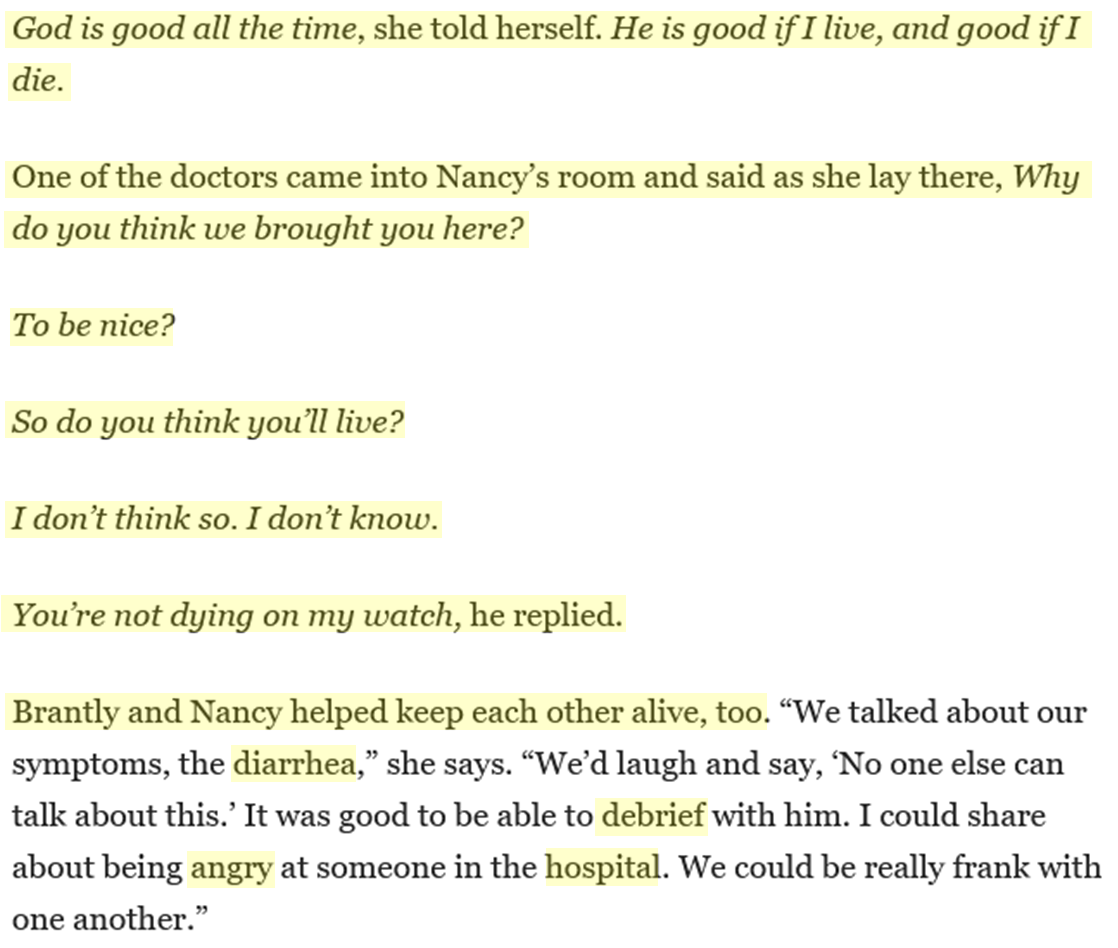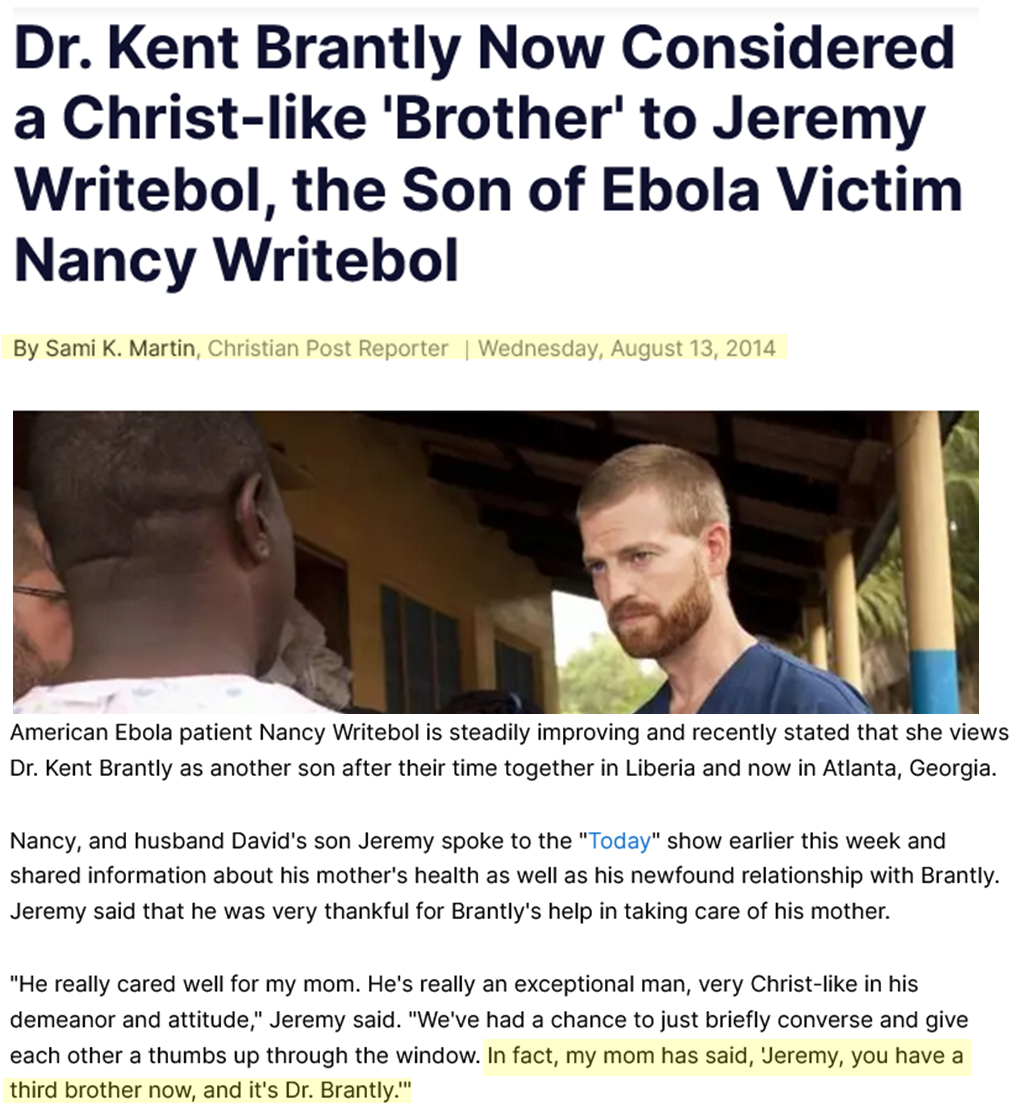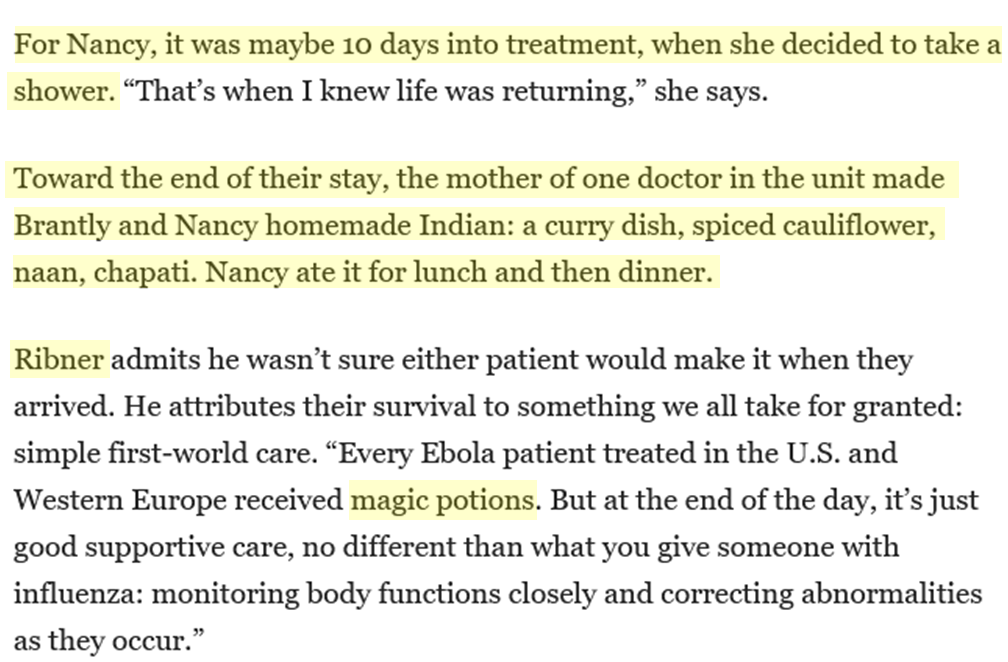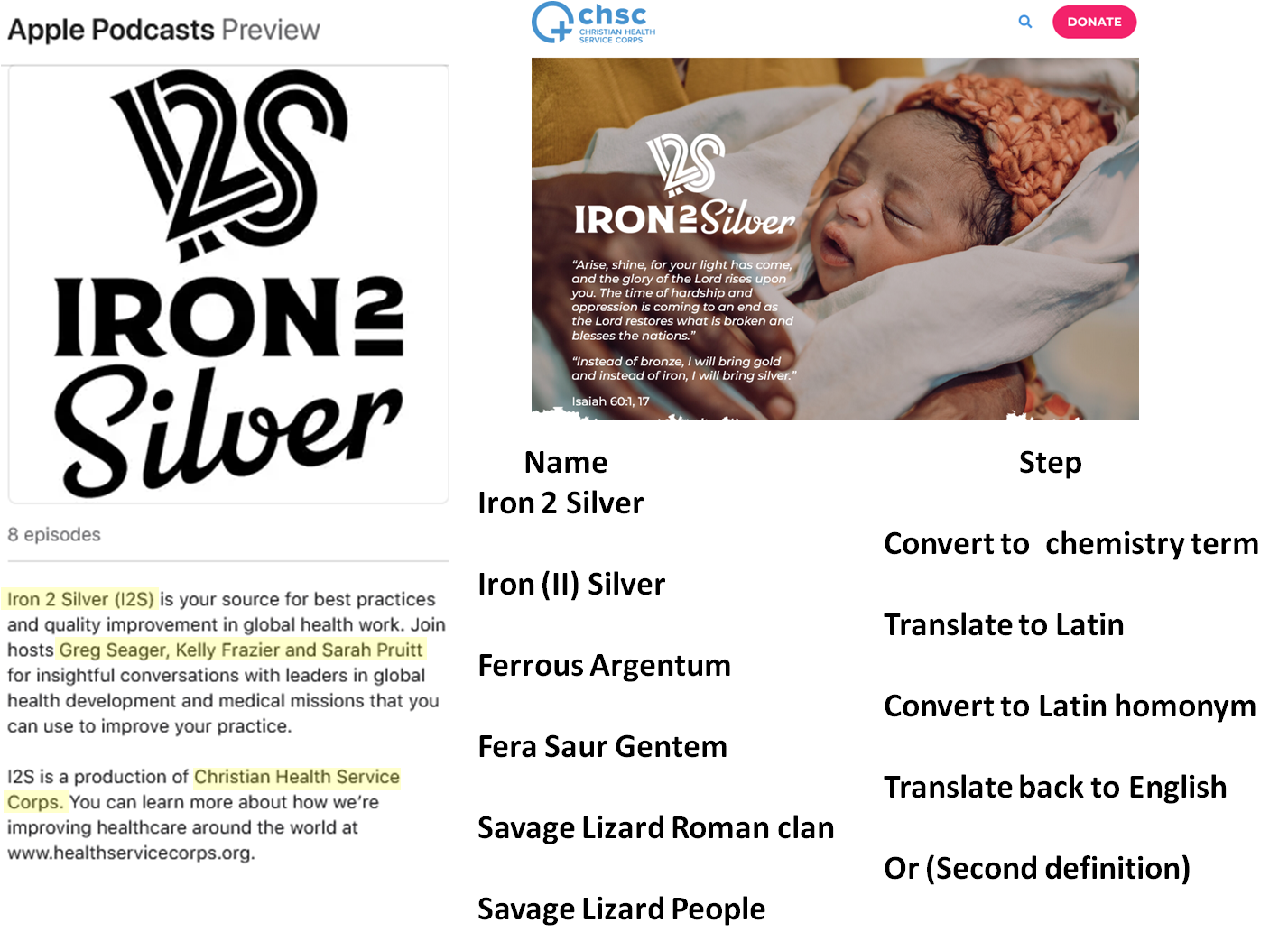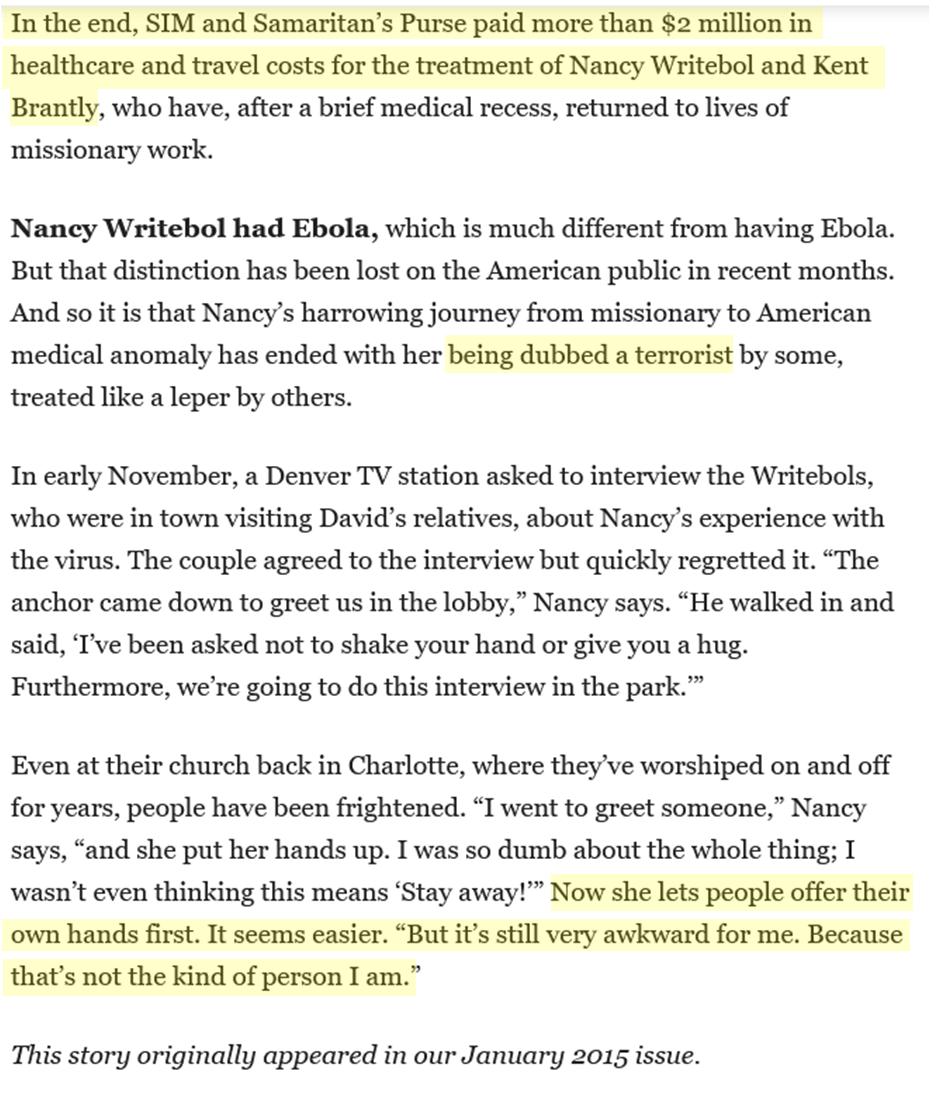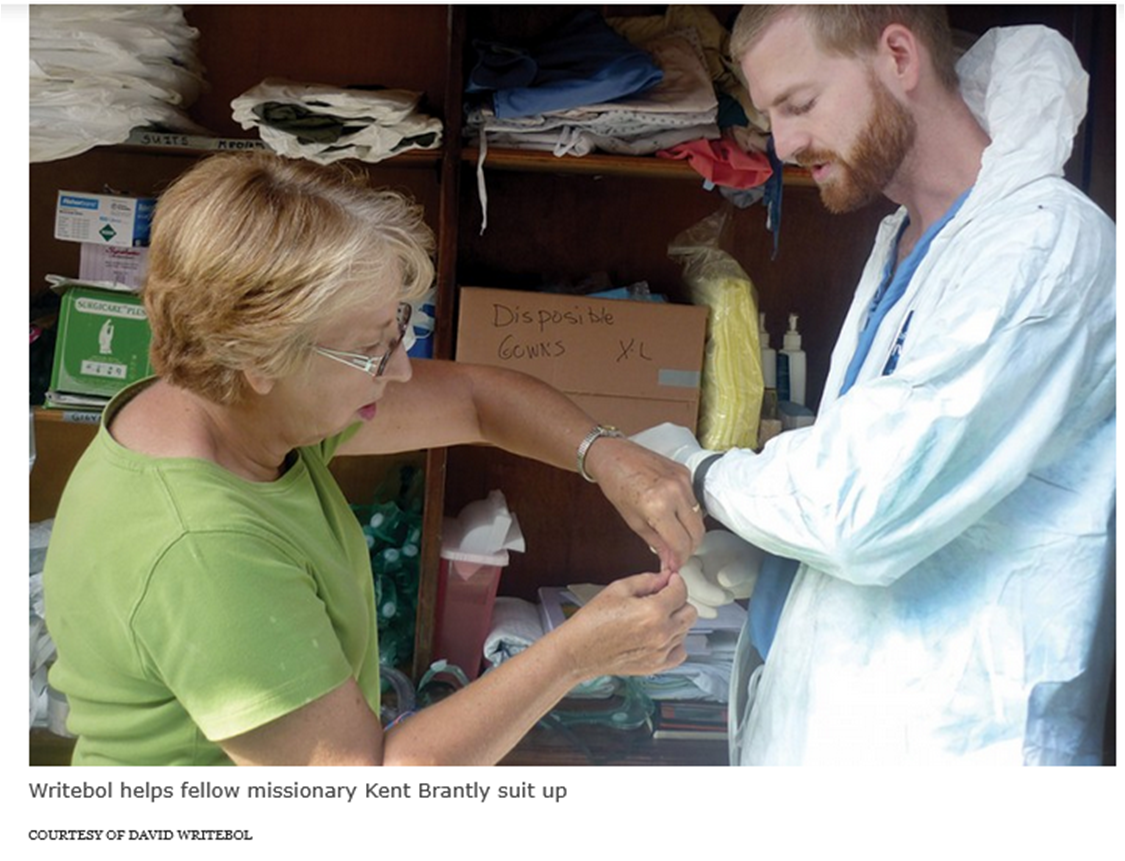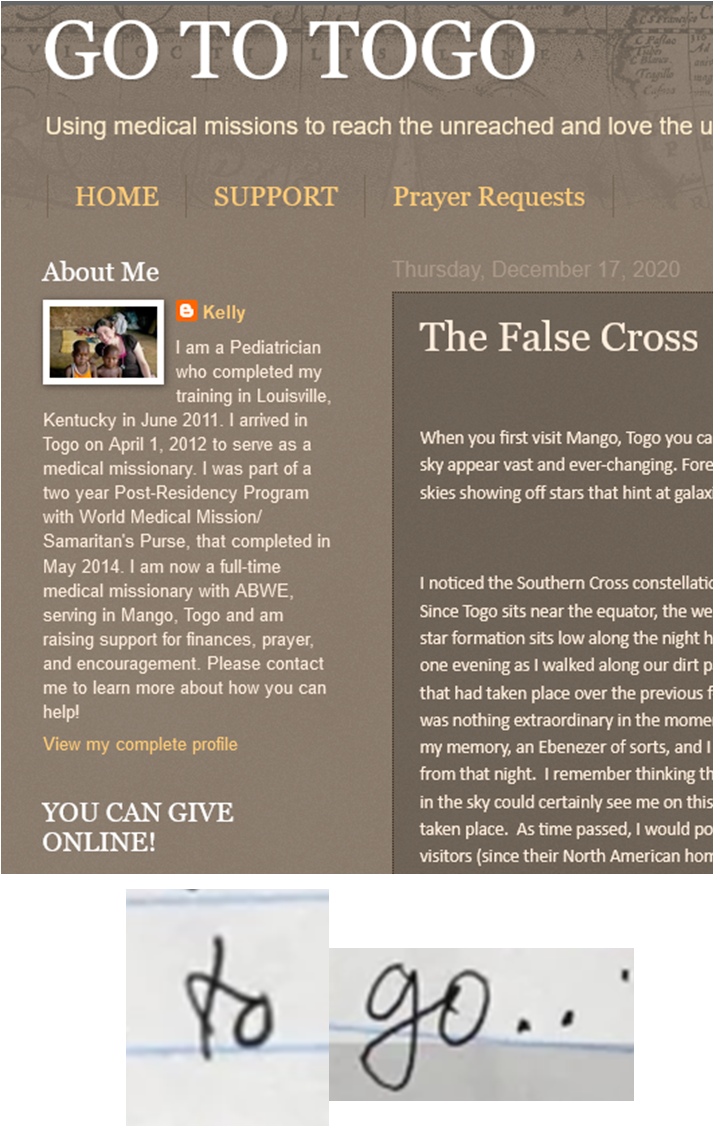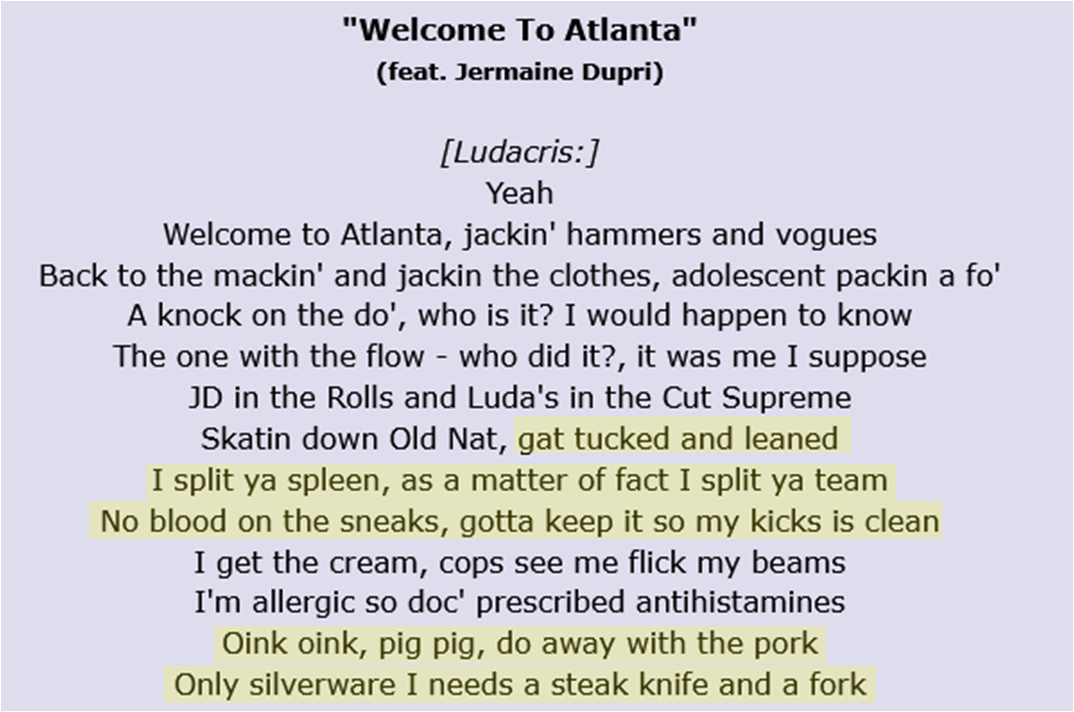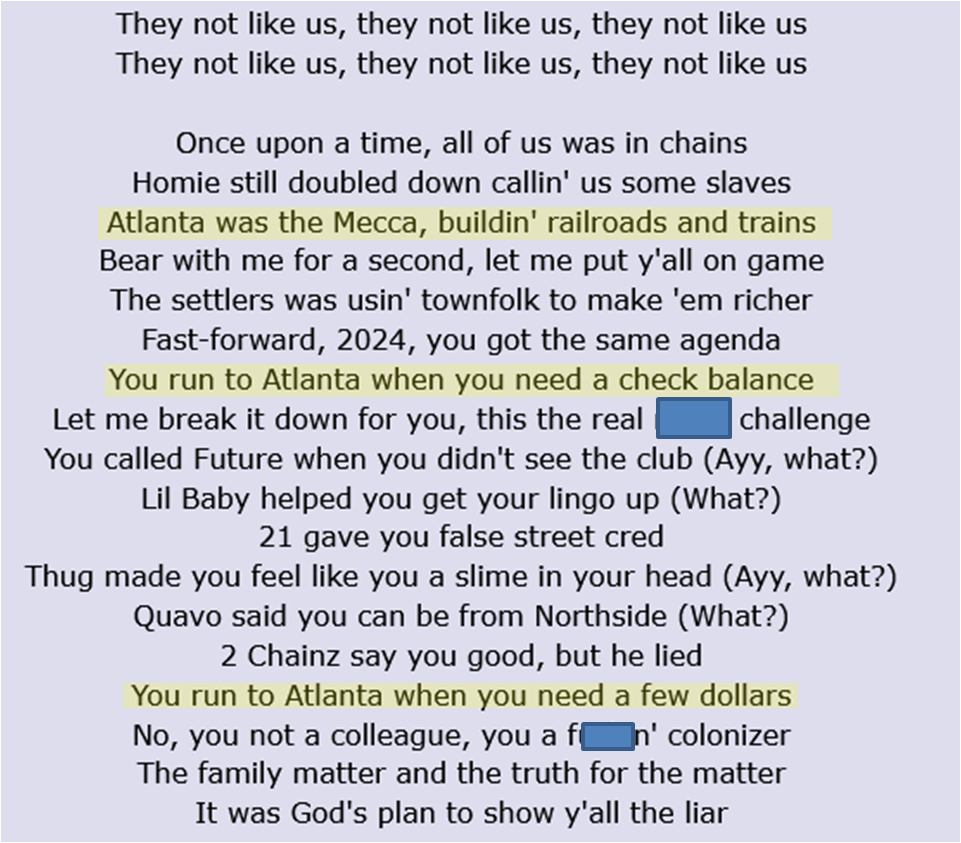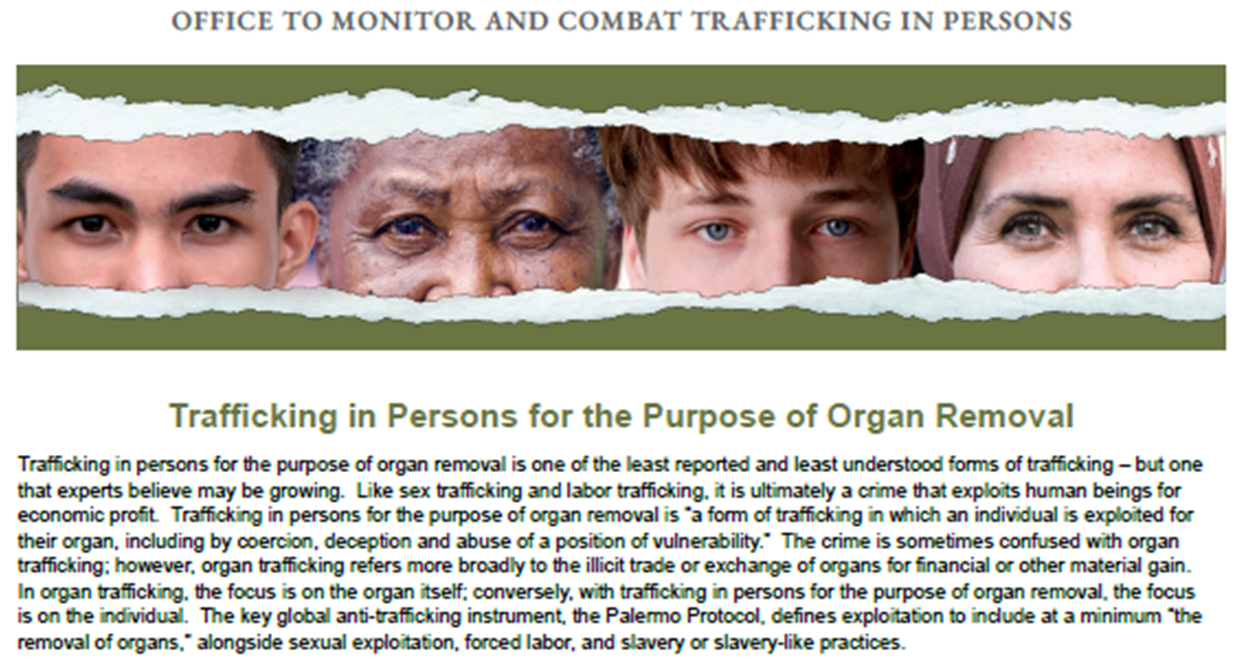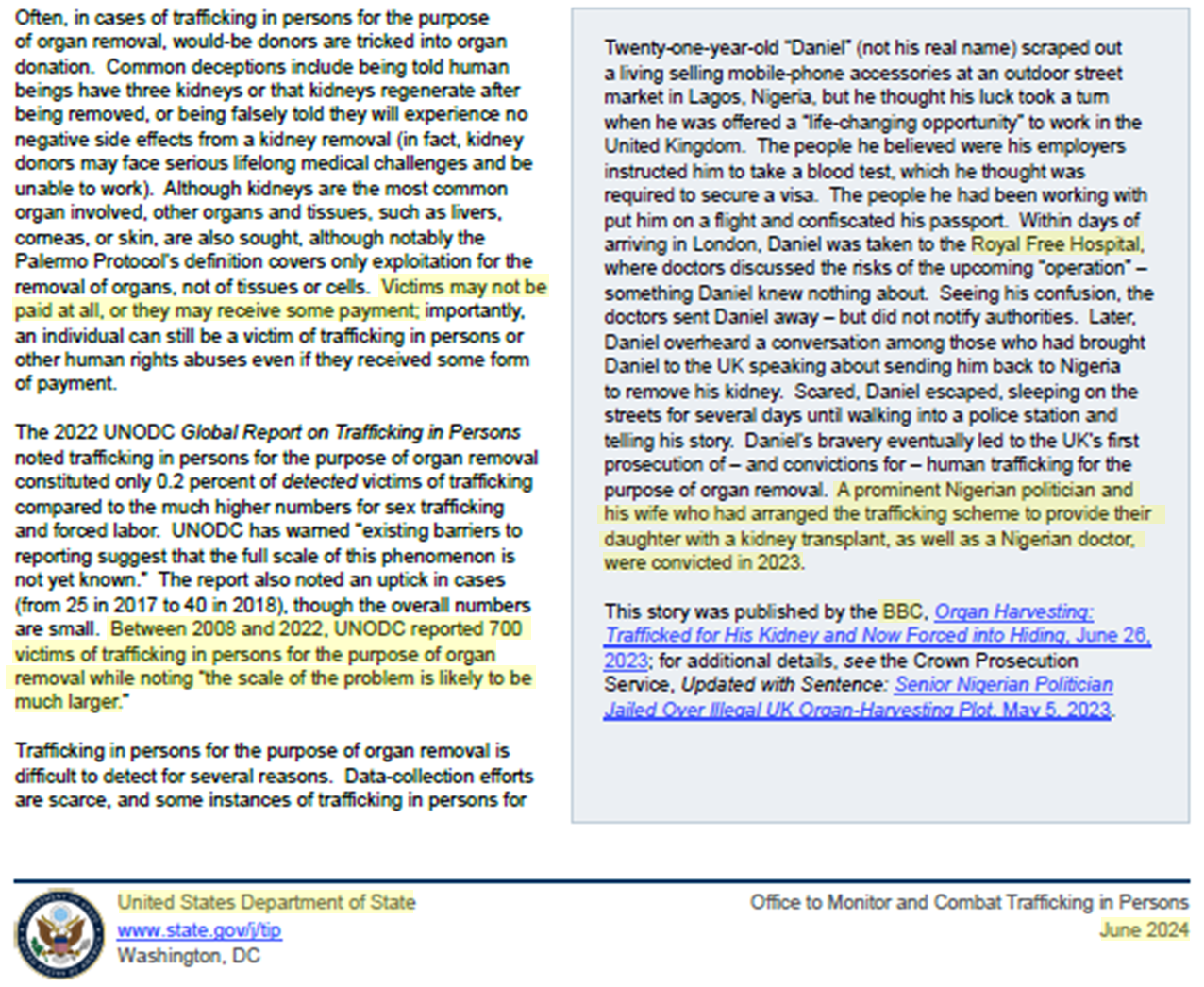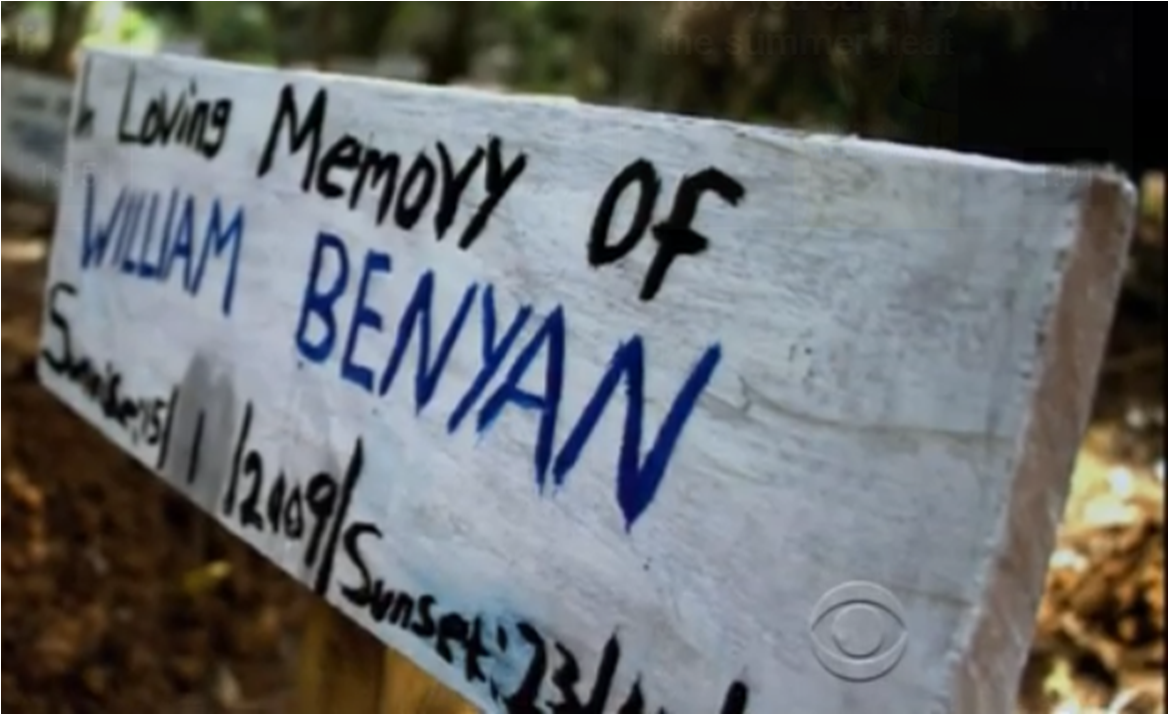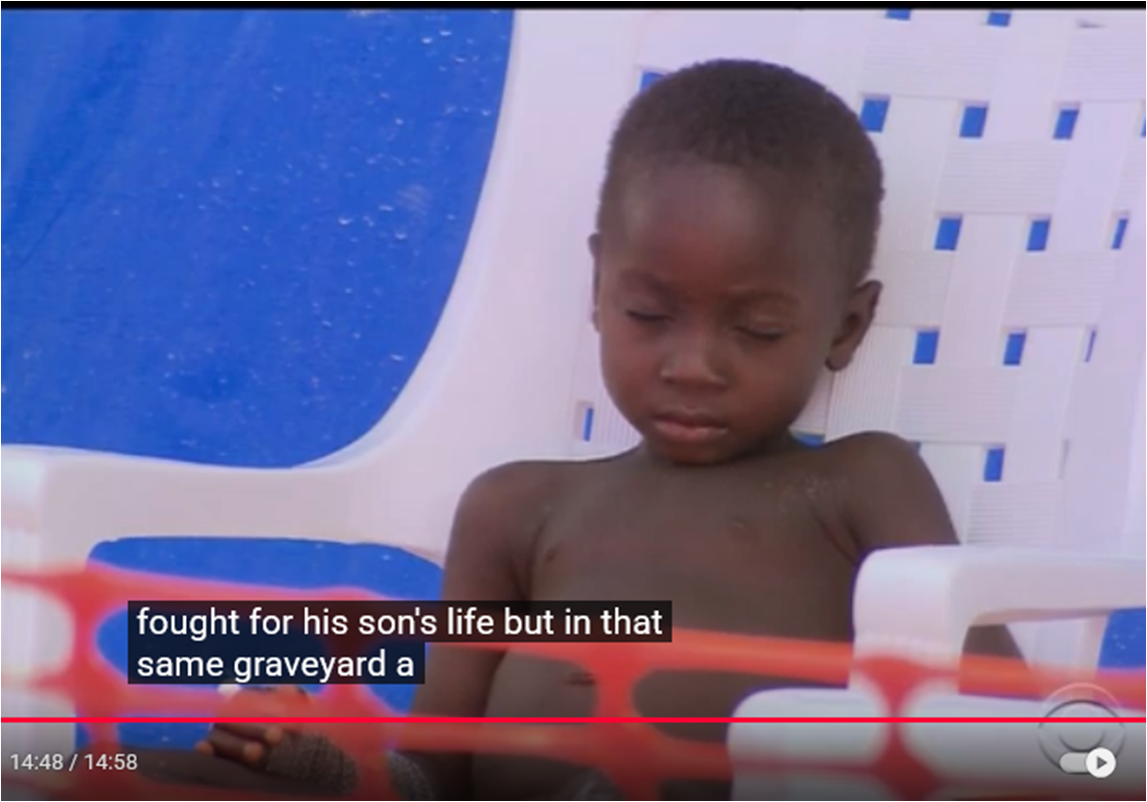Learn to Decode, Part 2: Welcome to Atlanta
“I split your spleen. As a matter of fact, I split your team. No blood on the SNEAKS, gotta keep it so my KICKS is clean.” –Jermaine Dupri & Ludacris, "Welcome to Atlanta"
In Part 1 of “Learn to Decode”, the presence of Christian Health Service Corps (CHSC) missionaries Britney Grayson and Micah Wilfong’s at the Covenant School in Nashville was shown to coincide remarkably closely with the initiation of the Covenant School shooting. The timing raises questions about whether alleged attacker Audrey Hale or others at the scene might have interacted in some fashion with the two CHSC medical missionaries.
It is noteworthy that the work of CHSC is closely tied to USAID, as described by the Founder and CEO, Greg Seager, on April 1, 2025. (https://www.healthservicecorps.org/a-medical-missions-perspective-on-changes-to-usaid-funding ) who wrote, “Recent changes and pauses in USAID program funding have prompted concern…”
Another among the approximately 100 fellow CHSC missionaries listed alongside Grayson and Wilfong is Dr. Kent Brantly, whose name might be familiar to many readers. His posted biography on https://www.healthservicecorps.org/staff/dr-kent-amber-brantly reads as follows:
(A listing a biography of CHSC Staff, as archived in May 2024, is available at: https://web.archive.org/web/20240525143521/https://healthservicecorps.org/where-we-serve/ , bold font and italics added throughout for emphasis throughout “Learn To Decode, Part 2”)
“About Dr. Kent & Amber Brantly
Before they were married, Kent and Amber shared a calling to share the love of God through tangible service and to have compassion on those in need. This calling led them to serve as medical missionaries in Monrovia, Liberia, with Samaritan’s Purse after Kent completed his training in Family Medicine.
In (July) 2014, after joining the fight against the Ebola outbreak, Kent was diagnosed with Ebola virus disease. He became the first person with Ebola to be treated in the United States when he was evacuated to Emory University Hospital. Kent and Amber were overwhelmed and grateful for the prayers and support they received from millions around the world during Kent’s illness and recovery.
With their story at the forefront of international news, the Brantlys spent the following years advocating for the plight of those continuing to suffer from Ebola in West Africa...”
In August 2014, Kent Brantly was interviewed about his experience by media outlets, including Matt Lauer of NBC’s Today Show (
)and by the Christian Broadcasting Network (CBN) (https://cbn.com/video/700-club/doctor-kent-amber-brantly-fight-against-ebola ) among many others.
In fact, ‘The Ebola Fighters’ were collectively named the “Time Magazine Person of the Year”, and the publication featured Kent Brantly on one version of its cover in December 2014. (https://time.com/time-person-of-the-year-ebola-fighters/ for the story and https://time.com/time-person-of-the-year-cover-photographs/ for the cover photo).
Earlier in the year (5 September 2014), Time had published Kent Brantly’s own commentary about his experience, ( https://time.com/3270016/ebola-survivor-kent-brantly/ ) – an excerpt of which is included here:
“On July 20, we opened a larger isolation unit and consolidated our smaller facility with the patients from another nearby hospital. That’s the same day I dropped off Amber and the kids at the airport to return to Texas for a family wedding. I was supposed to meet them a week later. But just three days after their departure (23 July), I got sick.
Even with the bad news, I felt calm. I never shed a tear when I called my wife and said, “Amber, my test is positive. I have Ebola.” Though the rest of my family wept, I felt strangely at peace. God blessed me with that peace that surpasses understanding. Since we had started treating patients with Ebola in Monrovia, we had only had one survivor. I had watched too many people die from this disease. Amber and I were both at the disadvantage of knowing how this illness ends.
At some point, I was told about an experimental drug. It had worked on monkeys, but had never been tested in humans. I agreed to receive it, but then decided that Nancy Writebol should get it first, since she was sicker. I was not trying to be a hero; I was making a rational decision as a doctor.
Over the next couple of days, though, my condition worsened. My body began shaking, my heart was racing. Nothing would bring down my temperature, and I had fluid in my lungs. I felt hot, nauseated, weak–everything was a blur. I had friends and colleagues praying outside my house–and all over the world. The doctor decided to give me the drug, and within an hour my body stabilized a bit. It was enough improvement for me to be safely evacuated to Emory University Hospital in Atlanta.”
Nancy Writebol also shared her story with the Christian Broadcasting Network (CBN) shortly after her release from the hospital. https://cbn.com/news/us/ebola-survivor-christ-carried-me-through
Ebola Survivor: Christ Carried Me Through
“Missionary Nancy Writebol is one of four Americans who contracted the Ebola virus while working in Liberia. In the weeks after her recovery, Writebol has been sharing her story with others. ‘There were nights when I laid my head on my pillow and I wondered if I would be alive in the morning,’ she recalled. ‘When they put me on the plane to evacuate me, David (Nancy Writebol's husband) and I said goodbye and I wasn't sure if I would live.’
Although there were many moments of uncertainty, Writebol and her husband continued sharing how their faith and hope in Christ carried them through. Their hearts, however, are still with the people they served in Africa, where they'd like to return. Writebol said people who have never been there don't understand what it's really like. The virus killed 39 of the 40 patients they treated during the month they were there, serving with SIM, a Charlotte-based missionary group.
So far, Ebola has killed more than 3,000 people, mostly in West Africa.”
The acronym SIM currently stands for “Serving in Mission”, and its US headquarters is Charlotte, NC while its United Kingdom headquarters is in Cambridge, UK. SIM’s website (at http://www.sim.org/history ) states that it was initiated in 1893, though the UK website (https://sim.co.uk/history ) explains that the 1893 version of SIM stood for “Sudan Interior Mission” and that: “One thread of our historical tapestry starts in 1860 with the formation of the British Syrian Schools Association.” The site adds: “More threads pick up in the 1890’s across Africa and Asia,” under the titles of “South African General Mission”, “South East Africa General Mission”, “Ceylon and India General Mission”, and “Poona and Indian Village Mission”.
Given an apparent 1 in 40 odds of survival in the missionary hospital, it is striking that both Kent Brantly and Nancy Writebol recovered- odds of only 1 in 1,600 of both recoveries happening by chance. Therefore, it would be natural to assume that the experimental drug was the difference-maker in the survival of Kent Brantly and Nancy Writebol.
The experimental drug praised by Brantly is called ZMapp and was discussed in a 12 August 2014 Time article (https://time.com/3104174/who-gets-the-experimental-ebola-drugs/ ) as follows.
“Right now, the biggest constraint of increasing production of ZMapp is time. Since the antibodies are grown in the tobacco plant, the plant obviously needs time to mature,” says Maura Payne, the vice president of communications for Reynolds American Inc., which heads the Kentucky BioProcessing plant making ZMapp.
As TIME reported earlier, there’s been very low financial incentive to develop drugs for Ebola, which is in part why health responders are empty handed. Whether researchers and manufacturers can develop and produce enough drugs to have any sort of impact on the current outbreak is yet to be seen.”
Many readers will be aware that Reynolds Tobacco has faced many lawsuits due to their tobacco products which are proven to cause lung cancer. For example, in 2006, a verdict against Reynolds Tobacco Co. for $145 billion class-action suit was tossed out by a Florida court (https://apnews.com/general-news-767b2bfca8644c36a29911afc2540b78 ). Individual lawsuits continue to this day.
***
The development of ZMapp was described in a Forbes magazine article on 5 August 2014 written by David Kroll (https://www.forbes.com/sites/davidkroll/2014/08/05/ebola-secret-serum-small-biopharma-the-army-and-big-tobacco/ )
“CNN reported yesterday that American missionary Ebola patients, Dr. Kent Brantly and Nancy Writebol, received an experimental ‘secret serum’ against the virus while hospitalized in Liberia. But while the biotech product, called ZMapp™, is indeed still experimental – it's not yet approved for human use, and not yet even in phase I clinical trials – it's far from secret. The three-antibody mixture originated with Mapp Biopharmaceuticals, a small San Diego-based company… [..]
Dividend of biowarfare research
The product first described yesterday by CNN is the result of a convoluted convergence of U.S. and Canadian federal agencies and industrial partners that's typical for treatments of potential value against biowarfare and bioterrorism.
As with other companies working on small molecules and biologicals against Ebola and other hemorrhagic fever viruses, MappBio was the beneficiary of grants and contracts from federal agencies that include the National Institute of Allergy and Infectious Disease (NIAID), the Department of Defense Advanced Research Projects (DARPA), and the Defense Threat Reduction Agency (DTRA).
The U.S. Army Medical Research Institute of Infectious Diseases (USAMRIID) has been a critical driver of much of this work as they maintain biosafety level-4 facilities in Frederick, Maryland, and have extensive expertise with non-human primates as a model for human infectious diseases.
The ZMapp product is the result of a collaboration between Mapp, San Diego-based LeafBio, and Toronto-based Defyrus Inc, ‘a private, life sciences biodefence company that collaborates with military and public health R&D partners in the United States, Asia and Canada.’ The Public Health Agency of Canada is the Defyrus partner north of the border. [..]
The antibody mixture prevented the death of small groups of monkeys infected with Ebolavirus infection: six of six monkeys survived when given the antibodies one hour after infection while four of six survived when given the antibodies 48 hours after infection. For comparison, Dr. Kent Brantly didn't receive ZMapp until nine days after he showed symptoms.
What's confusing at this point is whether the published antibody mixture is the same that has been used in Dr. Brantly and, reportedly, Nancy Wrightbol (sp.). Mapp's antibody mixture is termed MB-003 but in a press release from Mapp and LeafBio, ZMapp is described as ‘an optimized cocktail combining the best components of MB-003 (Mapp) and ZMAb (Defyrus/PHAC).’
It was only on July 15 that Defyrus announced that their monoclonal antibody portfolio, including ZMAb would be licensed to LeafBio, the commercialization partner of Mapp Biopharmaceuticals.”
Less than one month after the highly-publicized anecdotal experiences of Kent Brantly and Nancy Writebol with ZMapp, the British Medical Journal reported the following news brief ( https://www.bmj.com/content/349/bmj.g5488 Published 4 September 2014, by Michael McCarthy):
“The US government has signed a multimillion dollar contract with the maker of the experimental Ebola drug ZMapp to accelerate the drug’s development. Under the contract the US Biomedical Advanced Research and Development Authority (BARDA) will provide funding, expertise, and technical support to the drug company, Mapp Biopharmaceutical, of San Diego, California. BARDA is the US agency tasked with developing medical countermeasures—including vaccines, medicines, diagnostics, and medical equipment—to respond to chemical, biological, radiological, or nuclear incidents or attacks, as well as pandemics and emerging infectious diseases.
The agreement was announced on 2 September (2014) by the US Department of Health and Human Services’ Office of the Assistant Secretary for Preparedness and Response, which oversees BARDA. The initial contract will provide Mapp with $24.9 million over 18 months to support work toward acquiring US Food and Drug Administration approval of the drug. The contract can be extended to a maximum of $42.3 million. (ref. 3)” [..]
Last week, researchers reported that ZMapp was able to rescue rhesus macaques that had developed advanced disease as indicated by elevated liver enzymes, mucosal hemorrhages, and generalized petechiae.”
This last statement references an article which had just been published in Nature with lead author, Dr. Xiangguo Qiu, as follows:
Qiu X, Wong G, Audet J, Bello A, Fernando L, et al. Reversion of advanced Ebola virus disease in nonhuman primates with ZMapp. Nature 2014; published online 29 August. doi:10.1038/nature13777
A later section of the 5 August Forbes article, describes more details of the association of ZMapp with tobacco:
“Tobacco therapeutics
What is known is that the antibodies are produced in a Australian strain of the tobacco plant by Kentucky Bioprocessing (KBP) in Owensboro, Kentucky, a 23-acre, contract R&D and protein production company that was acquired in January by Reynolds America, Inc, the parent company of R.J. Reynolds Tobacco.
In 2007, Mapp engaged KBP to manufacture a post-exposure treatment for Ebola infection, according to David Howard, head of external communications for RAI Services Company.
Recently, said Howard, ‘KBP complied with a request from Emory University Hospital and Samaritan's Purse to provide a limited amount of ZMapp.’ [..]
Why plantibodies?
ZMapp isn’t produced in the waving fields of tobacco one would find in Kentucky, Virginia, or North Carolina. Instead, the version of tobacco used by KBP is one that is easily manipulated with recombinant DNA techniques and amenable to automated greenhouse operations.
This same tobacco species is one also used by Medicago USA for development of a pandemic influenza virus.”
One might assume that the last statement was a malapropism, swapping the word ‘virus’ for the intended ‘vaccine’. Or… would it perhaps be better characterized as a Freudian slip?
***
The Forbes story also cites an article by Helen Branswell of The Canadian Post, highlighting the Canadian contribution to the development of ZMAPP ( https://web.archive.org/web/20140812210637/https://www.brandonsun.com/business/breaking-news/experimental-ebola-drug-based-on-research-discoveries-from-canadas-national-lab-269910211.html ) with excerpts, as follows:
(Helen Branswell, The Canadian Press, Tuesday, Aug. 5, 2014)
“TORONTO - Canadian research is at the heart of an experimental Ebola therapy recently given to two American aid workers infected while caring for patients in Liberia.
The unlicenced drug, called ZMapp, is made of three monoclonal antibodies, disease fighting proteins that target a specific part of an invading pathogen, in this case the Ebola Zaire virus. That is the specific strain of Ebola responsible for this outbreak. Two of the monoclonal antibodies are the product of years of research done at the Public Health Agency of Canada's National Microbiology Laboratory in Winnipeg, the agency confirmed in an email late Monday. The third was developed at the U.S. Army Medical Research Institute of Infectious Diseases, known as USAMRIID. [..]
The Winnipeg lab and a number of other facilities have been working for years to produce Ebola and Marburg interventions. But lack of funding and regulatory hurdles had prevented these experimental tools from being used in outbreaks up until now.”
In 2018, Dr. Qiu and her collaborator, Dr. Gary Kobinger were given a prestigious award for the work described by Branswell (https://innovation.gg.ca/winner/gary-kobinger-and-xiangguo-qiu/ and https://innovation.gg.ca/dr-kobinger-and-dr-qiu-2018-ggia-laureates/ ):
Dr. Kobinger and Dr. Qiu – 2018 GGIA Laureates (published 23 May 2018, )
Dr. Xiangguo Qiu and Dr. Gary Kobinger discovered a treatment for the deadly Ebola virus and were awarded the 2018 Governor General’s Innovation Award for their accomplishments.
At the Public Health Agency of Canada’s National Microbiology Laboratory in Winnipeg, Dr. Qiu and Dr. Gary Kobinger, studied antibodies that had already been tested and found ineffective in other studies. Despite facing criticism, Dr. Qiu and Dr. Kobinger were finally able to prove their theory and cure patients during the West Africa Ebola outbreak.
Dr. Xiangguo Qiu and Dr. Gary Kobinger combined three antibodies to fight the Ebola virus and the treatment was developed into a drug called ZMapp. In 2014, the treatment was given to 28 patients with the infection and 25 of them made a complete recovery. In addition to Ebola, ZMapp is now formulating similar research against other infectious diseases like HIV.
‘So many labs are developing antibody therapies for other diseases,’ Dr. Qiu says. ‘I’m very happy. It’s not just that we found a cure for Ebola, but our work is having an impact on the whole scientific community. It has become a blueprint for treating those other infectious diseases.’”
Yet by 2024, Dr. Qiu was embroiled in an international controversy ( https://www.cbc.ca/news/politics/winnipeg-lab-driving-documents-released-china-1.7130284 ):
Lies and scandal: How two rogue scientists at a high-security lab triggered a national security calamity: CSIS says scientist fired from Winnipeg disease lab intentionally worked to benefit China (2 March 2024)
A high-security lab. Ebola. A mysterious package. The Chinese military.
The release earlier this week of hundreds of documents related to the dismissal of two scientists — Dr. Xiangguo Qiu and her husband Keding Cheng — has pulled back the curtain on an explosive national security probe at the Winnipeg-based National Microbiology Lab, part of the Canadian Science Centre for Human and Animal Health (CSCHAH).
The investigation — and the fight to make information about the investigation public — took years.
According to Public Health Agency of Canada (PHAC) documents, the agency's National Security Management Division was advised in September 2018 that Qiu had been listed as the inventor on a Chinese patent that might have contained scientific information produced at the CSCHAH in Winnipeg — and that she shared that data without authority.
According to Presidia's March 2019 report, multiple interview subjects, including PHAC's chief science officer, told investigators that it was highly unlikely that a researcher's name would appear on a patent without their knowledge.
The patent dealt with a treatment for Ebola. Fellow employees at the National Microbiology Lab interviewed as part of PHAC's fact-finding mission said the patent likely used information the CSCHAH lab had collected while searching for molecules and compounds that could inhibit Ebola.
[..]
Qiu provided Beijing ‘with the Ebola genetic sequence, which opened a door of convenience for China,’ CSIS (Canadian Security Intelligence Service) wrote.
Pointing to applications recovered in the course of their investigation, CSIS said Qiu applied to China's Thousand Talents Program for the stated purpose of helping the People's Republic of China build up its infectious disease research.
Beijing's Thousand Talents Program was set up to "boost China's national technological capabilities and may pose a serious threat to research institutions, including government research facilities, by incentivizing economic espionage and theft of intellectual property," said CSIS in its report.
CSIS said Qiu told 'outright lies'
Qiu told her CSIS interviewers she didn't think her scientific research could be used by foreign entities for nefarious purposes. When confronted with her ties to China ‘Ms. Qiu continued to make blanket denials, feign ignorance or tell outright lies,’ said the June 2020 CSIS assessment.
In one instance, Qiu told investigators a 2018 trip to China was a personal vacation. But she was later confronted with evidence she had agreed to work for the Wuhan Institute of Virology for at least two months each year, with the aim of boosting China's "biosecurity platform for new and potent infectious disease research," said CSIS.
According to an email uncovered by the service, Qiu discussed shipping the Ebola virus to the Wuhan institute, without authorization.
Taking CSIS's findings into consideration, PHAC suspended the couple's security clearances — a condition of their employment — in August of 2020. Both filed grievances, alleging discrimination, reputational damage and emotional toil. The grievances were dismissed. Pointing to a mountain of evidence, PHAC concluded Qiu represented a threat to the organization.
‘Dr. Qiu represents a very serious and credible danger to the government of Canada as a whole and in particular at facilities considered high-security due to the potential for theft of dangerous materials attractive to terrorist and foreign entities that conduct espionage to infiltrate and damage the economic security of Canada,’ said a November 2020 PHAC report.
‘Dr. Qiu demonstrates dishonest behaviour and her actions bring into question her trustworthiness.’”
Does this new appraisal of the character and motives of an award-winning hero of the Ebola crisis suggest that others named within the group named “2014 Time Magazine Person of the Year” might require another look?
***
In proclaiming in 2018 that “we found a cure for Ebola”, Dr. Qiu relied upon anecdotal stories rather than scientific data to reach this conclusion about ZMapp.
Earlier, in 2015, a randomized clinical trial of ZMAPP was established with the goal of gathering evidence to quantify its effectiveness in treating Ebola. The outcome was described in the media after the completion of the trial and the publication of the results in October 2016, with an excerpt of one example given here (https://www.sandiegouniontribune.com/2016/10/13/zmapp-appears-to-fight-ebola-development-to-continue/ ):
“‘Although we do not have definitive evidence that ZMapp is superior to the optimized standard of care, the results of the [clinical] trial are promising and provide valuable scientific data,’ the agency’s director, Dr. Anthony Fauci, said in the statement. ‘Importantly, the study establishes that it is feasible to conduct a randomized, controlled trial during a major public health emergency in a scientifically and ethically sound manner.” [..]
ZMapp was pressed into use ahead of schedule during the 2014 Ebola epidemic in West Africa. Anecdotal accounts indicated it may have helped save the lives of infected patients such as American missionaries Dr. Kent Brantly and Nancy Writebol.
Mapp Biopharmaceutical experienced a bottleneck in ZMapp production that kept the drug in short supply during the height of the epidemic. By March 2015, when the newly authorized clinical trial started treating patients, the epidemic was waning.
The trial compared mortality 28 days after infection in patients given ZMapp and those in a control group. ZMapp was given to 36 people, while the control group of 35 received the normal standard of care (which includes giving IV fluids, maintaining blood pressure and treating related infections).
Eight people in the ZMapp group died, a mortality rate of 22 percent. In the other group, 13 died — a 37 percent mortality rate.
The study’s researchers had calculated that a total of 200 patients would need to be enrolled so the trial would have enough statistical significance. But because the epidemic waned, there were far fewer Ebola patients available.
The clinical trial’s results were still strong enough for the U.S. Food and Drug Administration to continue to make ZMapp available to patients under what’s called an Expanded Access Protocol. The drug will also be made available in Liberia, Sierra Leone and Guinea.”
In fact, Anthony Fauci is even listed as a co-author of the New England Journal of Medicine study.
The main article and the supplemental material are available at: https://www.nejm.org/doi/pdf/10.1056/NEJMoa1604330 and https://www.nejm.org/doi/suppl/10.1056/NEJMoa1604330/suppl_file/nejmoa1604330_appendix.pdf ). Generally, this paper would be described as Davey et al. when used as a reference. Herein, however, to emphasize the importance of Dr. Fauci’s role, this paper will be referred to as ‘the article co-authored by Dr. Anthony Fauci’ or ‘the Fauci paper’.
In the opening summary of the Results section of the study, the first two sentences state:
“A total of 72 patients were enrolled at sites in Liberia, Sierra Leone, Guinea, and the United States. Of the 71 patients who could be evaluated, 21 died, representing an overall case fatality rate of 30%.”
Their Figure 1 (left) illustrates the process of the trial while Table 2 (right) summarizes the outcome in terms of patients who either survived Ebola or died within 28 days for the two groups (‘non-ZMapp’ and ‘ZMapp’, as described herein).
This presentation raises an interesting question: what circumstances led to the study “losing one Ebola patient to follow-up” the second day after the person volunteered for the study? Did the person, an adult (as deduced from the data in the supplemental material) with an active case of Ebola, escape from the medical facility? Given that the vital statistics, age, hospital, and enrollment date are all indicated to be known entities for all 72 study participants in the supplemental material of the paper, one would think it might be possible even today to deduce whether the person lived for 28 days past the enrollment date, especially since the Ebola epidemic was tapering during the time frame of the study (between March and November 2015). What sort of attempt was made by the study authors to ascertain whether this individual ‘lost to follow up’ lived or died within the 28-day window?
The summary of results continues:
“Death occurred in 13 of 35 patients (37%) who received the current standard of care alone and in 8 of 36 patients (22%) who received the current standard of care plus ZMapp. The observed posterior probability that ZMapp plus the current standard of care was superior to the current standard of care alone was 91.2%, falling short of the prespecified threshold of 97.5%.”
Thus, while the drug ZMapp appeared to lead to a reduction in mortality, it failed to reach the statistical threshold of being described as a ‘cure’ by those who prepared and performed the research.
Their Figure 2 gives a graphical and tabular depiction of the data and additionally shows the percent of patients surviving over time.
The numbers below the graph indicate the number of surviving patients in each group in two rows. The x-axis indicates the number of days of treatment for each person in the trial. Here, two green arrows have been added (one pointing down, and the second pointing up) to illustrate an anomaly in the data non-ZMapp group. By “Day 5 since randomization” indicated on the x-axis, 8 patients (36 minus 28) in the ZMapp treatment group had perished whereas only 6 patients (35 minus 29) had died in the non-ZMapp (“Current standard of care”) group. Looking at the two curves (red and blue, as labeled for each group), it can be seen that the number of deaths was beginning to level out in both groups by Day 5, emphasized here with the addition of the downward pointing green arrow.
If the trial had ended after only 5 days of observation instead of 28, ZMapp would have been shown to be ineffective in the treatment of Ebola. But then, oddly, the non-ZMapp group experiences a sharp decrease in patients surviving between Day 5 and Day 7, so that by Day 8, a total of 13 deaths (35 minus 22) had occurred in that non-ZMapp (“Current standard of care”) group.
Later in the article, an important point is made:
“Although a major strength of the PREVAIL II trial was its randomized design, its weaknesses include an open-label as opposed to double-blind design (i.e., potentially influencing observational bias at the bedside)…”
In other words, workers at the hospital would have been aware of which group the patients had enrolled in the trial.
The supplemental material indicated that the age group with the largest differential in percent mortality was in children under the age of five. In the ZMapp group, 1 out of 4 children under the age of five perished (25% mortality) whereas 4 out of 5 children under the age of five perished in the non-ZMapp group. The difference in the overall number of deaths was only 5 (13 minus 8), so deaths among this very young age group accounted for more than half the difference. One might have expected commentary on this dramatic difference in percent mortality. Instead, the authors of the article co-authored by Anthony Fauci combined this age group with the 5-17 group in the analysis provided in the main body of the paper, which diluted the comparison.
The “loss-to-follow-up” of a single patient led the authors to present a sensitivity analysis in the supplemental material which illustrated the effect that a single patient outcome would have had on the measured effectiveness of ZMapp. In other words, suppose the fate of one individual patient prevented the drug from reaching a certain statistical threshold; then, it might be reasoned that the drug would have met the formal definition of being a ‘cure’ if it had not perhaps been for the bad luck of a patient dying for reasons unrelated to Ebola. Dr. Qiu obviously felt this way when she was given her award in Winnipeg in 2018.
Continuing, in the “Discussion” section, the authors speculated about potential reasons why the ZMapp treatment failed to reach the statistical threshold of ‘cure’.
“If ZMapp did indeed confer some degree of therapeutic benefit, at least two main factors may have limited the magnitude of the mortality trend that we observed. Although trial patients were clinically symptomatic for only a few days before randomization, at enrollment they were probably 1 week or longer past their date of actual infection. This delay in initiating therapy exceeded the 5-day window within which ZMapp had been shown to provide 90% or greater survival in the nonhuman primate lethal-challenge model. In addition, seven of the eight deaths recorded in ZMapp recipients occurred before day 4, which was before administration of the second of three planned infusions.” [..]
In other words, the authors suggest that patients ‘were probably’ infected with Ebola for several days before entering the hospital and participating in the study. But certainly this would have been true for the patients in both groups. While the authors attribute the second infusion of ZMapp for having a benefit, the mortality curve for the ZMapp group is relatively smooth in its decrease whereas the non-ZMapp group experienced a sudden decrease in percent survival between Day 5 and Day 7. The point suggested by the authors would mean that this anomaly in the data would correspond to an even longer time period after infection.
Interestingly, the Forbes article, reported Dr. Kent Brantly did not receive ZMapp until nine days after he showed symptoms. Likewise, recall that in his Time Magazine article, Brantly wrote, “The doctor decided to give me the drug, and within an hour my body stabilized a bit.” Thus, the two factors attributed by the ZMapp study authors to limiting the benefit seem to counter the experience reported by Kent Brantly. He took ZMapp nine days after infection and yet claimed an immediate (“within an hour”) benefit.
The last paragraph of the article co-authored by Dr. Anthony Fauci casts the trial outcome for ZMapp therapy in a positive light:
“Furthermore, with a 91.2% probability favoring a treatment effect for ZMapp, arguably this inconclusive but suggestive outcome has altered the sense of equipoise that accompanied this particular product at the start of the trial. How far from neutral this equipoise has shifted may be a matter of judgment.”
***
In considering the single patient “lost to follow-up”, it is worth emphasizing that by October 2014, it was no trivial matter for an Ebola patient to leave a medical facility. This point was illustrated by a CBS ‘60 Minutes’ in a segment titled, “The Ebola Hot Zone”, wherein reporter Lara Logan interviewed members of the organization called International Medical Corps (
with a transcript at https://www.cbsnews.com/news/the-ebola-hot-zone-liberia/ ).
While driving to the facility with American virologist Dr. Joseph Fair, Ms. Logan narrated the story as she presents her interviews with several health care workers, which include Dr. Joseph Fair, Dr. Colin Bucks, and nurse Kelly Suter:
Narration: “Around 40 miles out of Monrovia, we were stopped at the first checkpoint.”
Logan: “So everybody basically crossing this line into the next county has to have their temperature taken.”
Dr. Joseph Fair: “Yes- on the way in and on the way out.”
Narration: “Manned by men with thermometers instead of guns, they were hunting for anyone with a fever. And after every stop, a ritual cleansing with chlorine. It kills the virus in seconds.
The segment later emphasizes the unusual severity of the outbreak.
Lara Logan: “In this outbreak, there have already been more deaths than all of the previous Ebola outbreaks combined. Why is this one so bad?”
Joseph Fair: “This really happened at the nexus, the tri-state region where a single or a few tribal groups exist throughout the three countries and each of those areas are connected by roads to the major cities in each of the countries affected. And those major cities are connected to the rest of the world. So this had never happened in such a highly mobile and geographically connected region.”
After arriving at the field hospital, Ms. Logan interviews several health care workers. One of the doctors she interviewed made an analogy between public health in the Ebola crisis and going to war.
Narration: “Dr. Colin Bucks has been on duty here for the past month. At home, he's an emergency physician at Stanford.”
Dr. Colin Bucks: “The world, if it chooses and people say ‘step up,’-I think this is very containable.”
Lara Logan: “And if they don't?”
Dr. Colin Bucks: “I think we make our own bed, you know? That's why I urge people to say, ‘This is my responsibility. I have a global citizen's responsibility to do this.’ -and if you want to say a patriotic responsibility to keep America safe. ‘Yeah. People go off to war to keep us safe; people should fight this crisis with the same sense of responsibility.’”
Narrator: Nurse Kelly Suter is one of a handful of Americans working alongside Colin Bucks.
Kelly Suter: Even though I know it's a reality that I could get sick, and that I could be one of them that doesn't survive, I'm OK with that because I'd rather be here helping than home and safe.
Narration: “She's 29, from northern Michigan and will be here until the end of the year.”
Lara Logan: What is it like to see it every day?
Kelly Suter: It can be difficult. There's good days and there's bad days. I mean, the first deathbed I experienced was a gentleman that, I mean, he came in critical but I didn't expect him to pass away as suddenly as he did. In fact, I was in there bathing him and getting him dressed and then all of a sudden I looked up and his eyes were really big and he was obviously scared. And, you know, my instincts as an American nurse is to turn around and look for, you know, the code blue button to hit or some medications or an Ambu bag. And you realize that...”
Lara Logan: But there isn't one?
Kelly Suter: No, you know. So I got down by his bed and held his hand and talked to him. And a few minutes later, he was gone.
Shortly afterward in the segment, Lara Logan tells the story of a patient.
Lara Logan: So this area behind me is the high-risk area here at the treatment center. And we want to talk to some of the patients, but you have to keep your distance. And this gentleman who you can see behind me, is caring for his son. He was cured here at the center. And is now looking after his five-year-old boy who is confirmed to have Ebola.
Narration: The boy's name is William. And his father, George who is now immune to this virus, gave us permission to tell their story. Nurse Kelly Suter was with them from the start.
Kelly Suter: He's been by that little boy's bedside around the clock, And when things get hard or I'm tired or sweating so bad that I just want to go home, you know, I remember George and I remember little William.
Lara Logan: So what would you want people at home to know about this?
Kelly Suter: It's not as scary as it seems because it is manageable. There are protocols, there are procedures to protect yourself. It's not like we're walking into Ebola land and, you know, we're all going to die. We're doing what we should. We know what we're doing.”
Later, some of the background of the outbreak, extending to the time prior to Kent Brantly and Nancy Writebol contracting Ebola in late July 2014, was touched upon. Dr. Fair emphasized the importance of a single patient with Ebola could make in controlling the epidemic.
Narration: Over the summer, virologist Joseph Fair saw some of his closest friends in this region, doctors and nurses he'd known for years, get infected and die. Fair has spent 15 years in West Africa, mostly on behalf of the U.S. Department of Defense, studying dangerous viruses in secure labs or trying to track them down at their source in the animal world. For most of the past eight months, he's been working to get ahead of this epidemic. Here at the National Laboratory in Liberia, there was no way to test for Ebola until he and his team hand-carried in the equipment. By late May, they thought the outbreak was over.
Joseph Fair: We were just a few days from declaring it over and that's when we had cases emerge both in Liberia and Sierra Leone and Guinea.
Lara Logan: What happened?
Joseph Fair: Individuals that were infected with Ebola were missed at the time through the contact tracing that was in place. And those individuals traveled, became ill and infected other individuals around them.
Lara Logan: And that is the cause of this current huge wave of the epidemic?
Joseph Fair: That's all it takes. It only takes missing one individual to result in another outbreak. [..]
Narration: “For the boy William and his father George, who survived Ebola with the help of the American doctors and nurses here, there was much hope as they fought for his son's life. But in that same graveyard a few days later, another small grave was added.” (slide 4)
The CBS 60 Minutes story ends by showing a grave of with a handwritten epitaph which appears to read, “In loving memory of WILLIAM BENYAN”. Below the name, a reference appears to indicate dates of birth and death is given by “Sunrise”, given as 15/1/2009 (15 January 2009), and “Sunset”, labeled “23/10/2014” (23 October 2014).
Of course, hand-written items can have multiple interpretations, and I will take a second look at this epitaph at the conclusion of this article.
Nurse Kelly Suter, who at a later date was profiled in Vogue magazine (https://internationalmedicalcorps.org/wp-content/uploads/2017/07/Kelly-Suter-in-Vogue.pdf ), wrote a weblog of her work in Liberia.
One excerpt from Kelly Suter’s blog post titled “By Virtue of Being Human, posted 31 October 2014 by Kelly Suter” gives some additional details of her interaction with George and William, the boy who died. One might contend that it clarifies the interaction between specific care workers and certain patients with Ebola virus.
https://web.archive.org/web/20241012180923/http://www.live.regnumchristi.org/author/ksuter/ and archived at: https://web.archive.org/web/20241010224937/http://live.regnumchristi.org/2014/10/by-virtue-of-being-human/
“The psychosocial team has been working tirelessly to bring comfort, hope and a sense of normalcy to the lives of our patients. Children have dolls and trucks, adults have board games and books, and even phones are available for patients to talk to family and friends. The most recent improvement, though, has topped them all. The Bong County Ebola Treatment Center is now the only ETC in Liberia that has a projector and screen to show nightly movies for patients! Yesterday was the very first movie. They watched The Lion King. I could have cried seeing our patients, many of whom haven’t left their room in days, sitting upright, outside and grinning from ear to ear, distracted from their reality for even a moment. Of course, in the front row was Joe, Solomon, Solomon’s cousin Christine and little William (George’s son), sitting on his dad’s lap. As the patients watched the movie, the staff watched the patients, mesmerized and elated by the joy on their faces.
Despite all of the happiness that evening, Ebola would remind everyone of its ruthlessness just a few hours later. During nightly rounds, George rushed out of William’s room to find a doctor or nurse. Little William had begun to seize. We gave him some medication to stop the seizure and cleaned him up with George’s help. After the seizure, William was nearly unresponsive, except for an occasional little whimper. George stayed close to him, rubbing his back and speaking softly to him. After about 15 minutes, with George, myself and the physician at his bedside, William passed away.”
Note that the date of the blog post was 31 October 2014 while the epitaph for William indicates a “Sunset” of 23 October 2014. Yet Kelley Suter’s statement that “Yesterday was the first movie…” would mean that the death of William occurred on 30 October instead. Perhaps the simplest explanation is that Kelly Suter composed the blog on the 24 October but refrained from posting it until 31 October.
Referring back to the Nature article on ZMapp co-authored by Anthony Fauci, one might envision that the personal touches, exemplified by Kelly Suter showing Disney movies and laving sick children, would have engendered trust and communication between the health care staff and the community. So it is surprising that the authors had so much difficulty determining whether an individual given care at an Ebola Treatment Center but “lost to follow up” had lived or died after only 28 days.
***
In November 2019, the New England Journal of Medicine published “A Randomized, Controlled Trial of Ebola Virus Disease Therapeutics” by Mulangu et al. (at https://www.nejm.org/doi/full/10.1056/NEJMoa1910993)
The motive for the study is described in the opening paragraph of the article:
“In August 2018, an outbreak of Ebola virus disease (EVD) began in the provinces of North Kivu and Ituri in the Democratic Republic of Congo (DRC); it was the tenth known outbreak of EVD in that country. The outbreak became the second largest that has been recorded since the first description of Zaire Ebolavirus infection in 1976, and it is surpassed only by the 2013–2016 outbreak in West Africa that resulted in more than 11,000 deaths.”
The purpose was to compare three investigational drugs to a “control” group. Since Ebola is a deadly disease, the protocol was chosen with the goal of using the best possible care to the control group as well. Recalling the NEJM 2016 publication in which authors, including Dr. Anthony Fauci, cited “a 91.2% probability favoring a treatment effect for ZMapp, arguably this inconclusive but suggestive outcome has altered the sense of equipoise that accompanied this particular product at the start of the trial,” ZMapp was used as a control in place of a placebo.
Mulango et al. summarized their results:
“We conducted a trial of four investigational therapies for EVD in the Democratic Republic of Congo, where an outbreak began in August 2018. Patients of any age who had a positive result for Ebola virus RNA on reverse-transcriptase–polymerase-chain-reaction assay were enrolled. All patients received standard care and were randomly assigned in a 1:1:1:1 ratio to intravenous administration of the triple monoclonal antibody ZMapp (the control group), the antiviral agent remdesivir, the single monoclonal antibody MAb114, or the triple monoclonal antibody REGN-EB3. [..]The primary end point was death at 28 days.
A total of 681 patients were enrolled from November 20, 2018, to August 9, 2019. [..]At 28 days, death had occurred in 61 of 174 patients (35.1%) in the MAb114 group, as compared with 84 of 169 (49.7%) in the ZMapp group (P = 0.007), and in 52 of 155 (33.5%) in the REGN-EB3 group, as compared with 79 of 154 (51.3%) in the ZMapp subgroup (P = 0.002).”
In other words, when ZMapp was classified as the control group, roughly half of the Ebola patients treated with ZMapp perished within 28 days. This outcome compares to a mortality rate of only 22 percent in the study published 3 years earlier in 2016. Recall that in 2018, the same year as the outbreak, Dr. Qiu was given a prestigious award in which the ZMapp treatment was declared to be a “cure for Ebola” based on this earlier apparent success.
Mulango et al. express curiosity about the poor performance of ZMapp in their trial, and suggested possible reasons for it, as follows:
“The reason that mortality among patients who received ZMapp was 22% in the PREVAIL II trial (conducted during the outbreak in West Africa) and 50% in our trial (conducted during the current outbreak in the DRC) is unclear. Potential differences in virulence, the relevant viral epitopes, patient populations, duration of symptoms, and standard-of-care practices are being explored.”
Consider, however, that the virulence of the Ebola virus in the summer of 2014 was so high that Nancy Writebol and Kent Brantly recorded 39 deaths out of 40 patients treated in the medical unit. Is it realistic to suggest that virulence of the virus was somehow even higher in the 2018 outbreak? Likewise, does it makes sense that the Ebola virus had changed traits (epitopes) in a manner which essentially negated the apparent benefit of ZMapp within only five years
Moreover, Mulango et al. continue:
“In addition to differential effects of the four trial agents with respect to mortality, the results showed the importance of early diagnosis and treatment. We observed an 11% increase in the odds of death for each day that symptoms persisted before enrollment.”
Interestingly, Dr. Kent Brantly did not receive his first dose of ZMapp until 9 days had passed, and Nancy Writebol had symptoms (initially attributed to malaria) for ten days before she was given her first infusion of ZMapp. Setting aside the details of the math, one can surmise the odds were seemingly stacked against a positive outcome for Dr. Kent Brantly and Nancy Writebol.
***
Since the outcome described by Mulango et al. eludes a satisfactory scientific explanation, it might be worth considering options outside the realm of science. Recall that statement that: “It was only on July 15 that Defyrus announced that their monoclonal antibody portfolio, including ZMAb would be licensed to LeafBio, the commercialization partner of Mapp Biopharmaceuticals.” This agreement came only one week prior to the symptoms of Ebola for Kent Brantly and Nancy Writebol symptoms initiated.
An interesting aspect of the word “Defyrus” is that it is an anagram of “Dreyfus”.
In 2017, the American philosopher Hubert Dreyfus (1929-2017) was memorialized by a member of the faculty senate of the University of California at Berkeley where Dreyfus had taught for nearly five decades (https://senate.universityofcalifornia.edu/in-memoriam/files/hubert-dreyfus.html ):
“He (Hubert Dreyfus) would often knock on my door, book in hand, to ask me about a particularly vexing passage of German philosophy. The book in question would frequently be one of Martin Heidegger’s. He had so deeply penetrated into these texts and had such an understanding of what they should mean, that the finest nuances of Heidegger’s language became important to him. His dedication to this one thinker was, indeed, unique. That does not mean that he simply surrendered to the lure of Heidegger’s thinking. His take on it remained original and independent and also drew insights from American pragmatism. [..] It was through Dreyfus that my own earlier interest in Heidegger was also revived. We differed, however, over Heidegger’s notorious politics. Dreyfus thought that he could cleanly separate Heidegger’s philosophical insights from his political mistakes. I was less convinced of that…”
The “political mistake” made by Heidegger is a polite reference to Martin Heidegger’s support for Adolf Hitler (discussed at length in ‘Looking for a Bright Light? Seeker, what’s your life like?’ (https://thewayout.substack.com/p/looking-for-a-bright-light-seeker ) In fact, Professor Dreyfus was so passionate about the works of Martin Heidegger that Martin Woessner, author of Heidegger in America referred to Hubert Dreyfus as “Dreydegger” ( https://books.google.com/books?id=-SC3jDXHXRkC&pg=PR7&source=gbs_selpages&cad=1#v=onepage&q&f=false ) and states the following:
“Perhaps more than any other figure in American academic philosophy, Hubert Dreyfus has helped to carve out a secure space for Heidegger’s work in the United States.”
The close resemblance of Defyrus and Dreyfus (a.k.a., Dreydegger) might be deemed a trivial or even laughable coincidence, except that Martin Heidegger has a very unusual understanding of how humans relate to language. A video clip of Heidegger (
) speaking is translated as follows:
“The relation of human beings to language is undergoing a transformation, the consequences of which we are not ready to face. The ongoing of this process cannot be stopped by direct intervention. Besides, it is going on in the most profound silence. Clearly, we have to state that language in everyday life appears as a vehicle for understanding and will be used as such a vehicle. But there are other relations to language than the common ones. Goethe calls these other relations the ‘deeper’ ones and says of language, ‘In normal life, we make language work in a provisional way because we are signifying just superficial relations. As soon as we speak of deeper relations, there comes up suddenly another language – that of the poetical.’”
If one were to use the name ‘Defyrus’ to imply a deeper relation to Hubert ‘Dreyfus’, it would qualify as just such the “poetical approach”, or play on words, that Heidegger himself envisioned as would use to demonstrate connection between the two entities. In turn, one would observe that the ‘poetical approach’ leads to a connection between Defyrus and Heidegger himself. Once this link is observed, one can see other permutations of ‘Defyrus’ opening new connections. Incidentally, Hubert Dreyfus was dyslexic. (https://nais-xperience-dev.nais.org/magazine/independent-teacher/fall-2021/lessons-about-teaching-from-hubert-dreyfus/ )
Later in the same video (time mark 5:10), Heidegger first reads from Karl Marx and then adds commentary:
“‘The philosophers have only interpreted the world in various ways; the point is to change it.’ If we cite this sentence (from Marx’s Communist Manifesto) and follow this sentence, we disregard that a change of the world presupposes a change of the conception of the world. And that a conception of the worlds will only be obtained by a sufficient interpretation. That means that Marx relies on a certain interpretation of the world to demand his change of the world, and therefore this sentence proves to be a non-founded sentence. [..]
I would say that men-for example in Communism-have a religion because they believe in science. They believe unconditionally in modern science. And this unconditional belief in science means the confidence in the certainty of the results of science is a belief and is in a certain way, something which exceeds the existence of a single person, and therefore is like a religion. The certainty of the results of science is therefore like a religion. And I would say that no man is without a religion, and every man is in a certain way transcending himself.”
Now let’s return to ‘Defyrus’. One might contemplate that ‘Defyrus’ sounds like ‘The virus’. In fact, it could be that is a motivation for the name as it also suggests defiance against a virus. Surface-level intention would not matter to Heidegger, however. For him, the important aspect of the name is the ‘deeper relation’ of what might be suggested to a person who hears or reads ‘Defyrus’.
Another interpretation of Defyrus might be ‘Defy Russia’. After all, RUS is often used as an abbreviation for Russia.
Yet another interpretation of Defyrus might be ‘Defy Our US’. Hypothetically, one might contemplate the idea of defying the United States as perhaps an act of treason if committed by US citizens. Alternatively, one might even imagine a scenario in which a European power, such as the British monarchy and its power structure, might believe that the United States still rightfully belongs to them.
Americans tend to think about time in short term increments. The 250 years or so since the Declaration of Independence may seem like an eternity to those in the US, but for European royalty and the World Economic Forum leaders, the same length of time might be deemed far shorter than the age of an average castle.
A short 2009 article from BIOTECH patent News titled, “Vaccine patent portfolio licensed from UK Ministry of Defence”
(https://web.archive.org/web/20130516030017/http://www.thefreelibrary.com/Vaccine+patent+portfolio+licensed+from+UK+Ministry+of+Defence.-a0200985444 )describes a transaction by the company and outlines the business model of Defyrus as follows:
“Defyrus, Inc. (Toronto, Canada) signed an exclusive, worldwide license to a patent portfolio created by the United Kingdom's Defence Science and Technology Laboratory (Dstl) and licensed by Ploughshare Innovation Ltd, Dstl's commercialization company. These patents form the intellectual property foundation of the company's vaccine product development programs. Defyrus and Ploughshare Innovation Ltd plan to expand their commercial interaction in 2009 to include preclinical safety and efficacy studies as part of the company's vaccine development program. The commercial terms of the license were not disclosed.
The licensed technology of 27 issued & pending international patents, describes the production of multi-valent vaccines for the treatment of alpha-viral infections resulting from bioterrorism or endemic disease. These highly infectious, mosquito-borne encephalitis viruses pose a serious risk to people and livestock for which no vaccine or therapy exists.
‘Dstl has pioneered the investigation of effective medical countermeasures (e.g. vaccines and drugs) for the treatment of a number of important biological diseases that are potential biological warfare threats. Their unique approach to vaccine development and compelling animal efficacy data for viral encephalitis made this license attractive’ commented Dr. Jeffrey D. Turner, President & CEO of Defyrus, ‘We see tremendous synergy in levering investor capital with successful Government R&D programs to drive cost-effective, rapid drug development forward. Improving our capability to respond to viral threats from endemic disease or biological warfare is our mission and represents a significant contribution to protecting the international community from dangerous pathogens’.
‘Defyrus' business model has the hallmark of a true public-private collaboration. [..] Defyrus is a private, life sciences biodefence company that collaborates with domestic and international military R&D partners to develop a range of therapeutics as medical countermeasures for civilians and military personnel.”
***
Several decades ago, Brian Magee of the BBC interviewed Hubert Dreyfus, and early in this excerpt (
). The first question in the excerpt allows Hubert Dreyfus to summarize Heidegger’s views on history and also his philosophical debt to Nietzsche. The follow-up question leads to a discussion of Heidegger’s belief that language may be used to bring an entity into being, described by Heidegger with the German word ‘Dasein’.
Interviewer: “Isn’t (Heidegger’s) philosophy ceasing to be concerned with the permanent but rather concerned with the superficial?”
Hubert Dreyfus: “Well, if this were any old culture, or even any old stage of our culture, he would say, ‘yes’. And what he was doing would soon be passé. But he thinks we are in a very special culture and that we are in a very special stage of this culture. It’s a special culture for him because we’re the only culture that has history. In any culture, events follow one after another, but only in ours does the understanding of ‘Being’ change from the Greek to the Christian to the Modern. That is historicity in Heidegger language. And we happened to be in a special place in our culture. An understanding of ‘Being’ which started with Plato 2,000 years ago has gone through all sorts of philosophical and practical transformations until it is now finished in Heidegger’s terms. That means all the philosophical moves have been tried and played out, completed, and now it’s done for – with a sort of pun on ‘finished’. He gets this idea from Nietzsche, who influenced him a lot. We have reached the stage of planetary technology where we are now taking over the whole planet. Our understanding of Being is dominating every understanding of Being. And our understanding of Being has come to a dead end, which Heidegger calls Nihilism.”
Interviewer: “One aspect of the late Heidegger which we haven’t touched on and we must before we move on is concerned with language. The later Heidegger is not just concerned with language, he is almost obsessed by language, isn’t he? Why is that?”
Hubert Dreyfus: “Well, we’re in a way sad to see that because since (according to Heidegger) there is no way the world is there in itself, language isn’t there to correspond to reality. Nor is language there just to be made up arbitrarily. For Heidegger, a vocabulary or the kind of metaphors one uses names things into Being. When in California, somebody says, everybody was ‘laid back’, there were already people with hot tubs taking it easy and taking drugs. But now they discovered that it all fitted together and they were ‘laid back’. There was more of it. So language is a marvelously powerful way to change the practices, focus them, and add new practices to Dasein’s way of life. So it’s the poets - not the philosophers or the priests or the scientists who are the vanguard of humanity and the hope of some new understanding of ‘Being’.”
In some ways, we might think of Heidegger embracing a core element from the opening sentence of thefourth book of the Gospel (John 1:1): “In the beginning was the Word, and the Word was with God, and the Word was God,” - but with God removed and ‘Being’ or ‘Dasein’ used in His place. In fact, Professor Michael Sugrue likens Heidegger’s philosophy to ‘Christiainity with God taken out’, attributing the connection to Heidegger’s roots as a Jesuit seminarian. As mentioned earlier, this topic is discussed in much more detail in the aforementioned The Way Out Substack article ‘Looking for a Bright Light? Seeker, what’s your life like?’ ( https://thewayout.substack.com/p/looking-for-a-bright-light-seeker ). Once the possibility of the application of Heidegger’s ideas is seriously considered, this approach to language may be perceived in other forms.
For example, do you notice that the last name of Writebol is highly unusual? One meaning of the word ‘writ’ is ‘divinely inspired scripture’, and the last half of the name ‘ebol’ is only one letter removed from ‘Ebola’. Using the techniques of Heidegger, one may observe that ‘Writebol’ can be broken into two parts to imply: ‘Scripture of Ebola’. Following the approach of Heidegger’s stated philosophy, one might interpret the personhood of Nancy Writebol as “The Scripture of the Ebola become flesh”. Clearly, this particular Heideggerian application of “name magic” to both Defyrus and Writebol hints at a conspiracy.
Many logical thinkers will surely be tempted to dismiss Martin Heidegger’s approach to “language games”. But suppose one supports the idea that the only possible explanation for Nancy Writebol’s story and its outcome was due to science –whether the pharmaceutical product ZMapp or some other factor: Does a person with such a belief system fall into the category described by Heidegger himself as treating the certainty of science as a religion? What if, to apply an abridged form of the above statement by Hubert Dreyfus to malicious intentions, ‘the poets - not the scientists’ have brought about a perception of truth, through performance art carried out by Nancy Writebol, among others?
Who might benefit from such a poetic rendering?
The San Diego Union (https://www.sandiegouniontribune.com//2017/10/03/san-diegos-mapp-gets-46-million-ebola-drug-contract/ ) reported the following in October 2017:
“Ebola drug developer Mapp Biopharmaceutical received a federal contract of about $46 million to hasten bringing the drug to market. The San Diego biotech’s five-year contract for the drug, ZMapp, could bring in an additional $297 million, the company said last week. It includes options to buy the drug for the federal government’s Strategic National Stockpile.
ZMapp was used under emergency authorization during the 2014 Ebola outbreak in West Africa, which reached the United States. The outbreak suddenly thrust Mapp, then a tiny company of just nine employees, into the international spotlight. A number of high-profile patients who received the drug, such as missionaries Kent Brantly and Nancy Writebol, recovered. But they also received other treatments, so it has not been proven that the drug was responsible.
Privately held Mapp has also been awarded a separate contract of $1.9 million for research on drugs for Sudan virus and pan-Marbug virus. That contract has an option for an additional $6.6 million, the company said. Both contracts were awarded by the Biomedical Advanced Research and Development Authority, part of the Department of Health and Human Services. [..]
The company has struggled to complete clinical testing because of a lack of patients after the outbreak ended. In October, Mapp announced that the drug showed some evidence of helping Ebola patients. But because of the lack of patients, the clinical study fell short of statistical significance. Further testing will be conducted in healthy volunteers to get ZMapp ready for approval, said Kenneth Payie, Mapp’s chief operating officer. [..]
As its work has progressed, Mapp itself has grown. That tiny company of nine now employs 45 people, he (Payie) said.”
So one financial beneficiary of the poetic rendering, if there was one, was Mr. Payie.
***
There was at least one counterexample, an apparent failure of the ZMapp to cure a patient who ultimately died, which also provides a good opportunity to learn about possible goals which go beyond financial considerations.
“When word spread through Sierra Leone's capital that Dr. Martin Salia had died this morning, a throng of patients and colleagues rushed to the gate of one of the hospitals where he had worked to find out if it was really true.
‘People were crying, people were wailing, they were shouting. Some of the staff who came around were rolling on the ground,’ says Leonard Gbloh, administrator of Freetown's Kissy United Methodist Hospital, who witnessed the scene. ‘We're in a state of shock. We are really mourning the death of a great hero.’
In a country with precious few doctors — there were only 136 physicians to serve a population of 6 million before Ebola hit, and the disease has already claimed five of them — Salia's death is being met with dismay and disbelief.
The shock has been all the greater because of reports that Salia had been in relatively good condition before he left Sierra Leone for the University of Nebraska Medical Center, where he arrived on Saturday. The doctor was able to walk to the ambulance waiting to take him to the medevac plane, says Dr. Komba Songu-Mbriwa, lead clinician at the Hastings Ebola Treatment Center in Freetown, where Salia was initially cared for. He climbed in without assistance and even carried his documentation papers. "He was pretty stable," says Songu-Mbriwa.
There was also the perception that Salia, who is a legal permanent resident of the U.S. and whose wife and two children live in Maryland, was en route to the best possible care.
"When we're talking effective treatment, medical treatment, we think the U.S. comes first," said Gbloh. "Cases that will go to the U.S. we are always pretty sure that the patient is going to make it. We thought that he was going to come back."
But the doctors who cared for Salia in Nebraska said that by the time his plane touched down on U.S. soil, after 16 1/2 hours in the air, he was critically ill. They said he had lost kidney function, was working hard to breathe and was unresponsive. He was treated with the experimental Ebola drug ZMapp and also received a blood plasma transfusion from an Ebola survivor…”
A video posted at shows Dr. Salia speaking very genuinely in my judgment, about his calling:
“I took this job not because I want to, but I firmly believe that it was a calling and that God wanted me to. That’s why I strongly believe that God that has brought me here…and I’m pretty sure and confident that I just need to lean on Him because He sent me here. And that’s my passion.”
It is well worth your time to watch this two-minute clip and decide for yourself whether you agree with my assessment that Dr. Martin Salia is speaking sincerely.
The Washington Post later (14 July 2016) also reported those statements of witnesses reporting of Dr. Martin Salia’s condition entering and exiting the plane and adds other details. (https://www.washingtonpost.com/lifestyle/magazine/after-the-ebola-outbreak-the-world-moved-on-one-family-didnt/2016/07/13/125786fa-0e29-11e6-a6b6-2e6de3695b0e_story.html ):
“News accounts later said Martin was well enough to walk onto the plane. But by the time it landed, he was unresponsive and his kidneys were not working. Doctors at the Nebraska Medical Center, which had just successfully treated two Ebola cases, said Martin arrived sicker than the others.
The next time Isatu (Martin’s Salia’s widow) saw Martin was through a video conference. She started talking to him, told him she loved him, even though he appeared unconscious. She says his breathing became louder, and his mouth moved as if he were straining to speak. But no words came out. He died Nov. 17. Soon after, she received a bill from the State Department for more than $200,000 for his evacuation and care. [..]
For a few weeks after Martin’s death, Isatu had also scrambled to find a way to pay the $200,000 State Department bill until St. Mary’s connected her with the Paul G. Allen Family Foundation’s Ebola Program, which eventually picked up the tab.”
NBC News ( https://www.nbcnews.com/storyline/ebola-virus-outbreak/gave-it-everything-ebola-infected-surgeon-dr-martin-salia-dies-n250106 ) added these details in reporting the death of Dr. Martin Salia:
“Dr. Phil Smith, who led the treatment team, says there will be no autopsy because the body of someone who’s died from Ebola is too infectious.”
NBC also reported the tweet by @NebraskaMed
“Dr. Salia got here on Day 13. Other patients got here on Day 6 and Day 8.” – Dr. Smith #NebraskaMedEbola (dated 17 Nov 2014)”
The tweet seems curious given the reported rapid demise that was attributed to Ebola in summer 2014. Also, the 2016 randomized study of ZMapp co-authored by Anthony Fauci and published in NEJM showed that none of the 71 Ebola patients died after Day 8 of follow up - regardless of whether they were in the ZMapp group or the non-ZMapp group.
How is it that Dr. Martin Salia was healthy enough to walk onto a plane, presumably on “Day 12” of his illness and yet 16 hours later the disease had progressed to the point where” he was unresponsive and his kidneys had failed”? Is it surprising that Dr. Martin Salia died after ‘being given ZMapp’ whereas both Kent Brantly and Nancy Writebol survived?
It leaves one wondering Dr. Martin Salia’s sudden and rapid deterioration might have had the same underlying cause as the 7 non-ZMapp patients who died after Day 5 of treatment in the study co-authored by Dr. Fauci.
On President Biden’s last full day in office, a presidential pardon was issued to Dr. Anthony Fauci “FOR ANY OFFENSES against the United States which he may have committed or taken part in during the period from January 1, 2014, through the date of this pardon arising from or in any manner related to his service as Director of the National Institute of Allergy and Infectious Diseases, as a member of the White House Coronavirus Task Force or the White House COVID-19 Response Team, or as Chief Medical Advisor to the President.” ( https://www.justice.gov/pardon/media/1385746/dl?inline )
***
While a multimillion dollar contract alone can motivate people, there is much more to consider. In 2024 the journal Antiviral Research published an article titled Ebola-specific therapeutic antibodies from lab to clinic: The example of ZMapp. (https://www.sciencedirect.com/science/article/pii/S0166354224000822 ) which cites the following regarding the origin of the name “ZMapp”
“The optimized cocktail was termed ZMapp (Zaire ebolavirus Mapp), a logical name given the mAbs were produced in plants by Mapp Biopharmaceutical, but also in part due to the French father of Dr. Gary Kobinger (a lead investigator in this work) pronouncing ‘the mAb’ as ZMapp.”
Recall that Gary Kobinger, among the co-authors of the 2024 article, won the award alongside the Dr. Qiu, presently embroiled in controversy related to possible bioweapon development in China.
Following Heideggerian thoughts regarding language, which seeks a deeper meaning to words and phrases, one might interpret ZMapp as “The Map”. In other words, the experience of ZMapp in the treatment of Ebola virus provides a guide, or a “map”, for crafting the story of a different disease and the pharmaceutical products associated with it.
The techniques used to convey the story of Ebola in West Africa in 2014 in the media functioned as a de facto practice ground for reporting the story of Covid-19 in 2020-22, especially with regard to the experience of health care workers, drug treatments, and anecdotal stories of death and survival. In fact, there are several overlapping themes, people, and treatments involved in both health crises.
One of the four Ebola treatments investigated in the study by Mulango et al. was remdesivir. It was the sole treatment which correlated with a higher percent mortality (53%) when compared to ZMapp. Despite this poor performance for Ebola virus, remdesivir was tested in early 2020 for treatment of Covid-19. On 29 April 2020, Dr. Anthony Fauci made a proclamation( https://www.healio.com/news/infectious-disease/20200429/fauci-on-remdesivir-for-covid19-this-will-be-the-standard-of-care ):
“National Institute of Allergy and Infectious Diseases Director Anthony S. Fauci, MD, said today that data from a multinational randomized control trial showed that Gilead’s investigational antiviral Remdesivir ‘has a clear-cut significant positive effect in diminishing time to recovery’ for patients with COVID-19. “This will be the standard of care,” Fauci, a White House advisor on the pandemic, said during comments from the Oval Office. Fauci said the results, which have not yet been peer-reviewed, prove ‘that a drug can block this virus.’
“We think it’s opening the door to the fact that we now have the capability of treating” COVID-19, he said.
The trial, which began Feb. 21 this year, compared remdesivir with placebo in more than 1,000 patients. Remdesivir improved recovery from 15 days to 11 days, with a P value of 0.001, Fauci said.
He said the mortality rate trended toward being better in the remdesivir arm, 8% vs. 11%, but the result had not reached statistical significance.
“The reason why we’re making the announcement now is something that I think people don’t fully appreciate. Whenever you have clear cut evidence that you have a drug that works, you have an ethical obligation to immediately let the people in the placebo group know so that they can have access,” Fauci said. “We would have normally waited several more days. The data may change, but the conclusion won’t.”
He said researchers would now start testing other investigational therapies in combination with remdesivir.
Elsewhere, a study published today in The Lancet showed no statistically significant benefit from remdesivir in 237 adult patients admitted to 10 hospitals in China for severe COVID-19. However, the study did show “a numerically faster time to clinical improvement” among participants who received remdesivir compared with those who received placebo among patients who experienced symptoms for 10 days or less. That finding “requires confirmation in larger studies,” the researchers wrote.
In October 2020, the periodical Science summarized the performance of remdesivir as follows, “The ‘very, very, bad look’ of remdesivir, the first FDA-approved COVID-19 drug” (https://www.science.org/content/article/very-very-bad-look-remdesivir-first-FDA-approved-COVID-19-drug ). Pertinent excerpts are included here:
“October was a good month for Gilead Sciences, the giant manufacturer of antivirals headquartered in Foster City, California. On 8 October, the company inked an agreement to supply the European Union with its drug remdesivir as a treatment for COVID-19—a deal potentially worth more than $1 billion. Two weeks later, on 22 October, the U.S. Food and Drug Administration (FDA) approved remdesivir for use against the pandemic coronavirus SARS-CoV-2 in the United States—the first drug to receive that status. The EU and U.S. decisions pave the way for Gilead's drug into two major markets, both with soaring COVID-19 cases.
But both decisions baffled scientists who have closely watched the clinical trials of remdesivir unfold over the past 6 months—and who have many questions about remdesivir's worth. At best, one large, well-designed study found remdesivir modestly reduced the time to recover from COVID-19 in hospitalized patients with severe illness. A few smaller studies found no impact of treatment on the disease whatsoever. Then, on 15 October—in this month's decidedly unfavorable news for Gilead—the fourth and largest controlled study delivered what some believed was a coup de grâce: The World Health Organization's (WHO's) Solidarity trial showed that remdesivir does not reduce mortality or the time COVID-19 patients take to recover. [..]
On 21 August (2020), a Gilead-sponsored study published online in JAMA compared hospitalized COVID-19 patients with moderate pneumonia who received remdesivir for 5 days or 10 days versus those treated with the standard of care. The 5-day remdesivir group improved more quickly, but, oddly, the 10-day group did not. The next week, FDA expanded remdesivir's EUA to include all hospitalized COVID-19 patients. [..]
Questions have also arisen about the potential of remdesivir to do harm. WHO has a regular overview of possible adverse drug events related to COVID-19 treatments. In late August it noted a disproportionately high number of reports of liver and kidney problems in patients receiving remdesivir compared with patients receiving other drugs for COVID-19. The European Medicines Agency (EMA) also announced this month that its safety committee had started a review to assess reports of acute kidney injuries in some patients taking remdesivir.
Many researchers point out that another crucial piece of data is missing entirely from FDA's statement on remdesivir's approval: evidence the drug reduces the amount of SARS-CoV-2 in the body, the viral load. ‘I've been working in antivirals for 30 years. Every time you study an antiviral, you show an effect on the virus and you publish it,’ says Andrew Hill, a clinical pharmacologist at the University of Liverpool. ‘Surely Gilead has done that. Where are the data? It is very, very strange.’ [..]
EMA, Europe's FDA counterpart, in July gave "conditional approval" to remdesivir—which is similar to an EUA—but it has yet to give its full blessing. The European Union nevertheless has negotiated a "joint procurement agreement" with Gilead that offers 500,000 treatment courses over the next 6 months for $1.2 billion. A spokesperson of the Commission confirms to Science it was not informed of the drug's failure in the Solidarity trial until the day after the new contract was signed on 8 October. [..]
The agreement with Gilead locks EU members into a price of about $2400 for a full course of remdesivir.”
***
In stark contrast to the remdesivir treatement, studies with a positive outcome for hydroxychloroquine (HCQ) or Ivermectin (IVM), both of which have a long history of safe and effective treatment as an anti-viral drugs when used properly, were generally disregarded.
Dr. Anthony Fauci’s reaction to the ZMapp study which showed benefit but failed to meet the statistical threshold for effectiveness contrasts sharply to his response to studies on the use of hydroxychloroquine for treatment of Covid-19.
Dr. David Boulware, who was named as a member of Prevail II and identified by name in the supplemental material of the Davey et al. article on ZMapp co-authored by Anthony Fauci, led a trial established in order to assess the safety and effectiveness of hydroxychloroquine in the spring of 2020.
[{Skipper CP, Pastick KA, Engen NW, Bangdiwala AS, Abassi M, Lofgren SM, Williams DA, Okafor EC, Pullen MF, Nicol MR, Nascene AA, Hullsiek KH, Cheng MP, Luke D, Lother SA, MacKenzie LJ, Drobot G, Kelly LE, Schwartz IS, Zarychanski R, McDonald EG, Lee TC, Rajasingham R, Boulware DR. “Hydroxychloroquine in nonhospitalized adults with early COVID-19: A randomized trial.”
Ann Intern Med 2020 Jul 16. https://www.acpjournals.org/doi/10.7326/M20-4207 } ]:
The Skipper et al. study is described as a “Randomized, double-blind, placebo-controlled trial” (RCT), but the quality of the data falls short of typical RCT. First, much of the data analysis related to duration of minor symptoms, such as coughing, relied on the self-assessment of individuals enrolled in the trial rather than objective measurement carried out by a doctor to quantify symptom severity. Thus, the data quality is circumspect, aside from the counting the number of hospitalizations and deaths in each group. Second, much like the study of ZMapp for Ebola virus treatment, the study was underpowered with 212 individuals included in the HCQ arm of the study and 211 in the placebo (folate) arm.
One excerpt of their Results section was the following:
“With placebo, 10 hospitalizations occurred (2 non–COVID-19–related), including 1 hospitalized death. With hydroxychloroquine, 4 hospitalizations occurred plus 1 nonhospitalized death.”
The two “non-covid related hospitalizations” included were said to be due to “non-study medicine overdose” and “syncope”. Several studies, such as “Syncope as the presenting symptom of Covid-19 infection” by Ebrille et al., (https://pmc.ncbi.nlm.nih.gov/articles/PMC7198999/ ) suggest a link between Covid-19 and syncope.
Likewise, the US government website www.ihs.gov stated the following during: “Opioid use affects the respiratory and pulmonary health which may make those with opioid use more susceptible to COVID-19.”
Therefore, a case may be made that both excluded hospitalizations should be included, with the presumption being that COVID-19 contributed to the individual’s condition. ( see http://web.archive.org/web/20200820163034/www.ihs.gov/opioids/covid19/ ). The authors do not describe any circumstances related to the patients, nor do they cite any literature to justify their exclusion of either of these two hospitalized patients in the placebo group. Nonetheless, the comparison used by the authors still showed 8 hospitalizations for placebo and 4 hospitalizations for HCQ for very nearly the same number of patients in each arm.
Based on the NEJM article co-authored by Dr. Anthony Fauci about the trial of ZMapp, one might have expected the authors to express the probability that HCQ led to a beneficial effect using three significant digits, given that hospitalizations were cut in half. Moreover, one might have anticipated that the outcome might have '“altered the sense of equipoise at the start of the trial” to favor treatment of Covid-19 using hydroxychloroquine.
Instead, the authors flatly rendered the following conclusion:
“Hydroxychloroquine did not substantially reduce symptom severity in outpatients with early, mild COVID-19.”
The conclusion of the Skipper et al. study was sharply criticized by Yale epidemiologist, Dr. Harvey Risch in a white paper available at (https://drelef.org/zelenko/white-papers/Evidence-Brief-Risch-v6.pdf ), with this representative excerpt, which first outlines some general results attained with HCQ as a treatment for Covid-19:
“Hydroxychloroquine in Early Treatment of High-Risk COVID-19 Outpatients: Efficacy and Safety Evidence” by Harvey A. Risch, MD, PhD, Professor of Epidemiology, Yale School of Public Health, published June 17, 2021
“Every one of the now 10 studies of high-risk outpatient hydroxychloroquine (HCQ) use has shown risk reduction for hospitalization or mortality. Meta-analysis demonstrates 44% reduction in hospitalization.
The numerous systematic case-series studies have shown exceedingly good treatment benefit versus mortality. They have already saved many tens of thousands of lives. The ‘natural experiment’ studies of population medication responses provide compelling evidence of temporal relations between medication use and mortality reduction.
The RCT studies proclaimed supposedly as definitively showing no benefit of HCQ use in outpatients have all involved almost entirely low-risk subjects with virtually no hospitalization or mortality events and are uninformative and irrelevant for bearing upon risks according to HCQ use in high-risk outpatients.
HCQ has been safely used for 65 years by hundreds of millions of people worldwide, in tens of billions of doses, in people with autoimmune and other chronic diseases, in children, in pregnant women etc. It is one of the safest medications known.
The FDA has no systematic evidence of fatal adverse events from hydroxychloroquine prophylaxis or outpatient treatment use and has invalidly used evidence in hospitalized inpatients to create a false public warning by extrapolating to outpatient use.
The totality of any or fatal cardiac arrhythmia events among more than 15,000 patients treated with hydroxychloroquine or hydroxychloroquine+azithromycin is zero.” [..]
The Boulware University of Minnesota study (Skipper et al., 2020) in which symptomatic, non-hospitalized adults with laboratory-confirmed or probable COVID-19 and high-likelihood of exposure were randomized within 6 days of symptom onset to HCQ (n=212) or masked placebo (n=211). [..] This study is non-informative because its study subjects were mostly low-risk individuals, median age 40 years. The low risk is demonstrated by 8 COVID-19-related hospitalizations among the 211 placebo patients (3.8%). In spite of this flawed study design, hospitalizations in treated subjects (4/212 = 1.9%) were half of that in the placebo group. Though not statistically significant and thus possible to have occurred by chance, this 50% cut in risk of hospitalization (the outcome of relevance) is consistent with all of the informative studies to be considered herein. The author conclusion in this study, “Hydroxychloroquine did not substantially reduce symptom severity or prevalence over time in nonhospitalized persons with early COVID-19” is technically correct but misleading because symptom severity or prevalence is a minor issue compared to hospitalization and mortality, and the study did demonstrate a nonsignificant 50% reduction in hospitalization risk. The authors reported that there were no serious adverse events attributable to HCQ, even with the higher-than-recommended HCQ doses used in the study.”
Within two weeks of the Skipper et al. publication, Dr. Anthony Fauci described HCQ as not effective, which bolstered the decision by Twitter to censor President Trump.
“Trump was asked by a reporter about a video Trump shared on Twitter that went viral across social media platforms that claimed hydroxychloroquine is ‘a cure for Covid’ and ‘you don’t need a mask’ to slow the spread of coronavirus. The video was later labeled as containing misleading information and has since been taken down.
‘I wasn’t making claims,’ Trump said of his tweet, noting that he was passing along recommendations from other people, including doctors.
‘Many doctors think it is extremely successful, the hydroxychloroquine coupled with the zinc and perhaps the azithromycin,’ he said. ‘Many doctors think it’s extremely good, and some people don’t.’
Trump insisted the drug was safe, saying he had ‘no problems.’
‘It’s safe, it doesn’t cause problems,’ he said. ‘I had no problems, I had absolutely no problems. I felt no different. I didn’t feel good, bad or indifferent ... and I tested, as you know, it didn’t get me.’ [..]
Dr. Anthony Fauci, the nation’s leading infectious disease expert, was asked about the drug earlier in the day. He said, “The overwhelming prevailing clinical trials that have looked at the efficacy of hydroxychloroquine have indicated that it is not effective in coronavirus disease.”
Contrast Dr. Fauci’s assessment of the two drugs used in trials. When ZMapp seemingly showed a reduction from 13 to 8 deaths for an undersized study but failed to meet the required level to be called effective, Dr. Fauci co-authored the paper which stated the “inconclusive but suggestive” outcome has altered the sense of equipoise that accompanied this particular product at the start of the trial”. On the other hand, when hospitalization was reduced from 8 to 4 in the Skipper et al. trial (which was much closer to being sufficiently sized), Dr. Fauci simply pronounced that “HCQ was not effective”.
What motivated the sharp difference in response by Dr. Fauci when HCQ was the subject of the study for treatment of Covid-19?
Current Health and Human Services (HHS) Secretary Robert F. Kennedy Jr. said this about in his book The Real Anthony Fauci (p. 64):
“Its deadly effect on patients aside, remdesivir was a perfect strategic option for Dr. Fauci. Optics required that NIH devote some resources to antiviral therapeutic drugs; critics would complain if he spent billions on vaccines and nothing on therapeutics. However, any licensed, repurposed antiviral that was effective against COVID-19for prevention or early treatment (like IVM or HCQ) could kill his entire vaccine program because FDA wouldn’t be able to grant his Emergency Use Authorization. Remdesivir, however, was an IV remedy, appropriate only for use on hospitalized patients in the last stages of illness. It would therefore not compete with vaccines, allowing Dr. Fauci to support it without compromising his core business. Furthermore, while HCQ and IVM were off-patent and available generically, remdesivir was in the sweet spot of still being on patent. The potential upside was impressive. Remdesivir cost $10 to manufacture. But by granting Gilead an EUA, regulators could force private insurers, Medicare, and Medicaid to fork over around $3,120 per treatment – hundreds of times the cost of the drug. Gilead predicted remdesivir would bring in $35 billion in 2020 alone.”
***
The anecdotal stories of Covid-19 also share several commonalities with those of Ebola virus. For example, nurse Kelly Suter, whose interview with Lara Logan on 60 Minutes and subsequent blog post are discussed above, worked for Samaritan’s Purse in Cremona, Italy in mid-March 2020. (https://www.samaritanspurse.org/article/field-hospital-opens-receives-patients-in-italy/ ). This region of Italy was the first location outside of China to experience an outbreak of Covid-19.
“’Everyone’s incredibly dedicated,” said Kelly Suter, medical director of the Italy COVID-19 response. ‘Everyone has been working around the clock, getting things done, filling in wherever they can. We’re all motivated by a desire to love like Jesus loves, to be His hands and feet and to be the miracle in darkness.’”
Her work in Cremona was also described in Christianity Today by Landry Harlan, which also covered several other topics (https://www.christianitytoday.com/partners/our-studio/throughout-pandemic-christians-were-on-frontlines/ )”
“At the beginning of 2021, more than 2,000 years after the Roman emperor Augustus decreed that the world should be registered, a masked Mary and Joseph walked into a North Texas Walgreens to sign up—not to be counted but to receive their first dose of the coronavirus disease 2019 (COVID-19) vaccine. [..]
At one emergency field hospital in Cremona brought in by Samaritan’s Purse, a Christian international relief charity, patients were recovering at a remarkable rate. The first Cremona COVID-19 patient to survive after having been placed on a ventilator recovered at this hospital.
One of her statements was even featured as an inset in the Christianity Today article:
Does it seem odd that the quote happened to be placed in section of the story dealing with Dr. James Haslam, the doctor that treated Sergie Skripal, who is said to be a “former Russian military officer turned British double agent” after he had been poisoned by a nerve agent?
Christianity Today was the media outlet associated with a controversial “hot-mic” incident involving Pastor James MacDonald, whose alleged malfeasance was disclosed in a series of articles by Julie Roys, who until 2018 worked for Moody Bible Institute. ( https://julieroys.com/moody-bible-institute-facing-unprecedented-crisis-please-pray/ )
As it happens, Nancy Writebol’s son Brian Writebol also works for Moody Bible College, as a Maintenance Specialist Instructor at Moody Aviation. (see https://moodyaudio.com/person/brian-writebol/ )
Nancy Writebol mentioned her son Brian by name in an interview by the Charlotte Observer conducted approximately one year after her Ebola experience (“Joy, tears: Nancy Writebol talks about her journey on anniversary of Ebola diagnosis” By Karen Garloch, July 25, 2015). She also commented that her 59th birthday happened to fall on 22 July 2014, the very day she became ill with Ebola.
(link at https://www.charlotteobserver.com/living/health-family/article28651048.html , archived at: https://web.archive.org/web/20150818100026/https://www.charlotteobserver.com/living/health-family/article28651048.html )
Q. You turned 60 on July 22 (2015). Did you doing anything special to mark that day or the anniversary of your diagnosis on July 26?
Nancy Writebol: [..] ‘One year ago on my birthday, I got sick, but I was not diagnosed, we didn’t know it was Ebola until four days later.’
[..]
Q. What are you thankful for?
Nancy Writebol: ‘We have a new grand baby, a boy named Abel. (The fourth child of son Brian and wife Esther in Spokane, Wash.)’
The Christian Post published commentary on the outsized role played by Julie Roys in the Moody Bible Institute crisis in early 2018 (https://www.christianpost.com/news/moody-bible-institute-facing-controversy-over-faculty-cuts-low-student-enrollment-212756/ ) wherein she is cited as saying that whistelblowers were silenced.
Nancy Writebol’s other son, Jeremy Writebol, is also linked to Julie Roys. For some background, Jeremy Writebol authored a book titled “everPresent Gospel” which happened to be released only a few months prior to his mother’s experience with Ebola.
At the time, Jeremy Writebol was based in Wichita, Kansas. At present, “Jeremy Writebol is the Executive Director of Gospel-Centered Discipleship and the Lead Campus Pastor at Woodside Bible Church in Plymouth, Michigan.”
https://web.archive.org/web/20250316095956/https://woodsidebible.org/staff/
Christopher Brooks- the Senior Pastor of Woodside Bible Church who works with Jeremy Writebol, and who also served as Dean of the Moody Theological Seminary in Plymouth, Michigan – interviewed Julie Roys in April 2016. https://moodyaudio.com/products/facing-days-challenges
https://julieroys.com/announcing-the-roys-report-extra-a-follow-up-podcast-on-crusading-bloggers/
Julie Roys collaborated with Jessica Hockett, who happens to be the sister of CHSC missionary Kelly Frazier, in 2019 in regard to her critique of Pastor James MacDonald, which was initiated by the hot-mic incident with the Christian Today. Like Kelly Suter, Kelly Frazier posted a blog about her experiences as a medical missionary in Africa.
https://julieroys.com/announcing-the-roys-report-extra-a-follow-up-podcast-on-crusading-bloggers/
Many details of the complex relationship between Julie Roys and James MacDonald are explored in (https://thewayout.substack.com/p/exposing-the-machiavellian-solution ). Circumstantial evidence suggests that a large group of people, including both Roys and MacDonald, worked together to take down the Harvest Bible Chapel, and individuals associated with Christianity Today also played a key role.
That Kelly Frazier, Britney Grayson, and Kent Brantly all serve as medical missionaries for CHSC (see https://web.archive.org/web/20240525143521/https://healthservicecorps.org/where-we-serve/ ) is curious, but could be a coincidence.
As for the appearance of Kelly Suter’s quote: “They know that you’re Christians by your love. That is probably our strongest witness here.” in the midst of a section of a Christian Post article describing an alleged British double agent- well, that has about an equal probability of being a coincidence.
***Timeline
Nancy Writebol’s son Jeremy was interviewed on several occasions in 2014. One provides some insight on her condition just prior to arriving in Atlanta. (slide 3)
https://www.deseret.com/2014/8/4/20469269/son-mother-s-ebola-should-spark-push-for-cure/
“Son: Mother's Ebola should spark push for cure” Published: Aug 4, 2014, “A Liberian government official has confirmed that a medical evacuation team is scheduled to fly Nancy Writebol back to the United States early Tuesday (5 August 2014). She will receive treatment at Atlanta's Emory University Hospital alongside one of her mission partners, Dr. Kent Brantly, who was admitted Saturday. [..]
After talking with his father Sunday, the younger (Jeremy) Writebol said it's clear his mother "is still suffering," but said the family remains optimistic.
Writebol has now received two doses of an experimental treatment and is showing marked improvement, said Palmer Holt, a spokesman for SIM, the aid organization for which she works. On Sunday, she was in stable but serious condition. On Monday, she was walking with assistance, Holt said. "Her husband, David, told me Sunday her appetite has improved and she requested one of her favorite dishes - Liberian potato soup — and coffee," Bruce Johnson, president of SIM USA, said in a statement Monday.”
For the next section, establishing the timeline is essential. It should be emphasized that Nancy Writebol’s condition was said to be improving on 3 August after two doses of ZMapp. Recall that Nancy Writebol herself stated that she had Ebola on 22 July. So by the time she arrived in Atlanta she had been symptomatic with Ebola for 15 days and had taken two infusions of ZMapp.
But before proceeding, a de facto requiem for ZMapp is appropriate. In spite of the hopes of many that a cure had been developed for Ebola, in April 2025, the facility which helped to produced the drug ZMapp announced it would close its Owensboro, Kentucky operation. This editorial by an Owensboro local newspaper editor helpfully provides the history of the operation. It gives an important summary and is repeated in the text below with emphasi added.
https://www.messenger-inquirer.com/it-was-an-exciting-dream-that-never-came-true/article_7608d5ee-b220-5934-90bf-29188ec25f73.html (Editorial by Keith Lawrence, 26 April 2025)
“I guess it was a dream too good to come true.
KBio Inc. announced plans last week to close its operations at 3700 Airpark Drive later this year, laying off its 46 employees. In 1991, Swedish Match opened a research facility, Reserca R & D Station, on Ewing Road. Four years later, it sold the facility to Biosource Technologies Inc. of Vacaville, California.
The company then became Large Scale Biology. But it ran into financial problems, and the company was sold to Owensboro Health in 2006 and renamed Kentucky BioProcessing. In 2014, Owensboro Health sold the company to Reynolds American.
Three years later, British American Tobacco bought Reynolds. And Kentucky BioProcessing became KBio Inc. The idea all along was to use tobacco plants to grow vaccines inside the leaves.
In 2001, Large Scale had a big dream. It planned to step up production of a vaccine for non-Hodgkin’s lymphoma that was entering the second phase of clinical testing. Full-scale commercial production could begin within five or six years, they said. The 30,000-square-foot Owensboro facility was just the first step in what the company hoped would become a major center for the commercial production of vaccines.
The planned high-tech facility, which would resemble a space station, would employ 150 people working around the clock to produce up to 15,000 individualized vaccines a year. Large Scale Biology’s plans also included six more buildings the size of the then-current Owensboro facility, employing more than 200 people in a $150 million to $200 million complex.
They talked about needing “thousands of acres” of tobacco, corn and other farm products for its production of medicines.
That never happened.
But the company, under changing names, kept plugging along.
In 2014, the world beat a path to Kentucky BioProcessing’s door, when word got out that two American aid workers in Liberia, who had been infected with Ebola, recovered after receiving ZMapp — a drug produced at KBP.
Before that, KBP had garnered major attention in 2011 when it was able to produce 10 million doses of a drug for the Department of Defense in 30 days.
There was talk about making Owensboro “the world center of bioprocessing.”
It was a dream.
But last week reality set in and the dream ended.
*** “You run to Atlanta when you need a few dollars. No you not a colleague, you a f—k’in colonizer. The family matter and the truth of the matter – it was God’s plan to show y’all the liar.” Not Like Us, Kendrick Lamar ***
In January 2015, Atlanta Magazine published a report penned by Charles Bethea on Nancy Writebol. Charles Bethea now writes for the New Yorker Magazine. A few of his recent titles (see https://www.newyorker.com/contributors/charles-bethea include:
“RFK Jr. Wants to Eliminate Fluoridated Water. He Used to Sell It”
“How Pre-Trump Activism Hijacked Georgia’s Election Board”
“Will Republicans Who Have Soured on Trump Turn Out for Herschel Walker?”
“What Happened to ‘America’s Stonehenge?’” (about the Georgia Guidestones)
“Teeing Up with QAnon”
“The Americans Prepping for a Second Civil War”
“Georgia Republicans Turn Trump’s Baseless Claims of Voter Fraud Into an Electoral Strategy”
“Who is Kanye’s Running Mate?” and
“The Crowdsourced Guide to Fighting Trump’s Agenda”
Here is an excerpt from a 2023 article which provides a flavor of the content by Charles Bethea.
“Waiting for Trump at the Fulton County Jail: A contingent of supporters and a swarm of media have descended on the spot where the former President will soon be booked on RICO charges.” By Charles Bethea, August 24, 2023
“Later that day, Trump declared on Truth Social that he would ‘proudly’ be arrested on Thursday afternoon. A local restaurant announced that it would be hosting a ‘Welcome to Rice St.’ party that night in celebration of Trump’s booking. (On Instagram, the announcement was accompanied by ‘Welcome to Atlanta,’ the hip-hop anthem by Ludacris and Jermaine Dupri.)
Sharon Anderson and Mike Boatman were up before sunrise on Thursday. They’d spent the night in Boatman’s Nissan Altima, in the media parking lot beside the jail. Anderson made coffee, and Boatman soon began to erect his twenty-foot flag. I asked Anderson how she thought Trump would smile during his mug shot. “He won’t shy from it,” she told me. ‘I assure you.’”
Given the possibility of Heideggerian- or perhaps, I should say Dreydeggerian- language games related to the ZMapp story, I found it interesting that Charles Bethea’s name can break into “Charles Be The Alpha” if we substitute the Greek letter alpha for ‘A’. In 2015 Charles was a prince, but today he is the King of England, so some might truly be inclined to believe that “King Charles be ‘The Alpha’”. Also, prior powerful emperors have also been named Charles, such as Charles I (Charlemagne) and Charles V. Partly for this reason, I was especially attentive to the language used in this article by Charles Bethea, and I will point out interesting material and do my best to decode the deeper meanings, as described by Heidegger, throughout the entire article.
From https://www.atlantamagazine.com/great-reads/survivor/ :
“Survivor: How Nancy Writebol beat Ebola” By Charles Bethea (or “Charles Be the Alpha”) - January 14, 2015 (hereafter, this will be described as “The Bethea article”)
Right at the start of the article, Nancy Writebol is introduced as “The terrorist, as some have recently labeled her…”. The use is intended to be ironic, but remember that she had just been was grouped in among the “Time Person of the Year” winners. The choice was not controversial. Almost nobody actually viewed Nancy Writebol as a “terrorist”. The timing of the interview was early November 2014 in Spokane, Washington as she visited family.
The original definition of ‘Zealot’ is as follows: “Among the ancient Jews, a zealot was a member of a radical and political sect that openly resisted the Roman rule in Palestine”. If a person is a zealot in the opposite way, one might infer that to mean the person is an open supporter of Roman rule over Jerusalem. The metaphor of Rome is the master-slave culture embraced by Nietzsche while a metaphor of Jerusalem (or Palestine) is religious faith. Consider that the phrase ‘for good’ could mean that an action is positive and well-intended. Alternatively, ‘for good’ might mean permanent and unchangeable.
While ‘zealous in the opposite way- for good’ might be read at the surface level as a person who is stridently the opposite of a ‘terrorist’ (the word which ended the prior sentence), one might also interpret the phrase to mean that she is the ‘opposite of a ‘zealot’. This construal of the phrase leads to the possibility that Nancy Writebol is described as a proponent of Nietzsche’s master-slave model whose viewpoint will never change.
The idea that a physical location can be a metaphor is reinforced by the statement referencing her hometown of Evergreen, Colorado). The word “Evergreen” is often used as a symbol for longevity. For example, “Owning the Longevity Challenge: The Reward of an Evergreen Society” is the title of a 2024 article published by the Tony Blair Institute for Global Change which describes economic impacts of longevity (https://institute.global/insights/public-services/owning-the-longevity-challenge-the-rewards-of-an-evergreen-society ). The population of the town of Evergreen, Colorado is quite small - fewer than 10,000 people.
The use of the acronym “SIM” has the surface-level meaning of “Serving in Mission”, but SIM is sometimes used as a shortened version of the word ‘simulation’.
The phrasing of “Nancy was flown to Atlanta with a supposed threat to the human race growing inside her-prompting the terrorist claims” has a surface meaning that the Ebola virus was spreading. But if one contemplates the possibility of a deeper meaning of ‘a supposed threat to the human race growing inside her’, it is possible to take the phrase to mean that her adherence to view espoused by Nietzsche viewpoint is increasing.
The article provides information related to timeline. The first incident in which Nancy Writebol encountered Ebola was 11 June 2014. A passenger had perished so quickly from the disease that he was dead-on-arrival at the hospital.
Consider the phrase: ‘Before taking the woman into their jury-rigged isolation unit on a stretcher, doctors suited up in PPE.’ The phrase ‘jury-rigged’ has a dictionary definition of ‘rigged for temporary of emergency use’. But when a ‘jury is rigged’, the implication is that the jury has been set up to make a decision before a trial rather than rendering a fair decision. Might this imply that a patient’s fate is decided upon arrival?
It is also interesting that Nancy Writebol described Liberian families as ‘angry if you didn’t wait on them immediately.’ A half-hour wait for PPE to be prepared does seem to be rather long. One might think that doctors and nurses would be partially prepared with PPE, such as boots, prior to the arrival of potential patients.
The current outbreak is claimed to have begun in December 2013 in a village named “Meliandou”. It is worth noting that a homonym to ‘Meliandou’, with punctuation added, as though reading the word in a stream-of-consciousness fashion, might be ‘Me lie, and how!’ As with the location ‘Evergreen’, the careful reader (or decoder) should consider the possibility of deeper meanings assigned to the names of persons and places.
The suggestion is made that direct contact with a bat was the cause of the first case of Ebola, foreshadowing the Covid crisis of 2020. Is it a coincidence that British American Tobacco (BAT) later purchased Reynolds American (in 2017)?
The number of deaths worldwide was 5,900 by 8 August 2014 – “the largest Ebola outbreak in history”.
As with the opening line suggesting that some believed Nancy Writebol to be a terrorist, the statement “doctors attacked by paranoid locals” is intended to evoke sympathy for Nancy Writebol and others portrayed as Time Magazine’s “Person of the Year”.
The statement, “Vision barriers were erected so people outside wouldn’t have to see the dying” is curious in the sense that the chapel housing the sickest patients was a ‘stand-alone concrete-block structure’ and located on a 130-acre campus. By ‘outside’, does Bethea mean ‘outside the chapel’ or rather ‘outside the 130-acre campus’? Or perhaps does he intend something different altogether?
The story told of ‘Bobby’, who arrived in ‘mid-July to be a hygienist’ and died sometime after 26 July is most interesting, especially the closing phrase, “a frightening glimpse of what possibly lay in store for Nancy”.
The term “lay in store” can have two possible meanings. Most people likely to interpret the phrase as being associated with the past tense of the verb ‘lie’. In other words, ‘lie in store’ is defined (see https://idioms.thefreedictionary.com/lay+in+store ) as: ‘To be awaiting (one) or prepared (for one).’ The helpful example is added: ‘No one knows what lies in store, but we can try to prepare accordingly.’
The tricky part of the interpretation regards temporal reference frame. Bethea is discussing an event which occurred in the past but which might be either be describing the present if viewed from the frame of mind (‘lie in store for Nancy’). On the other hand, Nancy’s illness at the time the article was written occurred in the past, so it might seem appropriate to discuss what “lie in store” on 26 July 26 2014 with the term “lay in store” at the time the story was composed in December 2014.
Another nuance is that ‘lay’ is the simple past tense of ‘lie’. According to the website
https://learnenglish.britishcouncil.org/grammar/english-grammar-reference/talking-about-past , modal verbs are the proper approach for describing an event which possibly occurred in the past:
“We use may have, might have and could have to show that something has possibly happened in the past: (Examples) I'll telephone him. He might have got home early. She's very late. She could have missed her train.”
It follows that if Charles Bethea’s intention was to express that Nancy Writebol had the possibility of befalling the same fate as “Bobby”, the proper phrasing is “a frightening glimpse of what might possibly have lain in store for Nancy”.
However, there is a second definition if one uses the present tense of the verb ‘lay’. Per https://ludwig.guru/s/lay+in+store
“The phrase ‘lay in store’ is correct and can be used in written English. It is typically used in the present tense to mean ‘to keep or reserve something for future use’. For example: We have been saving our resources for months, so we are sure to have enough to lay in store for the coming winter.”
Since the story is told in December 2014, this expression would be grammatically correct if something were “possibly held in reserve for Nancy” at the time the article was written. Few would read the phrase in this way given the context of the article because it would mean that a dead body could somehow be of use to Nancy Writebol. However, strictly speaking, the grammatical structure is such that this is the proper interpretation. While it may seem an unusual to go into the details of the verb tenses of ‘lie’ and ’lay’, the emphasis on language games by those who employ them demand attention to detail.
Moving on...
“I knew what malaria felt like,” she says, recalling her first symptoms. “So I just thought that’s what it was.” She took a malaria test on July 22: positive. A SIM doctor named Debbie Eisenhut thought Nancy wasn’t responding well to the prescribed medication, though—still feverish, feeling bad—so Nancy took another malaria test on the 25th: negative.
I cannot help but wonder if the medication Nancy Writebol used to treat her presumed case of malaria might have been hydroxychloroquine, commonly used to treat malaria. A photograph is included and said to be Monrovia, Liberia. The image shows considerable trash and presents the local region in a negative light. Wouldn’t it have been more relevant to the story to present a picture of the stand-alone chapel used for the isolation unit instead of a location which is only loosely related to Nancy Writebol’s story? Why was this particular photo selected?
The first mention of Samaritan’s Purse in the article appears in the context that: “Another missionary group, Samaritan’s Purse, was trying to build a 60-bed isolation unit nearby, but demonstrators were fighting it, but demonstrators were fighting it. Don’t bring more Ebola here!”
The section later notes that Nancy Writebol suffered from a fever, and her husband David prepared fettucine Alfredo for her and her doctor, Debbie Eisenhut, who relayed the message that Nancy Writebol and Kent Brantly had Ebola via a message through Samaritan’s Purse. Personally, fettucine Alfredo seems an unusual choice of meal for someone with a fever who had just taken a test for Ebola. Two days, later the story quotes Nancy Writebol stating, “There was diarrhea constantly.”
Another point made was that Ebola kills rapidly, implied by “It takes longer to cure than to die from it.”
Moving on…
On Thursday, July 31, Dr. Kent Brantly, 33, was given an experimental Ebola drug called ZMapp, a combination of three mouse-human antibodies grown in tobacco plants that seemed effective in killing Ebola in monkeys, though the drug had never been tested on humans before. Three plastic bottles of the stuff happened to be sitting in a medical freezer in Sierra Leone, left there the previous month by a Canadian researcher who wanted to see if ZMapp held up in tropical climes. Africans who’d since contracted Ebola—including a prominent Sierra Leone doctor—had not been given the untested Western drug; if it had killed the doctor, the thinking went, the local population might have claimed it was a sinister Western plot.
There is a lot to consider here. First, what is the name of the ‘Canadian researcher’ who just happened to leave ZMapp in a freezer in Sierra Leone? Was it Dr. Qiu or her husband, who after all performed research on the drug and were from Winnipeg? Or was it perhaps someone affiliated with Defyrus? Since the stuff (ZMapp) was left “the previous month” and the arrangement for Defyrus ( as stated in Forbes that “It was only on July 15 that Defyrus announced that their monoclonal antibody portfolio, including ZMAb would be licensed to LeafBio, the commercialization partner of Mapp Biopharmaceuticals.” The date of the announcement (15 July) fell after the Canadian researcher left the ZMapp in Africa.
Yet again, Charles Bethea portrays the Liberian population in a negative light, suggesting views that “the local population might have claimed it was a Western sinister plot” if a doctor had taken ZMapp and died. Note that the article was published several weeks after Liberian-born Dr. Martin Salia had died after his health deteriorated rapidly on the flight from Liberia to the US (Nebraska) for treatment of Ebola.
The story tells that Kent Brantly took ZMapp on 31 July and then states that Nancy Writebol took the drug ZMapp “the next day”. So on 1 August Nancy Writebol took her first dose of ZMapp. Recall that she first took a malaria test on 22 July, so the first dose of ZMapp fell at least ten days after her first symptoms. On 25 July, she tested negative for malaria and positive for Ebola. Had she been in a drug trial, she would have been listed as symptomatic for ten days, given that malaria and Ebola symptoms have similarities. The article states that she was given a second dose on 3 August, “two days later” and “that was all there was”. While Nancy Writebol took two infusions of ZMapp, the patients described in the NEJM article co-authored by Anthony Fauci were given three infusions of ZMapp.
The US State Department and the CDC were involved in transporting Nancy Writebol to the United States. Rather than walking onto the plane as Dr. Martin Salia later did, she was “placed on a baggage conveyor belt” on 5 August 2014. By this date, she had been symptomatic for at least 14 days and had a confirmed Ebola case for 11 days.
In the article Mulangu et al., the average number of days that patients had been symptomatic prior to entering the trial was between 5 and 6 days for each treatment group, and very few patients died after Day 8 of the trial. In the Anthony Fauci co-authored article (Davey et al.), none of the Ebola patients died after Day 8 of the RCT of ZMapp, including the 35 patients given the ordinary standard of care treatment. Moreover, on Day 13 of the trial, none of the surviving patients in the ordinary standard of care group even reported having a fever (see supplemental material).
The story points out that Nancy Writebol arrived in Atlanta on 5 August. A picture of Nancy and David Writebol is shown with a caption indicating it was taken in Wichita, Kansas at the home of their son Jeremy. The photo credit is given to Jeremy Charles. In the upper right of the photograph there are numbers ‘426’ in a vertical arrangement on a post; this presumably indicates the address (or partial address) of the home.
A quick search of public records on the popular site Zillow (https://www.zillow.com/homedetails/1426-N-Woddrow-Ave-Wichita-KS-67203/77332268_zpid/?utm_campaign=losappmessage&utm_medium=referral&utm_source=txtshare led to the actual address of 1426 North Woodrow Avenue, Wichita Kansas. A picture of the home confirms the match, as can be deduced from many features. A second picture of the house, with a “copyright 2012 Google” watermark on the right side of the image, is shown having a different numbers or characters, which are gold rather than black on the same post. The sales history shown on Zillow indicates the home was sold on 16 May 2012, placed on the market again on 22 October 2014, and resold on 11 December 2014. A reasonable assumption is that the numbers “1426” were placed on the post some time after the first sale of the home in May 2012. In the picture from the Bethea article, only the “4 2 6” arranged vertically is visible.
The reason for including these pictures from Zillow will explained shortly. Continuing…
The next portion of the Bethea article outlines the groundwork laid at Emory University in Atlanta for the Serious Communicable Disease Unit (SCDU). It opens by pointing out that the US State Department had visited on 28 July (2 days prior to a phone call from a physician with Phoenix Air) but “without once mentioning Ebola.” Consider that by 28 July, the news about Kent Brantly having Ebola was a widespread international story. Given that Dr. Ribner was the director of SCDU, why would the US State Department visitor(s) avoid an obvious topic of conversation with a world-renowned expert on the subject, even if it arose as a secondary topic of conversation? Why would “the US State Department” visit a world expert on communicable disease Dr. Ribner on 28 July if not to discuss the ramifications of the Ebola outbreak?
Dr. Ribner indicated that he felt vindicated. The medical team was composed of a “five-person physician team, three key nurses who oversaw a group of 21 nurses, and a few higher-ups at the hospital”. What is meant by “higher-ups”? Is the compound word ‘higher-up’ an example of a language game with a deeper meaning related to a plural form of its near homonym “Hi, you’re up”. In other words, does the use of “higher-ups” in turn suggest an orchestrated performance took place at Emory’s SCDU? The statement is followed by the sentence “The subject line was something like ‘Activation of Unit’. Given the level of detail of other aspects of the Bethea article, it would be expected that the precise subject line might be used, or else Bethea might not have mentioned the subject line at all and skipped to the main point. One might at first believe the SCD Unit is indicated, but does the vague reference suggest Bethea has another type of “Unit” in mind?
Other diseases mentioned for the SCDU mentioned by Dr. Ribner include avian influenza, SARS, anthrax and Marburg virus. Avian flu, SARS-Cov-2 (the virus causign Covid-19), and Marburg virus all have been topics in major media outlets over the past two years. Does this once again suggest that the experience with Ebola and ZMapp might offer “The Map” for media depiction - some might say “promotion” - of outbreaks of epidemics?
Three nurses are mentioned by name and quoted by Bethea. The first is Haley Durr.
Bruce Ribner is quoted as saying he received hate mail accusing him of being a mass murderer.
The caption of the picture taken of health-care workers at Emory University starts by stating, “Close to 30 doctors and nurses…”. Yet, upon counting heads, the picture shows 31 individuals. Given that the premise might be to impress upon the reader the large scope of the investment in the recovery of the two Ebola patients, one might have expected the caption to begin by stating, “More than 30 doctors and nurses…”
Is there a reason why the phrase ‘close to’ was selected instead?
Another point of emphasis was that Nancy Writebol was “dazed” and was unsure of where she had been taken. Yet she remembered walking onto the airplane (on the feet of the medic “like a child”) prior to her flight to the US as she boarded. The data from the NEJM article co-authored by Dr. Fauci:
Their Table S2 in the supplemental material showed that it was highly unusual for confusion to be associated with Ebola. Only 3 out of 72 patients suffered from confusion at baseline – before any hospital treatments had been administered. By the time Nancy Writebol arrived in Atlanta, she had been treated for Ebola for nine days and had already been given two infusions of ZMapp. Symptoms were shown in the same paper to generally improve with time for those who survived the disease. But no data over time was provided for “Confusion” because so few experienced it.
The same paragraph describing Nancy Writebol as ‘dazed’ and add a phrase. Many readers might assume that the phrase ‘which she didn’t watch for a week’ references the TV, but the reference is vague. Another possibility is that Chalres Bethea is stating that she did not watch the equipment. Could it be that there was no reason for her to be concerned with any of the measurements related to her medical condition in the hospital room? This would certainly be surprising given the statement by Dr. Ribner that “Every organ system in her body was being ravaged.” Perhaps there is another explanation for Dr. Ribner’s commentary.
In describing the supervision by nurses, Charles Bethea happens to use the phrase ‘they took four-to-six hour shifts’. I found it to be a noteworthy coincidence that the address numbers shown in Wichita, Kansas was a homonym of this phrase: 4 2 6.
The Bethea story references Bible verses, as will be shown, and the progression of three numbers resemble what might be stated in terms of a chapter-and-verse combination. So I performed an internet search to find out if there happened to be a popular choice. It turned out that Ephesians 4:26 returned as a commonly referenced choice. The verse is shown from the King James Version of the Bible in the picture below per (https://www.kingjamesbibleonline.org/Ephesians-4-26/ ).
Upon reading the verse, it seems appropriate and what one might expect in a letter sent by the apostle Paul. The idea is that one should avoid sinning even when angry. Further, Paul wishes for the followers of Christ to let go of anger rather than dwelling upon it. In fact, the following verse (Ephesians 4:27) emphasizes this point by adding: ‘And do not give the devil an opportunity’.
However, in ‘Learn to Decode, Part 1’, it was shown that the use of the letter ‘t’ was used to represent Christianity (or Christ) in some circumstances. Likewise, the use of stream-of-consciousness style of reading, wherein punctuation is adjusted as deemed fit by the reader, led to some useful interpretations. If we use those same approaches here, it leads to an interesting outcome:
“Be ye angry, and sin! No Christianity! Let not the sun go down upon your wrath!”
The latter sentence, being unchanged, might be confusing at first. Consider, however, the well-known phrase: “The sun never sets on the British Empire”. In this context, the verse might be perversely interpreted by an anti-Christian, like Friedrich Nietzsche, as encouraging not only anger and sin, and subsequently offering advice to a would-be empire builder to dominate the world through wrath.
In fact, the phrase ‘empire upon which the sun never sets’ was applied to the Holy Roman Empire of Charles V in the 1500’s, shortly after the Columbus expedition led to claims on the New World and well before the rise of the British Empire. This raises an interesting question: might one view the wordplay on the author of the article (“Charles Be the Alpha”) as referring to King Charles? Or might it be more appropriate to consider ‘Charles’ to reference Charles V? Perhaps the best course of action is simply to accept that ‘Charles Be The Alpha’ may refer to a ruler of a worldwide Empire and leave it at that.
I can’t help but wonder whether this anti-Christian intentional misreading of Ephesians 4:26 might have been whispered among certain circles throughout the centuries.
Moving on…
I found it interesting that Charles Bethea spelled out certain ingredients in electrolytes. The vast majority of readers would have been satisfied in knowing that substances needed to be replenished for a dehydrated patient without specifying the exact chemical substances. I found it highly curious that Bethea omitted certain negative ions listed as typical ingredients by, for example, the Cleveland Clinic ( https://my.clevelandclinic.org/health/diagnostics/21790-electrolytes ), which lists chloride, phosphate, and bicarbonate in addition to the four elements itemized by Bethea: “Sodium, Potassium, Magnesium, and Calcium”. So I wondered if there might be a reason why those four elements were listed.
Their symbols on the periodic table are Na, K, Mg, and Ca. A rearrangement of the letters leads to “Magnack”, which at first might seem a nonsense word. However, it turns out that in 2013, a PhD thesis on the subject of literature was written by Jules Michelet Mambi Magnack as part of his graduate work at Universite Jean-Monnet Saint-Etienne (near Lyon, France), and is presently available at:
https://theses.hal.science/tel-01063597/file/2013_-_MAMBI_-_MAGNACK_-_.pdf
The PhD thesis was written in French, but a translation of the abstract was, helpfully, provided in English and is shared here:
Dr. Magnack analyzed nine African novels which have in common the characteristic that they:
“Originated from a disturbed context made of violence and real genocide of African cultures which has produced an identity chaos, this literature is marked nowadays by the motives of madness and violence. [..]The authors of these texts have chosen to use characters that present symptoms of mental illness, extreme violence, genocides, civil wars, dictatorial regimes held by unconscious elites who exercise structural violence on people.”
One of Dr. Magnack’s conclusions is summarized in the abstract:
“(The) chaotic situation undergone by Africans nowadays –behavioral crisis, identity crisis, depersonalization– is originated not only from its past full of physical, moral and cultural violence, but also from the political elites who are still mentally colonized and imitate the attitudes of the colonizers.”
Consider the context. Nancy Writebol is quite literally having “Magnack”, and presumably the description of his keen observations, injected into her veins.
The website http://www.explainxkcd.com/wiki/index.php/2402:_Into_My_Veins explains that:
"Inject this directly into my veins" is a meme based on a line from the popular TV series The Simpsons. In the episode "A Star Is Burns" (originally aired in 1995), an alcoholic character wins a lifetime supply of beer, and replies "just hook it to my veins". The meme is typically applied to things that are not injected at all (such as a form of media or entertainment) to express exaggerated enthusiasm.”
What deeper meaning might this indicate? Heidegger might suggest that Nancy Writebol was exaggeratedly enthusiastic about Dr. Magnack’s
Take special note of the phrase: “so fluids were pumped in through an IV” which will become highly relevant near the conclusion of this article.
Moving on…
Nurse Haley Durr spoke of ‘gloved foot massages’ for Nancy Writebol, saying, ‘We rubbed them for hours using lotion.’ She also commented that Nancy Writebol’s feet were hot, which must have been somewhat difficult to discern due to the gloves. Cold washcloths and ice were used to cool her feet. Yet Haley Durr also spoke about long conversations with Nancy Writebol about her work in Africa during these foot massages, which suggests that the lotion and/or ice was applied long after any confusion was present as a symptom.
Since ice was applied to Nancy Writebol’s feet, one might expect that her fever was persisting. Yet the article co-authored by Anthony Fauci suggested that, like other symptoms, the percentage of patients with fever decreased significantly with time.
Recall that Nancy Writebol had been treated for Ebola for nine days prior to arriving in Atlanta and had taken two infusions of ZMapp.
How many days had passed after Nancy Writebol arrived in Atlanta before these reportedly long and detailed conversations, accompanied by nurses applying ice to her feet ‘for hours’, took place?
Moving on…
Two additional nurses are then identified by name and quoted by Charles Bethea. SCDU Nursing Director Carolyn Hill is quoted as saying, ‘We were trailblazers, innovators with this disease.’ In the next paragraph, Josiah Mamora is introduced.
Recalling that ‘Writebol’ and ‘Charles Bethea’ can broken into interesting phrases if one uses the Heidegerrian approach to language, might the same apply to the names of the nurses? For instance, ‘Haley Durr’ is a near homonym of ‘Hail Leader’ and ‘Carolyn Hill’ is a near homonym of ‘Care o’ Lyin’ Hell’. Of course, this type of ‘language game’ might be applied to many different names, and by no means does it imply any wrong-doing by the nurses themselves. Rather, it could be that Charles Bethea noticed the same wordplay possibility as I have and chose to collect a comment from, for example, Carolyn Hill (a very common name) rather than another health care worker in part because her name can be parsed in this fashion.
Charles Bethea did not provide the question which led to the quote, so it may have been leading to suggest ‘innovation with the disease’ rather than innovation with the treatment, which apparently involved applying lotion and ice to Nancy Writebol’s feet for hours.
But what about the name ‘Josiah Mamora’? Is there some way this name might be parsed, even if he is perfectly innocent as suggested above? It turns out the Jos is the name of a large city in Nigeria. So the name might be rearranged as ‘Jos, I am a mora.’ Setting aside the ‘Jos’ portion, the ‘I am a mora’ led to a useful outcome for decoding the rest of the story. It turns out ‘mora’ is a term used in linguistics- experts in language, which in turn suggests it might be implemented as part of a language game.
A ‘mora’ is defined as ‘the smallest unit of timing, equal to or shorter than a syllable’ (per https://www.languagehumanities.org/what-is-a-mora.htm ):
A wikipedia entry adds:
“A short vowel counts as one mora. [..] A long vowel counts as two moras.”
The idea is that a speaker can express a short vowel without moving either the tongue or lips.
By contrast, a person’s tongue or lips move when pronouncing a sound, so it result in more time being taken to speak. In turn, the sound would be described as consisting of two morae rather than the one mora of a short vowel. The website also adds that, “In languages where syllable length is important, the mora can play an important role in linguistic forms like poetry.”
The reason why the mora might be relevant for decoding can be seen in the same paragraph. Consider this sentence attributed to Josiah Mamora in the Bethea article: “In West Africa, they were in very deep isolation.” A common idiom is to be ‘in deep’ if one is in deep trouble or deeply involved in a corrupt activity, so it is tempting to consider the stream-of-consciousness approach by separating out the first portion into a single sentence: “In West Africa, they were in very deep.”
But then what should one do with the single word “Isolation” which, ironically- or perhaps tellingly- has been isolated from the rest of the statement?
The key is to observe that the ‘I’ in “I am a mora’ does not necessarily refer to a self-identifying person. It might rather reference the letter ‘i’ – specifically in this instance, the second ‘i’ in ‘Isolation’. If that letter is treated as a short vowel, rather than the vowel combination in ‘-tion’ which requires lip movement and therefore multiple morae to enunciate. A second step is also required to make sense of the expression: The ‘i’ and ‘t’ must flip positions. Are we breaking the rules of decoding if we allow such a switch? Well, let’s try it and see what happens.
The outcome is that instead of ‘isolation’ we have ‘I so lay it on.’ This expression means that someone is exaggerating or stretching the truth. Sometimes, the word ‘thick’ is added at the end to emphasize the meaning. The next phrase is that ‘We became their first contact. It was a once-in-a-lifetime opportunity.’ Well, there were doctors, much as Debbie Eisenhut, in West Africa who presumably treated them, so ‘first contact’ does seem to be an exaggeration. Was it truly a once-in-a-lifetime experience? Maybe not. Consider the statement, ‘We [..] were ready to treat actual Ebola patients.’ Might Josiah Mamora have been ‘so laying it on’ even with this expression?
In the next paragraph, Bethea attributes several expressions to Nancy Writebol. Separating out a few:
1) She didn’t feel alone.
2) She had [..] her two visiting sons.
3) She felt God often.
4) Two Bible verses in particular comforted her.
The first Bible verses are from Psalm 23:4 but only the first portion of the verse is cited by Charles Bethea. The verse in its entirety reads: “Yea though I walk through the valley of the shadow of death, I will fear no evil; for Thou art with me; Thy rod and Thy staff, they comfort me.” Without this last portion of the verse, it is possible to interpret the first part alone as implying that the speaker has no fear of committing evil as opposed to having no fear of being harmed by evil.
The second cited Bible verse is from John 10:28 and is Jesus speaking to non-believers among the Jews. It is helpful to be add the preceding verse for context: “My sheep hear My voice, and I know them, and they follow Me. I give them eternal life, and they shall never perish; no one will snatch them out of my hand.”
Without verse 10:27, one might not understand about whom Jesus was speaking. In reference to ‘Learn to Decode, Part 1’, for example, the promise of eternal life due to advances in life extension science was not associated with Christian believers.
The next portion of the Bethea article is written in a style which is considerably different from what precedes it. First, Bethea attributes unexpressed thoughts to Nancy Writebol. In earlier sections, Bethea might instead have quoted Nancy Writebol expressing her feelings at the time.
Next, an unnamed doctor is indirectly quoted as asking her ‘why do you think we brought you here?’ One might rightly question why the three nurses (Durr, Hill, and Mamora) were named, but this doctor remained anonymous - despite being one of only five on the team. Was this doctor in the picture of ‘close to 30’ health care workers shown? Why not name him?
The next line, ‘To be nice?’ is implied to be spoken by Nancy Writebol. This type of response might be expected by someone still suffering from confusion, but why would this information be presented after the details of Nancy Writebol’s apparently hours-long conversations with the nurses about her work in Africa? Or, if her response occurred shortly after she arrived while she was allegedly confused, why wasn’t this dialogue featured earlier in the story?
Next Bethea indirectly quotes the doctor asking “So do you think you’ll live?’ Wouldn’t be a callous question to ask a patient who might be suffering from confusion? On the other hand, it might be somewhat more appropriate if it were spoken in a playful manner once a patient had fully recovered, or at least felt better.
Yet the next line implies that Nancy Writebol viewed her life as being in jeopardy: “I don’t think so. I don’t know.”
Finally, in the last portion of this out-of-place segment the doctor replies, “You’re not dying on my watch,” once more apparently expressing concern. If we take this conversation at face value raises the question: On what day did this conversation take place?
The very next line explains that, “Brantly and Nancy helped keep each other alive, too.” Nancy Writebol adds that they talked about diarrhea and that, ‘We’d laugh.’ This section implies that the conversation between Brantly and Writebol occurred well after their recovery was assured. So why would it follow directly from the conversation between Nancy Writebol and a doctor, which logic dictates had to occur shortly after her arrival in Atlanta.
Before exploring this point further, it is helpful to point out a story from the Christian Post, dated 13 August 2014. ( https://www.christianpost.com/news/dr-kent-brantly-now-considered-a-christ-like-brother-to-jeremy-writebol-the-son-of-ebola-victim-nancy-writebol.html ) titled “Dr. Kent Brantly Now Considered a Christ-like ‘Brother’ to Jeremy Writebol, the Son of Ebola Victim Nancy Writebol”.
The initial section reads as follows:
“American Ebola patient Nancy Writebol is steadily improving and recently stated that she views Dr. Kent Brantly as another son after their time together in Liberia and now in Atlanta, Georgia. Nancy, and husband David's son Jeremy spoke to the "Today" show earlier this week and shared information about his mother's health as well as his newfound relationship with Brantly. Jeremy said that he was very thankful for Brantly's help in taking care of his mother.
‘He really cared well for my mom. He's really an exceptional man, very Christ-like in his demeanor and attitude,’ Jeremy said. ‘We've had a chance to just briefly converse and give each other a thumbs up through the window. In fact, my mom has said, 'Jeremy, you have a third brother now, and it's Dr. Brantly.'"
But think about this statement and that the Bethea article earlier documented that Nancy Writebol has two sons. If this sentiment were expressed by Nancy Writebol to her son Jeremy, wouldn’t she have said ‘…you have a second brother now’ rather than a ‘third brother’? It may seem a minor point, but a mistake of this nature made by a mother is highly unusual. Does it call into question the true relationship between Jeremy Writebol and Nancy Writebol?
Now let’s move ahead temporarily to the next paragraph, which shifts the discussion rather suddenly to the topic of food in the hospital.
A curiously specific statement is attributed to Mamora. “The tipping point in Nancy’s recovery, it seemed to Mamora, ‘was when she wanted Sun Chips’”. Notice that the first half of the statement is not included in the quote but the second portion is. Recall that ‘i am a mora’ in Josiah Mamora was possibly deduced to play a role for decoding the language. The i in “Chips” is typically pronounced with the tongue and lips in motion due to the ‘ch’ combination which precedes the vowel; thus, the sound comprises more than one mora. By contrast, if the ‘soft c’ sound is paired with the previous word, and only the ‘h’ remains, a single mora is for the letter ‘i’ results. If we apply this language modification to ‘Sun Chips’ and once more make use of a homonym, we end up with “son’s hips”. The expression then reads as: “The tipping point in Nancy’s recovery ‘was when she wanted son’s hips.’”
The website https://www.patheos.com/blogs/badcatholic/2013/04/death-as-orgasm.html points out a reference in a Shakespeare comedy as follows:
“But maybe death is not the end of love. Maybe death is the orgasm. This pulls our language into play in a fascinating way, for the word for orgasm in French is la petite mort, literally the little death. We used to have an English equivalent: the wonderful double-entendre in Much Ado About Nothing, when Benedick says to Beatrice, ‘I will live in thy heart, die in thy lap, and be buried in thy eyes’”. We might also consider that there is precedence for associating a deity with sexuality. For example, the Greek goddess Aphrodite, or Venus as identified by the Romans, was strongly associated with sexuality. Typically, we might use ‘she’ rather than ‘He’ to describe Aphrodite or Venus, but perhaps pronouns are flexible in this rendition.
Suppose we substitute the word ‘sex’ in place of ‘God’ and replace references to dying with referencing to having an orgasm.
Ah, that perhaps changes the entire context of the previous conversation between Nancy Writebol and an unnamed doctor, as elucidated by Bethea. The discussion flows much more smoothly anf fits the timeline better, especially if we take into account that Kent Brantly is considered a son by Nancy Writebol. For starters, it would led to an understanding that the prior conversation took place when Nancy Writebol felt healthy.
To wit, Bethea would have the remembered conversation flow as follows:
Nancy Writebol: “Sex is good all the time,” she told herself. Sex is good if I have do not have an orgasm, and it is good if I do have an orgasm.”
Doctor: “Why do you think we brought you here?”
Nancy: “To be nice?”
Doctor: “So do you think you’ll avoid having an orgasm?”
Nancy: “No, I don’t think so. I don’t know.”
Doctor: “You’re not having an orgasm on my watch.”
One might interpret the ‘doctor’ as being engaged in foreplay to arouse Nancy Writebol. We might possibly imagine that, in Bethea’s account, Brantly was in the same room, perhaps engaged in a similar type of activity with another person. In that envisioned scenario, the next sentence makes sense:
“Brantly and Nancy helped keep each other from having an orgasm too.”
Nancy: “We talked about our symptoms, the die area (perhaps meaning Liberian medical outfit). We’d laugh and say, ‘No one else can talk about this.’ It was good to be able to debrief with him.”
This last sentence might foreshadow the Mamora quote in that ‘brief’ is another word for underwear. Thus, ‘debrief’ might suggest that Nancy Writebol and Kent Brantly both removed their underwear. The last sentence becomes:
“The tipping point in Nancy’s recovery was when she wanted Kent Brantly’s hips.”
I will let the reader imagine what is meant by ‘tipping point’ might mean. The bottom line is that it appears that an orgy is being described by Charles Bethea.
The important aspect of re-crafting the story with the assumption that Heidggerian language games are employed by Charles Bethea is that the timeline and context of Kent Brantly’s involvement with Nancy Writebol flows much more smoothly and makes more sense. I should emphasize that I have no way of knowing whether the story implied through this language game is true or false. My only purpose is to translate or, perhaps better put, decode the article.
Now then, let’s look more closely at that sentence in which Nancy Writebol is quoted saying with regard to Kent Brantly, “I could share about being angry at someone in the hospital.” The word ‘angry’ is present only twice in the article. The first time the word is mentioned, it is also within a Nancy Writebol quote and is associated with the hospital in Liberia: “But when it came to the hospital, families got very angry if you didn’t wait on them immediately.” Could it be that the second use of ‘angry’ in which Nancy Writebol speaks of herself being angry, her anger might be directed at a person in the hospital in Liberia, perhaps even the person who expressed anger toward her regarding a family member? Actually, there is a third indirect, but important, reference to the word ‘angry’ if one takes into account the stream-of-consciousness version of Ephesians 4:26.
In the next line after ‘Sun Chips’, Charles Bethea states that “For Nancy, it was maybe 10 days into treatment when she decided to take a shower.” Recall from “Learn to Decode. Part I ( )’ that the word ‘laving’ was an essential concept to understand. In the Old Testament (especially the Pentateuch), priests were required to lave prior to placing a sacrificed animal, which was also laved, upon an altar to be a burnt offering. Many details are prescribed in the Bible, and the ritual was used as a formal means of honoring God in ancient times.
The next paragraph begins: “Toward the end of their stay, the mother of one doctor in the unit made Brantly and Nancy homemade Indian: a curry dish, spiced cauliflower, naan, chapati. Nancy ate it for lunch and then dinner.”
Suppose we accept this list of foods on the menu at face value. Consider the implications of the possibility that spicy food (curry) might be given to a patient who had just recovered from Ebola, a disease generally unfamiliar to the doctors and nurses at Emory. The story described, again if we were to accept it at the face value, the massive diarrhea experienced by the patients. Surely, the number of unknowns might have led some to prefer that Nancy Writebol eat only food prepared by the hospital.
Would anyone among the hospital staff suggest that it might be best for Nancy Writebol to wait until after release from the hospital before consuming a spicy meal brought in by an outside source? Consider the outsized media scrutiny of this story. Even if Nancy Writebol had requested a certain type of food, wouldn’t the workers in the hospital cafeteria gone to great lengths to prepare it for her? If a simple mistake in meal preparation been made by a person unaffiliated with the hospital (aside from having a relative work there), the outcome might have been an international news story and might have put at risk future operations of SCDU. Why would the administration and staff of Emory support this?
Of course, there is another possibility.
The word ‘curry’ has several meanings. One meaning is associated with Indian cuisine, but another definition is: “to prepare (tanned leather) by soaking, scraping, cleaning, heating, etc.” Another word for ‘cleaning’ is ‘laving’, and so in back-to-back paragraphs, both Nancy Writebol and the items prepared for her to eat, might both be ‘laved’ if one reads the story out loud since “curry dish” is a homonym of “curried dish”.
The word ‘naan’ is also an example of Indian cuisine, but the term ‘non-philosophy’ is also sometimes described simply as ‘non’ and is a homonym.
A summary of non-philosophy may be found at:
www.theologyphilosophycentre.co.uk/wp-content/uploads/2012/03/Laruelle_NonPhilosophy1.pdf
“Are the things of this world given to thought? Are things really meant to be known, to be taken as the objective manifestations of a transcendental conditioning power? The Western philosophical tradition, according to François Laruelle, presupposes just this transcendental constitution of the real—a presupposition that exalts philosophy itself as the designated recipient of the transcendental gift. Philosophy knows what things really are because things—all things—are given to philosophy to be known. Laruelle’s trenchant essays show how this presupposition controls even the ostensibly radical critiques of the philosophical tradition that have proliferated in the postmodern aftermath of Nietzsche and Heidegger. [..] An effective critique of philosophy must be non-philosophical. [..] Non-philosophy begins not with difference, not with subject and object, but with the positing of the One.”
Laruelle’s “The One” is capitalized in part because it can be considered, in a narrow sense, a replacement for God. For example https://www.nature.com/articles/palcomms201527.pdf “Mysticism [..] put the human to work in order to achieve an equality, identity, and unity with God as the One.” Later, the same article provides discussion of how ‘the World’ may also contribute to the One. In the respect that a replacement for God is provided, Laruelle offers a rebranding of “anti-philosophy” espoused by Lev Shestov, author of All Things Are Possible, who was discussed at length in (Bright Light).
Does this story of ZMapp, Kent Brantly, and Nancy Writebol offer an example of “non-philosophy”? In other words, is their story set forth as transcendent - untouchable by the scrutiny of probative analysis or science? If so, then the conclusion of the presumably scientific work, in which the authors conclude that ‘ZMapp is effective’ might have been preordained. The authors have no need to conduct science in its philosophically-defined sense; rather, the authors, which include Dr. Anthony Fauci “become the Science” in support of ‘the One’ posited by non-philosophy. Likewise, the story of the experience of Kent Brantly and Nancy Writebol would form a “doctrine of Ebola” which is set forth as an entity about which we cannot think or question. Rather, it may be accepted merely as a “real” starting point - a “non-philosophical scripture”, perhaps – a “Writ of Ebola”.
Language games may be applied to:
(1) “a curry dish” = “a curried dish” which is a “laved dish”
(2) “spiced cauliflower” = “spies said, ‘Call if lower.’”
(3) “naan” = “non” (as in a proponent of “non-philosophy”)
I find it interesting that ‘ciabatta’, which also happens to be a type of bread, has the same starting sound as ‘chapati’. Suppose we substitute ‘cia-‘ for ‘cha’.
(4) “chapati” = “CIA party”
Now, let’s re-examine the sentence with the wordplay substitutions: “Toward the end of their stay, the mother of one doctor in the unit made Brantly and Nancy homemade Indian: a curried dish. Spies said, ‘Call if lower, non. CIA Party!’”
One might have anticipated that the word ‘cuisine’ or ‘food’ might follow ‘Indian’. Might this have relevance to what “lay in store” for Nancy Writebol at the time the Bethea article was written? Think very carefully about what this omission might mean. It might be worthwhile to consult https://thewayout.substack.com/p/exposing-the-machiavellian-solution and the section dealing with Fera, Limited and also Iron 2 Silver.
It is probably wise for me to reiterate that my role is only to decode the story written by Charles Bethea. I have no knowledge of the veracity of the story itself. If you feel that the statements are unfair in some respect, it would be best to seek out the source of the material.
Moving on…
The closing section of the Bethea article describes an encounter which allows Nancy Writebol to conclude: “Now she lets people offer their own hands first. It seems easier. “But it’s still very awkward for me because that’s not the kind of person I am.” Might this statement allude to Machiavellli’s novel, The Prince? The tendency of a tyrant, or colonizer, is to use brute force to take whatever he or she wants. What Machiavelli teaches is instead to use strategy, Machiavellian maneuvers, to convince the subjects to welcome the tyrannical reign as their optimal outcome.
***
One additional picture is included in “Survivor: How Nancy Writebol beat Ebola”
The picture, taken by Nancy’s husband David Writebol, appears early in the article and shows Nancy as she “helps fellow missionary Kent Brantly suit up”, per the caption. In the very center of the image (one might even contend that it is the focal point) rests a cardboard box with a handwritten label, which presumably contained PPE.
The same portion of the picture is shown zoomed-in below.
The top word is presumably intended to spell, “Disposable”, but there is an apparent misspelling, leading to “Disposible” and in turn the homonym, “Dis possible” if an ‘s’ is added to form the word “possible”. The word ‘Dis’ is defined by Webster’s dictionary as “1. The god of the underworld; Pluto. 2. The lower world; Hades.”
Below the letter ‘D’ is the second handwritten word, which appears to spell “Gowns”. The capital ‘G’ was formed in an unusual fashion with the addition of a small curve in place of the straight perpendicular lines you might find in a typical font for a capital ‘G’. The letter ‘o’ seems to be missing a section in the upper right, though it has a very light curve turning toward the center of the letter. Perhaps the marker was running low on ink, one might wonder.
Below the cropped portion of the photo, the three unclosed curves are arranged to have roughly the same height (leading to some blurring for the smallest curve once increased in size, as indicated by the small arrow) and aligned. Do these three curves suggest a pattern, or perhaps a three-digit number? I will leave that question for the reader to decide.
***
The article includes no fewer than eight occasions where Charles Bethea alleged that Nancy Writebol was viewed as a threat (terrorist, etc.) by individuals imputed to be ‘paranoid’, whether Liberian and American. The Hamlet reference, ‘The lady doth protest too much, methinks,’ comes to mind.
Speaking of Shakespeare, the expression “Go to!” in plays like King Lear and Macbeth has a different meaning than what is commonly applied today. Shakespeare used the expression to denote frustration and anger at an individual or group. It can be used to express the sentiment “Go away!” One of the CHSC doctors, pediatrician Kelly Frazier, produced a blog titled, “GO TO TOGO” about her experience in Togo while she served as a missionary as she served for Samaritan’s Purse and later for CHRC. The blog was a primary point of discussion in the aforementioned The Machiavellian Solution.
Another occurrence of “to go” appears in the alleged suicide note left by Aiden Hale described in (part 1) following the parsed expression: “It is my time.” I would like to offer the interpretation that the ‘to’ represents Christians and their children. It follows that ‘to go’ is intended to command that Christians and their children should go way. “Go to, Togo” might likewise be expanded beyond the borders of the African country or its inhabitants. “Go to, Togo” might be used to express the sentiment, “Begone, Christians! And your children with you! Go!”
If so, might the expression “close to” as used in the Bethea article to describe the number of health-care providers (when 31 were present in the photograph) be meant to imply a “closing” act for Christians and their children?
***
The track “Welcome to Atlanta” (30 October 2001) -mentioned seemingly in passing by Charles Bethea in his article about President Trump’s arrest- was released only a few weeks after the attacks on 11 September 2001. It appeared on the album ‘Instructions’ (https://www.beatsource.com/track/welcome-to-atlanta/1761054 ), the second album for Jermaine Dupri, (https://www.deseret.com/2001/11/23/19618139/dupri-happy-to-hand-out-some-instructions ) following his debut, “Life in 1472”. “Welcome to Atlanta” was also included as a ‘hidden track’ on ‘Word of Mouf’ by Ludacris in November 2001 under the title “Block Lockdown” at about the 4-minute mark.
The lyrics of the first portion of “Welcome to Atlanta” ( per https://www.azlyrics.com/lyrics/ludacris/welcometoatlanta.html ) are shown here:
Indeed, I did find several of the lyrics to be “instructive”, especially when the letter ‘k’ can be interpreted as ‘IC’, with “t” possibly being a substitute for “Christianity”, and with ‘s’ possibly used to mean ‘snake(s)’ as Learn to Decode, Part 1 suggested occurred in the material surrounding the Covenant School shooting. Homonym substitution is again implemented liberally. Think about the lyrics in the subtitle of this article.
“I split ya spleen, as a matter of fact I split ya team. No blood on the sneaks, gotta keep it so my kicks is clean.” The words “sneaks” is not only a common equivalent to spies, but it is also an anagram of snakes. Moreover, the word “kicks” can be interpreted as ‘IC’ in triplicate with ‘snakes’ at the end. Reading the lyric hardly requires any more interpretation than that.
Now consider part of the line which precedes that lyric: “gat tucked and leaned”. One way of interpreting this phrase is: “got Christianity you see IC’ed and leaned”. In other words, this phrase can be taken to mean that the IC has infiltrated and currently dominate (so-called) Christian media outlets with the intention of decreasing the number and enthusiasm of Christian worshippers.
Then, consider the following lyrics further into the track: “Do away with the pork. Only silverware I need’s a steak knife and a fork.” Could it be that the latter is translatable to “Do away with the poor IC. Only silver? Where? I need a stake. Knifin’ em’ for IC.”?
In Plato’s Republic, the term ‘silver’ is used to refer to the ‘auxiliary’ class, which serves it citizens akin to how a properly functioning police or military would. The inference made here is that the lyrics suggest that members of the Intelligence Community who become traitors to the United States have an opportunity to become enormously wealthy and enter the ‘gold’ class- ruling in place of legally elected officials. To achieve this elevation in status, it would be necessary to purge the loyal ‘silver’ protectors by ‘stabbing them in the back’.
One point to remember is that journalists are often part of the ‘silver class’ in that their job is to protect society from corporate corruption and government overreach. Think about what has happened to Lara Logan, and for that matter Matt Lauer (who interviewed Kent Brantly), since 2014. Did they ask “too many questions” about ZMapp and the experience of Kent Brantly and Nancy Writebol?
A different version of the “Welcome to Atlanta” was released in 2002 in a “Coast-to Coast remix” featuring vocals by Diddy, Snoop Dogg, and Murphy Lee in addition to Dupri and Ludacris. At the end of his section in which he boasts of New York City, Diddy raps out in reference to the attacks of 11 September 2001, “We’re still here, and we’re building four new towers”.
The Kendrick Lamar hit song “Not Like Us” (see https://www.azlyrics.com/lyrics/kendricklamar/notlikeus.html ) is known mostly for its references to fellow performer Drake and for calling to pedophilia in the music industry. Verse 3 of “Not Like Us” might attract less attention, but it arguably has the most interesting lyrics, especially in light of Charles Bethea’s reference to ‘Welcome to Atlanta’.
Kendrick Lamar calls Atlanta ‘the Mecca’, as he refers to slavery and points to the ‘same agenda’ in 2024. Then, he describes the lyrics to be considered in the fashion of a ‘game’ or a ‘challenge’. The lyrics refer to ‘Atlanta’ on three occasions in that verse. The last is ‘You run to Atlanta when you need a few dollars’ and interestingly focuses on colonization, just like Dr. Magnack.
In my estimation, ‘Atlanta’ is not really intended in the song to be interpreted as a city. Rather, ‘Atlanta’ is used as a metaphor for a certain form of organized crime. Could it be that hip hop artists might be willing to allow insertion of specific lyrics into their tracks in exchange for money, and perhaps the support of certain influencers to drive popularity ad influence? Was “Ludacris” (a pseudonym for Christopher Brian Bridges) chosen to rap out the lyrics in part because “ludicrous” means irrational and “cris” can be perceived as short for “Christianity”? In other words, did the people who contrived the lyrics wish to impart an anti-Christian message and select an artist with a name to match the theme?
Even if you are not a fan of the hip hop music genre, it is worth your time to give those lyrics a very close look and think about their meaning. It took a lot of bravery for Kendrick Lamar to perform that act.
You might also want to watch the Super Bowl halftime Show from January 2025 and listen very carefully to what is being said (https://www.youtube.com /watch?v=KDorKy-13ak&list=RDKDorKy-13ak&start_radio=1 ) (delete the space after “com” ). Perhaps one day, people will look upon that event as an important turning point.
***
The US State Department published “Trafficking in Persons for the Purpose of Organ Removal” in 2024.
The document in its entirety is here. A few points will be highlighted below.
“Trafficking in persons for the purpose of organ removal is one of the least reported and least understood forms of trafficking – but one that experts believe may be growing. Like sex trafficking and labor trafficking, it is ultimately a crime that exploits human beings for economic profit. [..]
Unlike sex trafficking and labor trafficking, which can take place over months or years, trafficking in persons for the purpose of organ removal usually involves a brief, often one-time, interaction. Like other forms of trafficking, transactions have increasingly shifted online and become more sophisticated, facilitating the emergence of smaller networks, and even independent brokers and suppliers, which may be more difficult to track.
Both the 2020 and 2022 UNODC Global Report on Trafficking in Persons and a 2021 INTERPOL report suggest North Africa and the Middle East have the highest share of detected victims, in part due to the prevalence of large vulnerable communities, limited access to medical care, and corruption.
(me: The document does include a story of a would-be victim recruited from Nigeria to Britain who escaped and whose perpetrators were prosecuted and convicted in the UK. But there is no broader mention of sub-Saharan Africa as a region vulnerable to the crime of organ trafficking. Likewise, no specific mention is made about whether efforts are underway to curtail criminal outfits in the United States who engage in this crime by, for example, murdering children who illegally cross the southern border with Mexico and then harvesting their organs for profit. Perhaps in the next edition, it might be appropriate to add a paragraph outlining any efforts undertaken by US Border Patrol to address this point. The US State Dept report continues: )
The government of the People’s Republic of China, in particular, has been accused of systematically forcibly removing organs from political prisoners. For example, a group of UN human rights experts noted in 2021: ‘Forced organ harvesting in China appears to be targeting specific ethnic, linguistic, or religious minorities held in detention, often without being explained the reasons for arrest or given arrest warrants, at different locations. We are deeply concerned by reports of discriminatory treatment of the prisoners or detainees based on their ethnicity and religion or belief.’
(Me: The problem with including this last sentence is that someone might interpret is to imply that organ-trafficking is viewed as acceptable to the US State Department as long as it is carried out with the inclusion of people of diverse ethnicity and religious beliefs. My suggestion is to drop that quoted sentence since the targeting of certain ethnic and religious minorities is covered in the prior sentence. )
Another edit to be considered relates to this phrase:
“Pakistani police arrested eight members of an organ-trafficking ring that ‘lure[d] vulnerable patients from hospitals’ and conducted transplants ‘often without the patient knowing;’ several people died from these procedures.”
The problem with this vague statement at the end is that, unfortunately, these trafficking rings are very powerful. Some readers might wonder if the people who died were some combination of (1) the victims of the organ removal, who certainly would not know their organs were removed, (2) the (white hats) police officers in Pakistan who arrested members of the organ-traffic king ring, and (3) random people procedurally murdered and then claimed to be the members of the organ trafficking ring while the actual perpetrators escaped without harm. In such a scenario, the actual people committing the atrocities would get away. So the best practice would be to add specific details about the “several people” who “died from these procedures”. The BBC report (https://www.bbc.com/news/world-asia-66988933 ) states: “At least three people died from having their organs harvested in this way, authorities said.” So maybe it would be best to use that language, unless the statement by the BBC is known to be inaccurate or incomplete.
On that point, a recommendation for the next version of the publication produced by the US State Department is to include news stories on this subject written by media outlets in the United States rather than Great Britain. I wonder why the BBC stories were selected for this version?
The fact-sheet implies that a victim would typically be left alive after the removal of, for example, one kidney. However, the likelihood of a criminal getting caught would drop dramatically, and the profit margin increases if both kidneys are removed (along with all the other transplantable body parts) after murdering, rather than merely maiming, the victim.
The black-market prices for organs is reported at https://theheartysoul.com/organ-trafficking-black-market-worth/#google_vignette in 2024:
“How Much Are Your Organs Worth On The Black Market” (9 Aug 2024 by Sean Cate)
“With a market value of $200,000, kidneys are the most sought-after organs trafficked on the black market due to their high demand and the relatively simple surgical procedure for transplantation. [..] Corneas, crucial for vision, are frequently transplanted tissues, often harvested from deceased donors. On the black market, corneas can fetch up to $30,000, providing a solution for those facing blindness due to corneal damage.”
Consider a criminal outfit, or to use the example in the State Department document - '“the government of the People’s Republic of China”. If a group is so devoid of morality that they would cut a person open and steal a kidney, what would prevent them from removing only one of them instead of killing the person and taking both kidneys? Wouldn’t it make much more sense for an organized crime ring to murder their victims and then remove the body parts and then blame the death on some other factor… like disease?
It is interesting that the name “Iron 2 Silver”, a production of the Christian Health Service Corps, might be interpreted as meaning that something is taken from the “Iron class” as defined by Plato’s myth of the metals, and given to the “Silver class”, speaking generically of course. This certainly sounds like it could be a very bad deal for the “Iron class”. Of course, to optimize profit, it is essential to drive the demand-side of the market too, which means that the criminal outfit would wish to increase the frequency of that the “Silver” class would need to obtain the item. So it may be that the “Silver class” has a bad deal as well. It might be that only the" “Gold Class” comes out ahead in this scenario.
Regardless of nationality or ethnicity, people of faith all the world oveer treasure an innocent child as gift from God with a spark of the divinity. Organ traffickers view the same child as a two-pack of kidneys and corneas which, combined with other organs, might fetch more than a half-million dollars once burked.
These criminals- some might call them “Lizard People” - who traffic humans wish to divide people by religion. The difference in belief systems between “us” and “them” is far more profound than any differences among sincere people of faith.
They are not like us. And they do not like us.
***
To conclude, consider once more the epitaph shown at the end of the 60 Minutes story.
In the word which appears to spell ‘loving’, the ‘o’ and the ‘v’ are very close to each other, perhaps even touching. So it is possible to read the word as ‘laving’ rather than ‘loving’. Recall in “Learn to Decode, Part 1” ( https://thewayout.substack.com/p/learn-to-decode-part-1-nashvilles ) the ambiguity of “loving” versus “laving” was detected in a letter, presumably written to express condolences for the victims of the Covenant School shooting. This observation led to a search for other ambiguous script. In turn, a hidden message referring to academic programs supported by Jeffrey Epstein was uncovered. Subsequently, the Nashville Metropolitan Police Report statement that Audrey Hale preferred to be called by the last name “Williams” uncovered a potential use of the letter ‘S’ to represent ‘snake’ in the alleged suicide note.
Following the same approach, let’s look for other unusual aspects of this particular epitaph. The ‘r’ in “Memory’ is peculiar in its shape, resembling the Greek letter ‘gamma’ (γ). In the Aldous Huxley dystopian novel Brave New World, the term gamma refers to a caste subservient to the ‘alpha’ and ‘beta’ castes. And sometimes, the letter ‘y’ is used to signify ‘male’ in reference to ‘XY’ chromosomes (see for example, https://pmc.ncbi.nlm.nih.gov/articles/PMC1124349/ ). Adding punctuation, the phrase ‘Loving Memory’ might also be read as ‘Laving Memo: Gamma male’. If we skip to the bottom line, we see that the ‘S’ in ‘Sunrise’ is larger than the ‘S’ in ‘Sunset’. In fact, it is roughly the size of the name “WILLIAM” just above it. And the two might logically be grouped together.
In “Learn to Decode, Part 1” related material suggested that “WILLIAMS” might be reasonably interpreted as: “WILL I AM SNAKE”. Here, the separation of ‘WILLIAM’ and ‘S’ suggests the same outcome: “WILL I AM SNAKE”. It goes without saying that it could be a coincidence that the words ‘Laving’ and “WILLIAMS” can be discerned in both the story of the Nashville Covenant School shooting in 2023 and in this seemingly unrelated 60 Minutes broadcast about Ebola in Liberia in 2014. One the other hand, this correspondence suggests that further examination of the remaining text on the grave marker is warranted.
Consider the printed form of the presumed last name of “BENYAN”. A capital letter ‘N’ would be expected to have two vertical lines, much like the letter ‘M’ in “WILLIAM” or “Memory”. But if we look closely, the lines are slanted in both instances of ‘N’, much more so than the lines in the letters ‘M’. Focusing on the last letter ‘N’ of “BENYAN”, one might interpret the “N” to be “IV” with the ‘I’ slanted from lower-left to upper-right. Unsurprisingly, “Intravenous fluid is a frequently recommended intervention in Ebola virus disease,” (see https://pmc.ncbi.nlm.nih.gov/articles/PMC7390355/ ), and ‘IV’ is a commonly used acronym for ‘Intravenous’.
Of course, it is impossible to say with certainty whether ‘IV’ or ‘N’ is the appropriate interpretation for either the first or last ‘N’ in ‘BENYAN’. Nonetheless, one possible way of reading the last section of the epitaph is: “WILL I AM SNAKE BENYAIV”. If we space the letters apart, consider that ‘ya’ might be a shortened slang form of ‘your’ and use homophones, we might interpret the lower portion of the epitaph to read:
“WILL I AM SNAKE be in your IV”.
When organs are seized from a body by organ traffickers, blood flow to the organs is often supplied by a beating heart. Often the eyes (corneas) and kidneys are removed while the victim is still alive.
***END***

